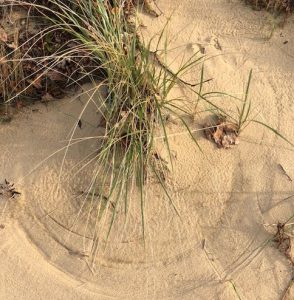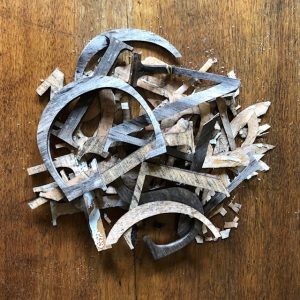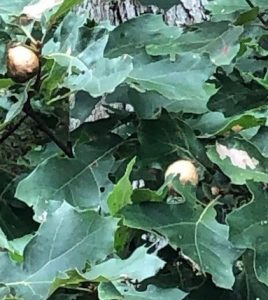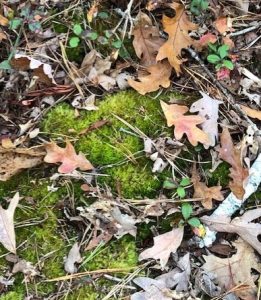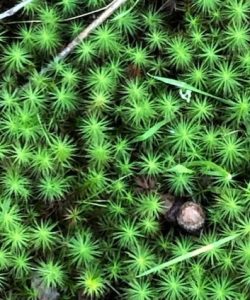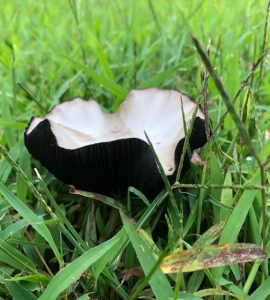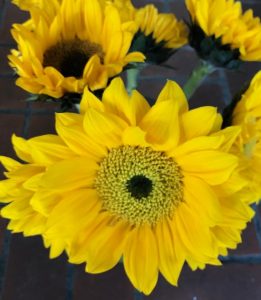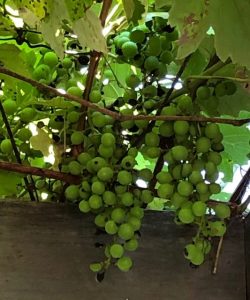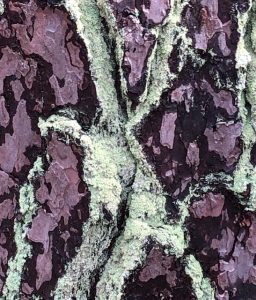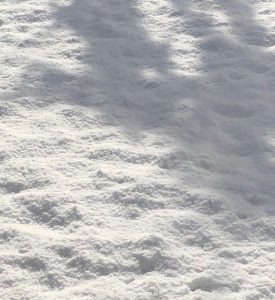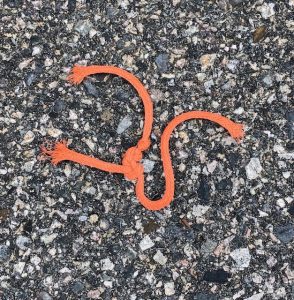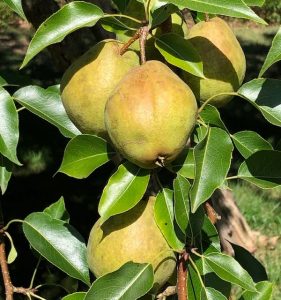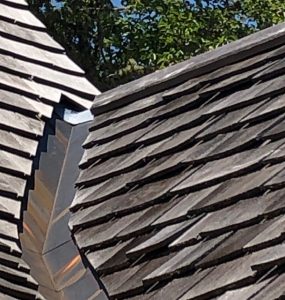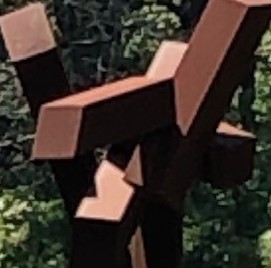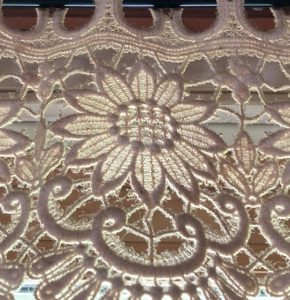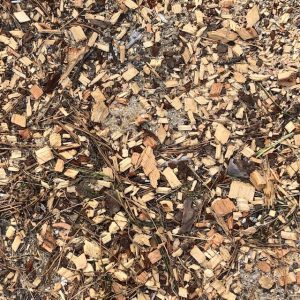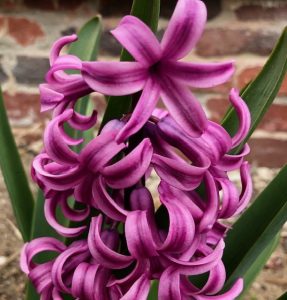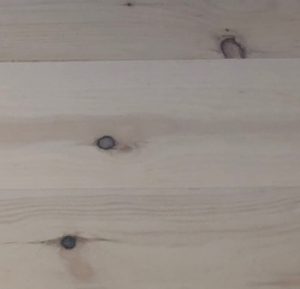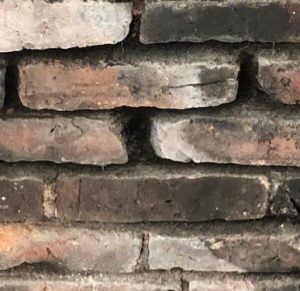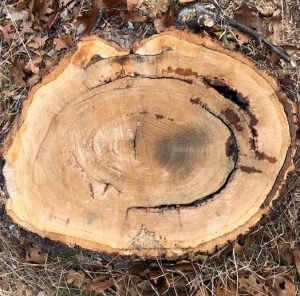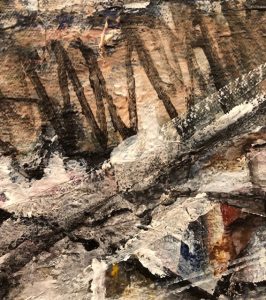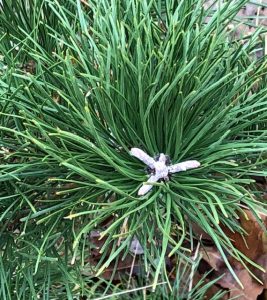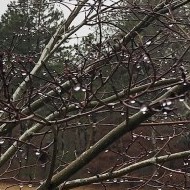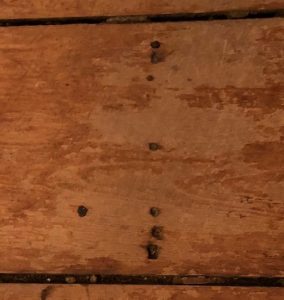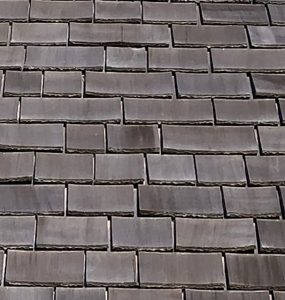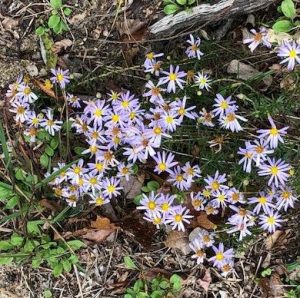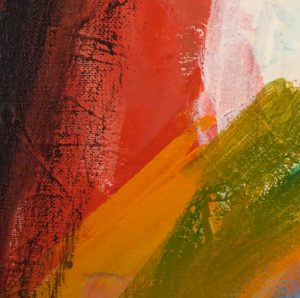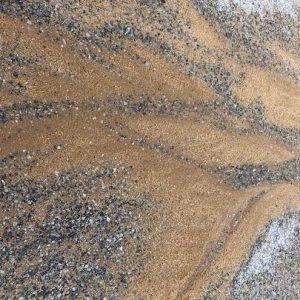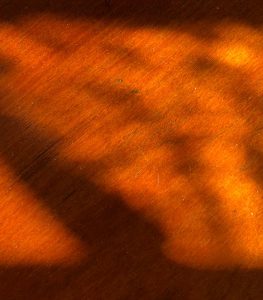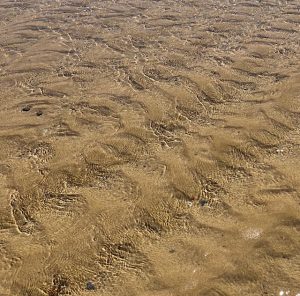DECEMBER
Following up on our October post, we’d like to add something to the matter of Provincetown’s Forum 24. Reconsidering the summer’s offering, we’ve come to realize an extraordinary absence: Robert Motherwell.
Motherwell was a driving force, as well as an important presence, at the original Forum 49. The lecture he gave that August, ““Reflections on Painting Now” was originally titled “French Art vs. U.S. Art Today.” Its publication in a Samuel Kootz gallery catalogue the same year became a kind of rallying cry for the formation of the so-called “New York School” of poetry and painting, a title that began in jest, slyly mocking the then-dominant “Paris School.” That alone would make Motherwell’s lecture “world historical,” and something worth Provincetown laying claim to.
Motherwell was also part of the group that formed the influential “Eighth Street” Club as well as, some twenty years later, the Fine Arts Work Center. The exact history of both organizations is subject to various versions of their histories (this depends on the artistic or familial genealogy of the historian-storyteller), but no one argues that Motherwell wasn’t present at the creation of both. The formation of the co-operative Long Point Gallery in 1977 chronologically falls somewhere in between the two. The gallery closed in 1998, seven years after Motherwell’s death and just eight years before the first Forum revisiting in 1999. Off the record, it has been admitted to us that the enterprise was essentially floated by Motherwell. (The gallery price lists and account books available at the Archives of American Art confirm this.)
Yet at Forum 24 event, we heard no mention of Motherwell. This seemed particularly strange, given this summer’s the Renate Ponsold Motherwell Estate’s extremely generous gifts to PAAM, to FAWC and to Provincetown Arts magazine.
Apparently, Motherwell first bought Provincetown property with his second wife Helen Frankenthaler in 1962, sometime after his daughters, Jeannie and Lise, were born. The sisters form a continuation of his legacy: Jeannie is herself a serious artist showing in Provincetown galleries and the retired psychologist Lise serves as current President of the PAAM board of trustees. Lise co-created two PAAM shows: One in 2012 of her father’s work was titled “Beside the Seas,” which the 2018 show of her stepmother Frankenthaler was titled “Abstract Climates.” They were both great, exactly the kind of shows we’d love to see PAAM present more of. She was rightly given the 2024 Stewart J. Tabakin Award for Extraordinary Support of the Arts & Artists.
But we’ve noted a certain silence about Motherwell in local circles, though we haven’t been able to pinpoint the source of the resistance. Does he seem too elite? Is he too white? Is his name too attached to the market of high art? We suspect many here don’t consider him “local” enough. He and his associates were certainly internationalists (in numerous senses of the word), a fact confirmed most recently by the important Frankenthaler show at the Palazzo Strozzi in Florence.
Motherwell himself was one of the most literate of painters; studied philosophy first at Stanford, then at Harvard. Hannah Arendt is said to have been invited to some of The Club lectures in NYC; we’d propose Motherwell (along with composer Stefan Wolpe) had something to do with that. Here’s the opening from his Forum 49 talk: “Philosophers often talk about the so-called “subject-object” relationship… [Yet]a painter, in working a canvas, sensing it all over, watching it shift and change and slowly emerge from its flat void, mere extension, may have the illusion that the picture is not being painted by him, but is rather painting him, that he who is supposed to be the subject has become the object, that the picture knows him better than he knows it…”
Not originally from the Eastern seaboard, Motherwell grew up in California. He studied modernist literature and philosophy at Stanford before going to Harvard (he made a pact with his father to get a PhD). At the suggestion of composer Arthur Berger (whom he met in Paris but who also had Cape connections,) after Harvard he studied with Meyer Schapiro at Columbia. Highly influenced by Surrealism, he spent time in Mexico with Roberto Matta. All this led to Abstract Expressionism, a stint teaching at Black Mountain (where Wolpe was in charge of music studies) and then back to Cape Cod.
All this should be enough for a more than mention in a Provincetown Independent article about PAAM’s Forum 24 exhibition. At the very least, there should have been a panel on Motherwell and his ongoing legacy in town. “Motherwell and Music” would have also made a great panel. How fantastic would it have been if musicians from the Cape Cod Symphony had been invited to perform Alban Berg’s string quartet, the inspiration for his 1965 Lyric Suite series!
But instead of internationalism we had provincialism, perhaps due to the sponsorship of the present Provincetown Art Gallery Association. To be blunt, despite some notable exceptions (Schoolhouse Gallery, in particular), the current set of Provincetown galleries is pretty uninspiring. Certainly the present art scene hardly compares to the era of the Long Point gallery. Perhaps the estates of others shown there (though a few artists, like Paul Resika and Carmen Cicero, are still living) feel overshadowed by the Motherwell legacy?
In any case, for us the ultimate query to be answered is not only what is an artist, but who is the artist? This is not a question of “identity politics.” It is, as Motherwell explained in 1949, up to the work of art to inform us: “Painting itself [tells the artist] what to do, so to speak, and in so doing, [gives] him his identity.” John Russell, quoted in Motherwell’s NYT obituary, makes a related observation in 1985, one few would dare print these days:
“Not for him the contaminations of popular culture or the wish to get clear once and for all of criteria first formulated in Europe. In his writing, his teaching and his conversation, he has kept open a direct line to the European past, no matter whether the great spirits under discussion are Velazquez or Piero della Francesca, Mozart or Mallarme, Goya or Baudelaire. And if he seems to see himself not only as the admirer of these people, but also their peer, it is for the work to justify that idea, rather than for the artist to repress it.”
NOVEMBER
Although we are told it isn’t the end of the world, it certainly looks like it for anyone with distance vision. The election feels like the foreshadowing of not just the end of 2024, but a lot else. There was nothing wrong with the candidate Kamala Harris (there is no perfect candidate), just as there was little wrong with how the campaign was handled. Ultimately, the fault, mangling Shakespeare, was not in our political system but in ourselves. There were forces so far beyond the control of the electorate, it’s hard to disentangle exactly how it happened. Exit polls tell us nothing except the nature of the delusion that caused this to happen. Using the analogy of AI error, it was all caused by a hallucination, widespread and unshakable belief in untruths.
Democrats, who tend to myopia, have nothing to apologize for. We can be proud of our good intentions and heartfelt effort. But while there’s nothing like 20/20 hindsight, we at LNB feel that if we had somehow known we were going to lose, we would have lost with even more honor. If we could do it again, we could have come out right away on the issue of gender justice, even it that would have meant a greater loss in the vote tally.
Specifically, the Democrats should have had the word “trans” (not just T at the end of a set of other letters) in their convention platform, and they should have spoken it loudly and often. They should have had trans performers at their rallies. As a result, the Democrats would have created an even wider platform of civil rights, expanding on those of women and of Americans of color. And who knows? Maybe young peoples’ votes would have made the difference.
We know there was a lot of LGBTQ money supporting the Democrats, but that community is still sometimes equivocal on the matter of trans identity. There’s a generational gap between those who struggled in the Stonewall era and younger voters for whom being nonbinary is completely normalized. That’s a gap that needs to be closed, and not just for political purposes. To be cynical, we sometimes feel that now that wealthy gay citizens are treated as upstanding members of the community, they’ve become the social conservatives with whom they once found themselves opposed.
That has to change. Democrats have to become even more fearless and socially radical. It’s easy to mock “woke” culture (we do it ourselves), but wokeness per se is not the problem. From a practical point of view, all the advances in the matter of DEI will soon be set out on the sidewalk. So instead of advancing that cause, our present task is to hold the line. The important presence of artists of color, as just one example, has been intelligently voiced, yet the reasons why the culture is better off as a result of such contributions aren’t being made adequately with any intellectual and moral consistency. Feminism fares little better. This is essentially a failure of cultural criticism — the fault of a generation born since 1950.
Instead, we say, let’s shake the bushes and bring the sexists, racists and homophobes out into the sunlight. The experience of art is above all a matter of paying attention, of looking and listening. And we are going to have a good look at some dark and scary places. For if we truly believe in the power of art, there is much to be done. We’ve said it before and we say it again: The Outer Cape, and Provincetown in particular, has an important role to play in the history of our democracy. Despite the assassination of Julius Caesar, Rome went from a Republic to being ruled by an Emperor in the course of a generation, and we’re seeing it happen again. Sure, the golden age of Augustus was good for the elites, just as for people of means (even Outer Cape Democrats), the Trump/Vance administration won’t be so bad. For a short while, we’ll enjoy a surge on Wall Street. And then we’ll buckle down behind our newly installed security systems and watch the fires from afar.
OCTOBER
The midcentury modernist impulse was the opposite of provincialism. Conceived by the poet Weldon Kees, Provincetown’s Forum 49 presented an extraordinary array of painters, writers and thinkers. It addressed international issues such as the Soviet bureaucracy, the architecture of Marcel Breuer and James Joyce. The names of those involved are remarkable: Hofmann, Gottlieb, Chermayeff, Kepes, Knaths, Motherwell, Nemerov, Macdonald, et al. The event placed Provincetown on the cultural map as a locus of artistic ferment.
And while provincial was the last thing the highly sophisticated Forum 49 was, this quality exactly summarizes our issue with this past summer’s Forum 24, a series of offferings conceived to celebrate the 75th anniversary of the original event. Put together by the Provincetown Art Gallery Association, the updated version remained resolutely local in its topics and presenters. Essentially it was a promotion of local institutions such as PAAM, the Center for Coastal Studies, the Cape Cod Modernist Trust, Provincetown Community Compace and, above all, local galleries.
A set of works curated by the Forum 24 organizers was brought up from PAAM’s basement. These were not necessarily works of artists involved in the original Forum 49 but art dating from 1949. But as even these were not the selected artists’ best works, the show failed to show how extraordinary and influential the original event was. The associated members’ juried show, exhibiting contemporary works purportedly influenced by Forum 49 (and here we are forced to use the phrase, “the usual suspects”) was comparably uninspired.
We didn’t attend all the Forum offerings. The one we were most dubious about was the Ryan Landry-hosted “Everyone’s Forum,” whose description suggested a free-for-all at which anyone might ask questions or offer opinions. (The 49 event did have a quite different closing “Everybody’s Forum,” with panelists returning to recap at its close.) Given our experience of other events, we were particularly dubious about the value of offering audience members time at the mic.
Among the events we did attend was a panel ”Art and Endangered Species” at the Center for Coastal Studies. Much of the presentation was not without interest, but we had trouble connecting any of it to the original Forum’s conception. It was certainly there, especially in terms of the international significance of climate change and oceanographic research, but it remained unarticulated. We also had difficulty figuring out what a screening of Surrealist short films had to do with the either Forum’s intentions, even while the presented works themselves were fascinating.
In fact, there was little real reference made to — or expressed understanding of— the original event. There was, however, lots of misinformation by current organizers about Provincetown art history. We encountered bloopers such as the statement that Mary Heaton Vorse was a visual artist. We heard that there were no women at Forum 49 ( I guess Helen Levitt and Blanche Lazzell don’t count). We were told Jackson Pollock had been actively involved.
But for us the most distressing and inadequate event was the “What is an Artist?” panel at PAAM. Run by the affable Mike Carroll (Schoolhouse Gallery), the panel presented two artists and two curators/art writers. The “post-medium” feminist artist Mira Schor opened by declaring she was herself in a position to decide whether someone was an artist (it would seem by her given example) just by the force of her personal taste and opinion.
The event was set in a ludicrous context. In the PAAM side gallery, the audience was surrounded by glossy oversized images, “Artists of Provincetown,” taken by the photographer Ron Amato. These subjects included town characters as much as creators, with each subject clearly pleased with him or herself. The walls presented a superficial answer to the question at hand: A Provincetown artist is someone photographed by Ron Amato. There was an audience question about “boundaries,” focusing on what distinguishes the maker of “artistic” objects from an artist (the topic of Schor’s anecdote). The question implicated the unspoken issue of the volume of art presented in Provincetown venues: There is just so damn much of it. And this implied an additional question, what do you make of the 12×12 members being exhibited in the big room next door? There are literally hundreds and hundreds of creators, but how many of these are artists?
Later in the summer w attended a poetry reading entitled ”The Lost Edge of Bohemia.” First of all, there was no mention of the Forum 49 organizer, the poet Weldon Kees. This seemed to us an extraordinary oversight. It’s not like Kees’s involvement is unknown territory, given that Jennifer Liese in the current Provincetown Arts returned to the subject of her doctoral thesis on the 1949 Forum. In fact, it was at Lieses’s instigation that the the 50-year anniversary Forum took place; Forum 99 was linked to her editing of the magazine’s 1999 issue. Did none of the panelist or organizers either of read these?
Secondly, half the reading’s discussion involved participants trying to decide “What is a Bohemian?” Not surprisingly, no resolution was arrived at. And only a bit of poetry (and here we’re not judging, just observing genre) was read. Eileen Myles read from a novel. Oona Patrick presented a prose recollection. We loved the trans reader Mackenzie. But we were most happy to be introduced to the work of Sal Randolph and hear a couple of real poems. Why have we never come across Sal Randolph before? We are now paying attention.
So here’s our summer take-away: Those called upon to talk about the Forum 49 “legacy” simply didn’t get it. Does this say something about the fading of Provincetown’s cultural importance? We think not. At the moment, Provincetown’s significance has most to do with Queer culture, not a minor thread in the history of American art. And obviously the matter is not unrelated to issues of politics, feminist and other. The fifties were a turning point, and Provincetown was one center for the shift. How all this has come to the cultural forefront (and not just in America) would have been a good subject for an “updated” forum panel.
Besides the gifted Randolph, there were additional exceptions to the self-serving mediocrity of the participants. There was Mark Adams at the Center for Coastal Studies event, elegantly displaying how nature intertwines with culture with a literal “mapping” of the timelines of geological change and cultural development. Adams is talented, informed and articulate. His presentation overlapped with his obituary for fisherman Paul Tasha in this summer’s Provincetown Arts, a well-written remembrance in which he recalled Tasha asking about the Dune Shack lottery’s preferential treatment of working artists. Tasha reasonably inquired of Adams, “What’s so special about artists?”
It’a a good question, as well as one worth answering. And it really shouldn’t be all that hard. But the “What is an Artist?” panel provided little response, save something along the lines of “you know it when you see it.” In order to formulate a definition, of course, you have to really believe in the importance of the arts, and not just on a personal level. “It’s what I am, therefore we need to promote my source of livelihood” was basically the response for most of this summer’s Forum participants.
Full disclosure: Early on we volunteered to contribute to a panel or reading but were ghosted by Forum 24’s organizers. And so while there may be an element of sour grapes to our criticisms, trust us when we say that overall the season’s fruit was not suitable for consumption. And so on the unanswered question of “What is an artist?” we here provide our own definition, the harvest of our own beliefs and experience:
An artist is person whose life-long vocation (not late-life hobby or commercial profession) is to advocate for the life of the spirit through acts of creation, acknowledging that spirit manifests not just in persons but in nature. The media of art is vast: visual, mobile, tactile, spatial, acoustic and linguistic. Such artistic advocacy is both a task of memory (what we call the past or tradition) as well as a job for the imagination (what we call the future or idealization). Art also celebrates our present in acts of education, teaching by example the experience of individual attention.
Art reminds us of the soulful aspirations and activities of our planet’s predecessors; it becomes political when acts of imagination (such as the idea of democracy) find expression in consciously enacted social behaviors. This is the meaning of Shelley’s declaration that it is poets who are the human race’s true legislators. Because of this crucial role of the arts in a healthy society, as with the traditional village shaman, the artist’s ability to perform their purposes must be supported and protected by the community.
Despite gentrification, the Outer Cape community’s continued conviction in this shared truth is what makes Provincetown “the country’s first artist colony” and contemporary haven for artistic creativity so special. The free expression of gender as a civil right is only one example of how the arts and politics overlap, of how Provincetown has led the progressive way forward. Whether our presence (let alone our ongoing contribution to the community’s artistic legacy) is acknowledged or not, we at LongNookBooks remain deeply grateful for our home ground. We know how fortunate we have been to live here year-round for more than twenty-six years.
SEPTEMBER
On the subject of staycations, this fall we resumed our habit of staying at a rented house supported by the Cape Cod Modernist Trust. We are asked, and we therefore come to ask ourselves, why do we do this, as these home are are only ten or fifteen minutes away from Longnook? Our answer is that we do it because although it is quite close (especially as the crow flies), it provides an architectural experience (we would say nearly an escape) worlds away from our traditional hollow-tucked farmhouse.
Architecture is too often thought of as the way buildings look from the outside, how they relate to their social context. And it is true that architecture is closely connected to urbanity. The city apartment continues to project itself as a marker of social identity; its location especially reflects not only financial status but also other markers such as education and ethnicity. We no longer live just above Washington Square, but in some sense it remains our neighborhood. Psychically speaking, we belong in what used to be the West Village. It’s still how we think of ourselves, even though when we find ourselves there now, we hardly feel “at home.” The neighborhood is filled with much wealthier residents than it use to, for one thing. But then, for that matter, that’s equally true for the Outer Cape.
But for us, whether we find ourselves in town or in the country, in large part our experience of space is that of pedestrians. The New York walk takes place on paved streets, whereas here it’s the dirt road and the deer path. In the city we walk outside and ponder the placement of buildings, marvel at the forest-like canyons created by skyscrapers. On the Cape, we encounter the homes of neighborly wildlife, the complex structures of birds and burrowing creatures.
For we humans, Cape modernist architecture redefined the idea of interior and exterior, so that the porch (enclosed or not) became a kind of liminal area, something between nature and culture. The way a modernist building creates a set of semi-outdoor rooms was something hardly revolutionary in the history of landscaping, of course. The garden follies of European palaces are very much an extension of the royal suites, for example. Yet the way the houses rented out by the Cape Cod Modernist trust are set in their landscapes is an experience very different from the colonial farm enclosure.
This is obviously a seasonal issue. The early settlers wanted protection from the elements. They got enough of nature from their work as farmers or fishermen. Set within the security of the hollow, they hunkered down in front of their fireplaces in the winter. There are, of course, a number of colonial-era properties on Bound Brook. The Biddle estate, just down the road from where we stayed, is now owned by the National Seashore. While uninhabited, it is a charming cluster of buildings that evidently once provided abodes for humans and domestic animals, a turnstile for livestock still in place.
Modern summer homes, by contrast, are really about being outside and heading to various bodies of water for sun, boating and swimming. They’re for recreation not physical labor. Whether set on the bay, the oceanside or in the ponds, water access is part of the deal. Decoration is beautifully simple and intentionally practical. Floors are bare for the most part. Big windows without grill or muntin further soften the distinction between house and flora. Now that most postwar American suburban homes have incorporated so much of modernist design, all this doesn’t seem all that remarkable anymore. The open kitchen, the floor to ceiling living room window, the outdoor deck, the screened-in porch — what’s the big deal?
It’s all very familiar, but it’s certainly not our Longnook house. Perhaps what we most enjoy as renters is a kind of freedom from a particular kind of seaside ownership. We don’t need to worry constantly about the flooding of Bound Brook and the regular road closures. We don’t have to worry about heavy snow and access on unplowed back roads. We don’t have to ponder the damage to our life savings from a random tsunami. We admit we really enjoy this completely different experience, temporarily free from such structures’ home-ownership worries — concerns quite different from the endless upkeep of an antique home.
Some of these CCMHT rentals are the work of local architectural celebrities, the ubiquitous Charles Zehnder, as one example. And as we’ve written before, there’s Jack Hall and there’s Jack Phillips. (Some have confessed to us they thought the two Jacks were the same person.) The spine of Route 6 marks their territories, as in general the ocean side and ponds belong to Phillips; Bound Brook and bayside is Hall’s neighborhood. While we wouldn’t dismiss either (Hall’s Hatch House is a masterpiece), they were both essentially Ivy-League educated, well-heeled amateurs whose relatives and descendants are still very much around.
This background distinguishes them from the professional European émigrés associated with MIT and Harvard’s School of Design. In light of this second tradition, the Cape Cod Modernist Trust’s purchase and renovation of the Marcel Breuer house is a very big deal. Breuer and and his neighbor György Kepes are important figures not just locally but internationally. The narrative of those in the world of art and design who came to visit Breuer (Alexander Calder, among others) is a fascinating (and generally unrecorded) piece of cultural history. For our rented window seats on this extraordinary story, we at LongNookBooks are very happy to support CCMT’s endeavors.
AUGUST
We were tempted to take an August vacation from the LONGNOOK LOOKOVER this summer. But then our memories of urban Europe in August came back, its cities emptied of natives and full of loud tourists. It seemed better to take the opportunity to celebrate where we are. We wholeheartedly advocate the idea of a staycation, which we find ourselves taking happy advantage of this year. After all, not only are we surrounded by the beaches and hiking paths of the National Seashore, short drives just beyond take us to a whole new set of landscapes and experiences farther afield. But the truth is, most informed visitors want to be right here on the Outer Cape. We don’t want to sound smug, but there it is.
There are some downsides. The PAN MASS challenge, the traditional start to August, no longer goes by the end of our road. But given the closing of Longnook Beach, the road has become even more popular with runners and cyclists. We now live on a bike path.
Which brings us to the subject of Route 6 traffic, a regular source of lament from year-rounders. We have to wait a very long time to pull out of our road onto the Orleans-Provincetown highway. And this is in addition the perilousness of summer Saturday morning at the Truro post office, with fender-benders (observed or experienced) nearly inevitable.
Of course, the secret for those with an off-road vehicle are our back roads, particularly the Old King’s Highway. Just over the hill from us at the old Air Force base, as we’ve mentioned before, is the Payomet Performing Arts Center. Our gratitude for the community’s good fortune at the events tendered by Kevin Rice and his staff is shared by many. The Payomet presents incredible live music at incredibly reasonable prices. We were especially charmed by the young “local” up-and-coming Ella Mae Dixon, energetically singing the American Songbook with skill and insight.
And then there was an evening with internationally renowned John Pizzarelli Trio. Pianist Isaiah J. Thompson left us breathless. Frankly, we couldn’t believe that only a stone’s throw from our house was happening one of the best evenings of musical entertainment we could recall. We know from experience the cost of the Cafe Carlyle where Pizzarelli regularly performs, so we’re well aware we had quite a deal.
And we’ve taken full advantage of weekend gallery nights in Wellfleet and Provincetown. We’ve also enjoyed a number of visiting writers and political observers giving talks and interviews. There have been fundraisers with intellectual and cultural celebrities at fun locations like the Pilgrim Monument or the restored Mary Heaton Vorse house.
Some of these stimulating individuals may also be found at parties given by our friends at their beautiful homes, some at properties hidden away in that paradise known only vaguely as “the ponds.” No matter how many times we drive those mazelike back roads, we’re never exactly sure where we are or how to get back to Route 6. But for those who have homes there, why would one want leave? We feel that way about the Outer Cape in August: Under the circumstances, why should we go away?
But when we do want to “get away,” we can go just down the main road beyond Orleans and head to another world in Harwich and Chatham. Here are other luxurious options for an overnight staycation, ones that present a very different, more traditional Cape Cod. There’s the family-friendly town of Chatham with its Main Street candy store. As parents, we especially appreciated its New Year’s Eve “First Night.” For this, the town is a great option. Or as we often say to ourselves, we love to visit Chatham in order to appreciate that we don’t live in such a straight-laced place.
But it does have its attractions. There is, for example, the porch veranda at the Chatham Bars Inn. For this, we put up with the hotel’s Waspy country club feel, its golf and tennis always in view. But there is a pool with immediate view of the ocean, as well as an excellent spa with its own outdoor pool and hot tub. At the Inn’s beachside Beach Club, we enjoyed a really terrific upscale “clambake” meal featuring their new house rosé. And in Brewster, there’s the Chatham Bars Farm, a ridiculously expensive but excellent farm stand offering equally excellent (and expensive) farm to table dinners, served family style. We’ve both attended one held outdoors, and one in the greenhouse in the cold of early winter.
There’s also The Weqauasset on Harwich’s Pleasant Bay, halfway between Chatham and Orleans. This resort has a more urban, distinctly urbane vibe. It is a more sophisticated setup, with all the accoutrements of the Chatham Bars, but with a more contemporary style: It also has great pools, fun poolside cocktails, as well as boats (sailboats and yachts) to take you out on the water. We really enjoyed a “Supper on the Bay,” long tables with excellent food and drink set out on a grass terrace with incredible view and live music.
The Wequasset also presents music events of different kinds served with buffet dinner during its “Jazz Festival.” On one really fabulous evening, we were entertained by the seemingly ubiquitous (PBS Mystery, et al.) Alan Cumming, wonderfully out of his usual Provincetown element. He wore a Scots kilt with muscle Y and talked a lot about penises during his patter. The Harwich audience was clearly not all perfectly comfortable, but, of course, we felt like we were back home in Provincetown. Alan is a bold lad and we admire him.
For the truth is, that although Provincetown is only ten minutes away, it takes something extraordinary for us to be willing to deal with its pedestrian crowds on an August evening. Parking at a resort, for one banal yet not wholly irrelevant thing, is a whole lot easier. Yet something extraordinary would describe the Taylor Mac at Town Hall, whose Machine-Dazzled genius really deserves its own month of gushing.
The relation of Mac (preferred pronoun of “Judy”) to Provincetown is not an uncommon history. Like so many others, as a young person Mac got by with seasonal jobs, finding drag the only venue at which he was welcomed. (In this, the performer is much like other “cottage boys,” coming by ferry for the weekend, sleeping on someone’s couch, working in town as a cleaner or server.) Mac is very funny on the town’s housing issues, recalling sleeping in the back of a van. “Get a tent!” was advised to young complainers. Though Mac now considers Provincetown his retreat from work, this special event was full of local reference (about the Boatslip, the Dick Dock, etc). Mac’s return to town was both hilarious and poignant. We were profoundly grateful for Judy’s exception to his own Ptown vacation-only rule.
For Mac’s particular expression of drag as “affectionate critique” is something we value quite highly. While a healthy LGBTQ community was not one of the reasons we moved to the Outer Cape, its nearby existence has become for us, rather unexpectedly, a political and emotional touchstone. That community has, of course, only become increasingly significant in the last twenty-five years. Its reassessment of the idea of both group and individual civil rights extends far beyond those who identify as queer. Mac’s audience participation exercises are something more than entertainment. They are throwbacks to the sixties’ forms of group consciousness-raising. Mac’s performance confirmed our belief that certain aspects of drag — which might be seen as a subset or offshoot of what we once narrowly thought of queerness — provide a supreme example of bemusedly barbed and joyously sequin-sparkled lovingkindness.
JULY
The exact middle of the month was a scary moment. The summer’s beginning had brought the reality of climate change to our road with further collapse of the dunes at Longnook. Beach access was closed to cars, with cement blocks set up to prevent parking; new split rail was put up at the ocean overlook to discourage any descent down. It was not an unreasonable move. Boulders threatened to fall at either sides’ dune edges, scary iron pins projecting outward. An old blacktop road had already collapsed years ago, with parts of a cottage colony (or perhaps remnants of an air force base) rolling down and landing on the beach. So the closure was hardly a surprise; the wearing away of shorelines had long been a sure but slow process.
Among other things, the summer’s traditional Longnook volleyball game had to move elsewhere. But then, perhaps it is only with imminent danger or inconvenience that global warming becomes real. Above other oceanside and bay beaches, houses have been moved back at great expense. Roads and bridges’ flooding at Bound Brook have recently brought inconvenience as well mosquitoes. Mid-July evening activities brought the imminent possibility of new plagues — not just evolving forms of Covid, but tick-borne illnesses, encephalitis and even dengue fever. Climate change’s inevitability could no longer be seen as prophecy but scientific actuality.
And then the ex-President “miraculously” survived an assassination attempt and chose faux-Appalachian J.D. Vance as his Vice President at the Republican convention. Things were looking very bad. It was time to rally.
And so we enthusiastically attended the July 20 fundraiser for the Biden-Harris ticket at the Pilgrim Monument (in V-P Town, as the event presented itself in honor of speaker Kamala Harris). There we heard from Democratic big-hitters Boston Mayor Michelle Wu, Governor Maura Healy, Senator Ed Markey, as well as Chasten and Pete Buttigieg. As far as the entertainment world, the very popular Massachusetts-born Jennifer Coolidge comically killed it —rather than being “killed by the gays,” as her character memorably declared on White Lotus. But obviously we were there to hear Kamala. And heard we did. As familiar faces of the national press poured in next to us under the tent, we had the distinct sense that something monumental was happening. We clapped. We cheered. We teared up when the Californian Harris quoted Harvey Milk: “Rights are won only by those who make their voices heard.”
And then the very next day it all turned. Biden bowed out of the race and endorsed Harris. For those of us who had just heard and been deeply impressed by her speech, we felt we had been present when our democracy dodged a bullet.
And so we entered the balance of the summer with cautious optimism. There was still the Democratic National Convention in Chicago as well as an election to be won. The Olympics proceeded along the reclaimed “beaches” of the Seine, even while on the Cape we have summer Covid outbreaks and weird lightening-strike weather. Knowing what comes next requires visiting one of Ptown’s psychics.
The month’s continued sense of imminent apocalyptic doom was for us perfectly captured by the Kahn and Selesnick installation in the back room at Schoolhouse Gallery. We’ve loved their work for years now, with both the doubter’s suspicion that their work might be complete nonsense as well as something of the believer’s sense that it carries some profound truth. Increasingly their cryptic work feels like message whose meanings and origins are for now beyond us — even while their messaging seems to be coming from some kind of true beyond. As they have described one of their projects, “Its goal is obfuscation, & through such means, to suggest the presence of a hidden world.”
Some of the publications created by the pair of artists that we have acquired include the book The City of Salt. We hardly know how to describe this. The lighting and elongated panoramic shape of its druggy images recall Maxfield Parrish, but what is the dramaturgy being performed by K&S’s Truppe Fledermaus? We don’t know; the dunes of Provincetown and the marshes of Wellfleet nevertheless appear to enter into it. Self-described as “fictitious histories”and “mythical topologies,” another imaginary theater (finding expression as well in a set of Goreyesque playing cards) is the “Iceberg Freestate.” Yet another oversized volume presents in misty black and white the postapocalyptic Scotlandfuturebog. Similarly weird and disturbing is the fold-out Apollo: A Prophecy, whose scenes take place on the moon.
The work is both fun and troubling, very much like an oracular game with consequences for the querent. And so, appropriately enough, we’ve also purchased two sets of K&S tarot cards with “guides” by Sarah Falkner. The first, Madam Lulu’s Book of Fate, is intended to accompany “The Carnival at the End of the World Tarot.” This set’s dramatis personae included three characters from the Fledermaus operetta, as well as three of K&S’s own creation: The Tempest, The Deluge, The Inferno. Vegetative images from the unbound pages found in One Hundred Views of the Drowning World (also to be shuffled and “read” as cards) equally adorn the more recent “Tarot of the Drowning World.” That pack has its own interpretive guide (for which Falkner alters the ominously present title to “Drowned”), a text in which Walter Benjamin is mentioned and Guy Debord found in its bibliography. Given such frames of reference, unsurprisingly this guide’s post-pandemic advisories press more immediately political: “Beware robotic actions and unfair labor practices!”
For us this midsummer, from a certain stressed perspective these created realities are no stranger than the one we call “real.” This season especially we felt ourselves surreally storm-tossed, tumbled as though a set of dice in an Earthwide game of chance. Would the planet’s turned card this summer be tornado, flood or wildfire? All three? In any case, the augury we ourselves drew from Doctor Falke’s Oraculum portentously read: “The lottery started long before the first of our ancestors crawled from the primordial sea onto the cruel earth.”
June
We’ve always loved the idea of train travel. The romance of it comes from books and movies, of course, rather than actual experience. Commuter trains figure in Cheever’s short stories, the Orient Express in Agatha Christie. In reality, for us European train travel has been usually fraught with anxieties about getting on the wrong line or forgetting to get off at the right stop. Luggage becomes larger and heavier when dragged down those narrow aisles. It does not make for a glamorous image. We will never forget an especially dreadful overnight spent in a couchette car from Venice to Paris.
Yet the American “Twentieth Century Limited” has haunted our imaginations for some time now. And so in early May we signed up for a Sunday ride along the Hudson to Albany on a lovingly restored version of the train, a special event sponsored by United Railroad Historical Society of New Jersey. Leaving from (what we still call) Penn Station, we waited for our late-morning departure in the new upstairs Metropolitan Lounge of the Moynihan Train Hall, seated alongside our future fellow passengers, some of them dressed up in forties attire (as we were all encouraged to do).
Down below, onto one of the station’s underground platforms, was spread a crimson carpet, especially laid our for us. As we were informed, the whole idea of “red carpet treatment” originally came from the Twentieth Century’s way of directing passengers to “the world’s most famous train” (an America-centric marketing exaggeration all too easy to disprove.) Only later did the red carpet become synonymous with movie awards, premieres, and now, fashion pre-events, such as at the Met Costume Gala.
Two special railway carriages (originally part of the New York Central system) were attached to the end of Amtrak’s regular Empire Service. The Hickory Creek observation coach was designed by Henry Dreyfus in 1948. In that car, a sit-down three-course lunch was served by period-dressed waitstaff, tables arranged in front of the oversized windows. We ourselves rode in the Tavern Lounge No. 43, built in 1947, sat in a retro banquette, ate excellent sandwiches from a buffet and brought our own beverage of choice, which was chilled in an ice bucket provided by the friendly and efficient staff. We kept the cool coasters as souvenirs.
Both cars retain many of their original details: light fixtures, movable armchairs and Art Deco carpeting. Along with us in the lounge rode a guide from the National Park Service’s Trails & Rails program (set out in her timeless khaki ranger uniform) who told us all about what was passing by. We were given maps and shown old photographs. There was a bit of Hudson Valley history, a bit of geographical description, and a lot of contribution by our fellow passengers. Everyone, it seemed, had a story to tell or a personal recollection. “Club-like sociability” reigned.
From time to time we stopped at the familiar Amtrak stations, while “real” commuters got on or off. It was quite amazing how much development has taken place alongside the river in recent decades — waterside restaurants, waterview apartments, as well as boat docks and parks. And then there were whole stretches of nothing much save for hills and water and the occasional lighthouse. There were fascinating abandoned buildings on tiny islands. There were abandoned fishing shacks. It wasn’t thrilling by any means, especially the layover in Albany, but it was an enjoyable afternoon.
When we got back to the Cape, we revisited the three classic movies that had motivated us to take the ride. On the Twentieth Century was originally a 1932 Ben Hecht-Charles MacArthur stage play; this was made into the Hollywood movie, Twentieth Century, two years later. Directed by Howard Hawks, with a screenplay by Herman Mankiewicz, it remains one of the very best screwball comedies — due in large part to stars Carole Lombard and the truly great John Barrymore. High hysteria and high hilarity culminate in a train compartment proposal, with its punchline offer of Lombard’s “Lily Garland” performing as Mary Magdalene in The Passion Play. This absurdity caused real problems with the Breen office. The film contains so much that should be cringey, yet is so full of ethnic and racial stereotypes, that somehow it sort of evens out.
On our own train trip, we had a peek into a vintage Pullman car in the Hickory Creek section, one pull-down bunk bed set above the other. These, of course, brought to mind Alfred Hitchcock’s 1959 North by Northwest, with its racy, yet also strangely awkward, leading-to-overnight clinch between Cary Grant and Eva Marie Saint. Grant, as viewers will recall, is hidden in the overhead berth to escape the clutches of James Mason. (As an aside, we couldn’t help but think that Mad Men’s Don Draper owes more than a little something to Cary Grant’s Madison Avenue swagger at the opening of the movie.) As adman “Roger Thornhill” is followed onto the train at Grand Central, we catch a glimpse of the famous red carpet. And as he comes out of hiding from the train’s toilet, we can see the club car and its familiar (to us) arm chairs. Because that New York to Chicago train was still running in 1959, Hitchcock’s famous morning-after tracking shot at Chicago’s LaSalle Street station (with Grant dressed as a Red Cap carrying the Eve Kendall’s luggage) was shot on location and so was accurate in its depiction of the Twentieth’s Century’s arrival in Chicago.
This isn’t the case with George Roy Hill’s 1973 The Sting, a “period” movie in which the Twentieth Century from New York arrives at night. Yet the poker scenes in the movie do capture the claustrophobic (recreated) train compartments and narrow windowed aisles. The timed parameters of the cinematic trip, with a cheating Paul Newman setting up the con against the cheater Robert Shaw, is still fun to watch. But it feels really inauthentic, like a bunch of contemporary people dressed up for a thirties-themed event; it comes across as well-planned a costume party (and in this, it is not unlike some of our fellow passengers in their fedoras and costume jewelry). Robert Redford’s very modern hair and newsboy cap are meant to make him look younger, as his character is supposed to be a “kid,” but it doesn’t fool anybody. Robert Shaw can’t help but sneer.
Still, it’s humbling for us to realize that less than forty years had passed between the purported time of the drama (1936) and the time of the movie’s opening. More than fifty years have zipped by since then. Such are the illusions of art, not all of them fully successful. Yet we didn’t really question any of this when the much-lauded movie came out; we went along with the con on us. The illustrated act cards appearing onscreen, as in a burlesque house, telling us where we are in the con seemed stylish at the time. But in a way, that’s what the whole thing is about — a big winking pretend, with the hiring of “actors” to put on the big show as not just a way to make money, but as a form of personal vengeance.
An overnight ride on the Twentieth Century from New York to Chicago is still possible, though it quickly sells out. Or, by private charter you can rent a whole car or two. Both are available for rental (starting at $12,000 for a day trip), allowing for “a lavish, high-class experience of yesteryear.” The enterprise is being pitched to wealthy businessmen as a way of rewarding staff — or for the making of a unique honeymoon or themed vacation. In theory, one could recreate classic movie scenes with invited friends (or hired actors)! Certainly it would all be very cinematic, entering the tunnel out of Manhattan, then looking out the Hickory Creek observation car back to the lights of New York and New Jersey flickering on the water beneath the George Washington Bridge, all disappearing into a slow dissolve.
May
New York City had its Weimar moment this past season, largely due to Carnegie Hall’s extensive offerings under the heading “Fall of the Weimar Republic: Dancing on the Precipice.” That period is described on the Hall’s website as not only “one of the most complex and consequential chapters in human history” but also as an era of “astonishing cultural flourishing.”
The epoch is associated with a certain kind of experience that we ourselves certainly enjoy, a subversively progressive culture that once extended to Vienna. Belle Epoque and modernist decadence overlap in a style of life and art perfectly epitomized by New York’s Neue Galerie, to name one venue we especially appreciate. There can be found, as in a sort of time capsule, an especiallly elegant remnant of Viennese café culture; we even sometimes spy actual intellectuals and artists standing in the long lines outside in order to enjoy strudel and coffee, or excellent wiener schnitzl or paprikás with spätzle. One can even encounter cabaret culture at Café Sabarsky (a description of one of our own memorable evenings there may be found in the LOOKOVER Archive: 6/9/17).
But the hottest cabaret ticket of the moment is for Broadway’s Kit-Kat club, the very latest incarnation of Cabaret starring the supremely professional Eddie Redmayne. His performance has a sickening mechanical pull, with both centrifugal and centripetal forces applying concomitant attraction and repulsion. Despite this undenibly strong center, the show was ultimately quite disappointing, largely as a result of a weird re-writing of Christopher Isherwoord’s personal/fictional experience. We especially hated the addition of a sappy subtext of elder romance.
It was all kind of weird, and not in a good way: A play about a nightclub turned into a nightclub experience, complete with ID checks and stamped hands at the door. Alcohol (some form of schnapps we were informed) was offered gratis; other options were served at intermission as well as throughout the performance, though neither really improved the experience. And while we ourselves were not especially entertained by pre-theater dance and mime, delighted theatergoers at one of the theater’s three created bars were heard to exclaim:“It’s just like Weimar Germany!”
Far off Broadway, down on the Lower East Side, there was as much better and more authentic-feeling — literally “underground” — cabaret offered at “Tiergarten,” presented by Death of Classical creator Andrew Ousley. “In recent years,” he writes, “ I’ve developed a fascination for the moments in human history when the collective weight of our individual decisions either tipped humanity in to darkness, or turned us toward something greater.” Tiergarten’s master of ceremonies was the gorgeous Kim David Smith, joking about similarities to the current political climate while wearing glittered lips and a matching sequined outfit. The program was a fecund mix of chamber opera, Kurt Weill and Rocky Horror Picture Show. Ousley’s take on “the zealous piety of the mob that both murdered and immortalized Jesus” found expression in the both hilarious and heartrending spiritual, “Were You There?” As Metropolitan Opera star-in-the-making Aaron Reeder sang its plangent and profoundly moving words, the burlesque performer Peals Daily stripper — done up like a bearded Jesus, performed a sort of Dance of the Seven Veils.
Comparably wonderful was Taylor Mac’s Orlando at the Signature Theater which, while slow to get off the ground, achieved after intermission the joyous emotional chaos of Charles Ludlum’s Ridiculous Theater. We have no higher praise for a performance. Written by Sarah Ruhl, the Virginia Woolf adaptation confirmed our sense that Trans theater has not only been around for a very long time, but pairs perfectly with the Elizabethan ethos — what with Shakespeare’s women originally played by male actors and all that. Lisa Kron also deserves a special shout-out, bringing out the heights of Mac’s stratosperic talents in paired hilarity. In short, Orlando was really fun and emotionally affirming — everything theater (and cabaret) should be.
Less successful though well-meaning was “Will There Still Be Singing: A Hanns Eisler Cabaret: at the Leo Baeck Institue. We were really up for this, being die-hard Eisler fans, a truly great musician easily the equal (and maybe even superior) to the fantastic Kurt Weill. The event was advertised as featuring Eisler’s collaborations with Bertolt Brecht, mostly in translations by Eric Bentley. Unfortunately the patter of soprano Karyn Levitt was a dumbing down of the composer’s career, with a somewhat cartoonish narrative that jumped from Weimar to America’s McCarthy era and back to East Germany. But Levitt did capture the Eisler’s genuine despair at being made to leave America, something about which die-hard Communists never liked to hear. Pianist Eric Ostling was informed and precise; guitarist Ira Siegal was supremely profession; but it was accordianist William Schimmel who was superbly Brechtian.
Eisler’s career came into being in the roaring twenties, which for Americans ended with the Depression. But in Germany, it was the assassination of foreign minister Walter Rathenau that led to the rise of the Nazi party. The just-left-of-center Rathenau insisted that Germany honor the Treaty of Versailles; this didn’t settle well with German chauvinism. Rathenau was in many respects ahead of his time; he was particularly outspoken about German treatment of native South African peoples. Progressive centrists have it hard, being hit with criticism (and sometime bullets) from all sides. We have not forgotten Yitzhak Rabin.
Thinking of Eisler, we cannot separate politics from art-making. But we find ourselves often uncomfortable with the way current event have invaded the arts. The present moment seems to think the way forward is resistance and demonstration — both honorable civil acts in and of themselves. We are somewhat surprised by our own oddly divided response to the Columbia encampments. While we are fully supportive of the protests, we remain troubled by its more destructive aspects —and we don’t just mean the occupation of Hamilton Hall. And while in principle we object to police intervention, we acknowledge that the institution’s primary responsibility to provide safe venues for the education of all students.
We have the nagging feeling that such events add to the demise of the humanities, a dissolution not unrelated to institutional collapse. For the literary community — which is in an active state of redefining itself — the push to accomodate a changing sense of political purpose has nearly brought down a number of the organizations created to support it. This is especially dramatic in relation to poetry. The current holding pattern of the 92nd Street Y’s Poetry Center, the devolution of Poetry magazine and Poetry Foundation; the threat to PEN America, all three organizations created to defend the very people whose criticism forced the cancellation of its annual prize ceremony.
Most recently this self-destructiveness has manifested as fury at the Biden administration and Secretary Blinken’s response to the Israel-Gaza conflict Theirs is an almost impossible diplomatic situation as they negotiate an American society in turmoil, as well as deal with international affairs. That the Democratic administration has consistently taken a left-centrist position on a number hot-topic domestic issues (guns, the borders, reproductive rights, student debt, ecology, gender, race) seems to have become unimportant to younger voters. Threats from leftist communities to not vote for Biden— or even vote for Trump in protest — border on nihilism.
What a terrifying moment: The idea of Trump as a viable candidate remains. Comparably extraordinary, especially considering the world’s experience of Covid, is that we have a vaguely antisemitic anti-vaxer third candidate. Reason is dissolving before our very eyes. Despite arguments to the contrary, centrists are not the problem. At home and abroad, ultra-Nationalists are the common enemy and, on the world front at this moment, Iran and Russia are the countries against whom we need to keep up our guard. With these inarguable truths in place, there is room for a wide range of rational (as well as justifiably outraged) responses. But we find ourselves returning to the wealthy Jewish Rathenau and the very real rise of campus antisemitism, a movement scarily allying itself to justified calls for a ceasefire. Yet when the simple statement of fact that Hamas also bears some responsibility for the Palestinian horror provokes accusations of Zionism, we may be beyond reasonable discourse. “It’s just like Weimar Germany!” Indeed.
April
New York theater wasn’t an important part of our life back when we lived in the city full-time. For one thing, work really didn’t allow for it, save for weekend shows, and it was hard to get (let alone afford) tickets for these. But now that we’re in our “semi-retirement” years, living in some kind of liminality between resident and visitor, on occasion we find ourselves part of that audience.
As described in our March 7, 2019 post, our round of NewYork theater attendance began with a revival of Stephen Sondheim’s Company, just before the pandemic began. Michael Bloomberg, who had just abandoned his Presidential campaign, was in the audience. No one was yet wearing masks, though they should have been. And though it was only a five years ago, even that production felt like it belonged to another era; even though the musical was “updated,” it arrived from an even more distant past.
And yet those much-maligned Bloomberg years produced NYC’s The Shed, a venue that feels more like an airport than a theater. This is the new theatrical normal (the Signature Theatre is similarly arranged), with elevators taking attendees up to multiplex-feeling spaces. Lobbies have become something like food courts, with swag-selling gift and bookstores.
It was at The Shed this past fall, in fact, that we saw Here We Are, the final, not-quite-finished work of Sondheim. Along with Company and Here We Are, there’s been something of a Sondheim revival after his death in 2021. Still going on Broadway is Merrily We Roll Along, whose seats even now we find way too expensive to seriously contemplate.
Sondheim was not a New Yorker by birth; he hailed from Pittsburgh; several decades ago we saw him having dinner in a Pittsburgh restaurant — a memorable image, with Sondheim at a big round table surrounded by old friends. Like other out-of-state arrivals, Sondheim had a sharp view of the city’s inhabitants, some of whom form the imaginative society of Here We Are. The character types dramatized, however, are not only distinctly pre-pandemic, they seem to belong to our parent’s generation. In short, the whole thing felt weirdly out-date.
And though the Bunuel-inspired idea may have seemed edgy at the time of its conception, the play’s theatrical presentation comes across as pretty traditional. It contains not great dialogue or human insight, with its effectiveness large being due to the highly professional set of performers. These were familiar from television, with lots of Emmy, as well as Tony, nominations among the crew, beginning with the director Joe Mantello (himself a familiar onscreen face). The cast included the always hilarious David Hyde Pierce; the familiarly useful Jeremy Shamos; and Bobby Cannavale as the (typecast) New Jersey Italian. The characters hardly represented the audience, which, although it skewed bit younger, still brought to their seats a distinct self-satisfaction as having “made it here.” In a way, that was the post-pandemic upshot of the whole enterprise: “Here we still are.”
It is now a new world, especially for us, now distinctly “older” individuals. We’ve heard our generation described as “digital immigrants,” and this feels exactly right. (We chuckle to think how our parents would manage in this new country.) We find ourselves feeling especially newly arrived — wet around the ears — when faced with some new task of downloading. We still function best in an analog world.
Technology has changed our sense of drama, as well, of course. Live theater now competes with some excellent streaming options — it’s hard to beat the pseudo-Murdoch Succession for fascinating entertainment. Corruption, which we saw the Mitzi Newhouse at Lincoln Center, based on journalist Tom Watson’s book about an actual Murdoch corruption scandal and adapted by J.T. Rogers, was as much about tech as about political manipulation. Toby Stephens starred as a particularly unglamorous Tom Watson. (Black Sails fans would have been disappointed with Stephens’s ability to hide his considerable personal lights under the part’s barrel.)
Of other lights there were many, with a set of circular TV screens and projected text messages competing with the actors’ lines. We appreciated the idea of displaying the various transcripts, and we certainly admired the energy with which the cast moved tables and chairs around to suggest various locales in the historically accurate drama, but it was all a bit chaotic — and not successfully so. It’s odd that something so excellently done had such little emotional impact. This may have something to do with our increased inability to be shocked by political behaviors, as well as other forms of immorality.
For the reality is that most theater’s darknesses find themselves lit with tech, separate from any production’s intention, with cell phones and Apple watches coming to life like fireflies during the course of a play or concert. It must be as disconcerting for live performers as it is for older audience members like ourselves. It’s as though there are younger robots in the seats, checking incoming texts and emails or constantly self-monitoring other bodily functions like exercise, heartbeat or water consumption. “Your Fitbit has stolen your soul,” Justin E. H. Smith has written, and it is in theaters that we find ourselves in the most agreement with him.
We are becoming reduced to corporeal metrics, with the potential for such data being used for purposes other than private ones. It’s stating the obvious, but we are increasingly ruled by the algorithm, our social identity reduced to digital affirmations and “like” seeking, what are called “gamified incentives.” Humans only recently became ruled by the clock, with gaslight and electricity creating an entirely new sense of the word “day.” Now our days are shaped by our phones.
Equally troubling suggestions about free will, about why we think and feel the way we do in our new technological age, were set forth in Lucy Prebble’s superb The Effect, imported from London and briefly landed at The Shed. I use the aeronautical image, as the way its long stage was lit had the distinct sense of a runway. Here the topic was one of chemical manipulation, the “effect” of pharmaceuticals on the creation of human bonds. Before the piece formally began, the audience was bombarded with a very loud and extended musical score, throbbing with disturbing techno-beat. And so, long before the first lines were spoken, we we were already on edge. We were kept there through the whole thing, through all the character’s twists and turns, with initial sympathies and understandings kicked out from under us. That Prebble worked on Succession as a writer doesn’t surprise us. It’s really a great play. And as excellent as the cast of Corruption was, it was all four of The Effect’s performers (but especially the superb Michele Austin) who broke our hearts.
March
We were psyched to hear that “Kermit Lynch” would be presenting a wine tasting at Main Street Wine and Gourmet in Orleans. We had the very great pleasure of meeting Kermit and his wife Gail Skoff some years ago at his Berkeley wine shop. Kermit had known the late food and wine writer Richard Olney, to whom we ourselves were introduced through the painter Serena Rothstein. (Discourse in Paint, the art monograph corresponding to Rothstein’s 2007 show at PAAM, was the very first of our LNB publications.) We found ourselves at the Camargo Foundation in Cassis back in 1992 when we had the chance to visit Rothstein’s friend Olney at his place in nearby Solliès-Toucas.
Pieces on both Olney and Lynch will be included in the second volume of The Longnook Overlook. The first essay contains a reminiscence of our Olney interactions. It also sets out something about his Paris circle, a group that included Rothstein, as well as Beauford Delaney and James Baldwin. Baldwin’s enthusiasm for French cuisine owes much to his early friendship with Olney. And it was Olney who found a place for the troubled painter Delaney to live, just on the outskirts of Paris.
More of our thoughts about Lynch enter into a second Overlook piece, a review of Harry Eyres’s 2013 Horace and Me, recommended to us by Kermit himself. Lynch’s own Adventures on the Wine Route is an even better volume on the pleasures and profundities of wine drinking. Not coincidentally, it opens with a brief Olney preface; Olney categorizes the author as “an old-fashioned bohemian who happened to possess a remarkable nose and palate.” We like that a lot, thinking of ourselves as members of Outer Cape Bohemia. It was, to come full circle, the New York City artist Rothstein who exhorted us to abandon our entry-level jobs and head to France as young people.
“Kermit Lynch” in Orleans was not the man himself, of course, but one of his company’s reps. Happily, Brittany Galbraith, in charge of Massachusetts sales, was delightful. The Loire wines were specially chosen to go with “Cape cuisine,” and so after a lovely “Champalou” Vouvray Brut full of salt and bubbles, we tasted two Dom Brégeon Muscadets (2018 and 2021), both of which would have been classically perfect with oysters. This was followed by a dry Champalou Vouvray, not pétillant but still with a slight florality that cried out for a hot lobster roll. Brittany recommended “Lake Edge,” an American goat’s cheese with ash as another possible match, one that wouldn’t have been bad with the 2022 Cheverny (sauvignon blanc) that followed. And then we moved to a red Sancerre (pinot noir) which we could imagine slightly chilled (served with charcuterie and cheese) on a hot summer day. We ended with a Bourgeueil (cabernet franc) that a had a taste that took us back to some of our long-ago Paris bistro meals.
Lynch’s wines tend to the light side; for us they are really meant to go with traditional French cuisine. And though we will always associate him with Bandol and Domaine Tempier (re: Olney’s Lulu’s Provençal Table), he is also an advocate of the relative low-alcohol drinkableness of Beaujolais, as well as other Burgundies and Rhone wines. These do tend to be wines that go with the kind of food we like to eat, old school “cuisine bourgeoise.”
Two Kermit Lynch wines (a Marcel Lapierre Morgon, as well as a Domaine de Durban Mascat de Beaumes-de-Venise) were served to us a few weeks later at “A Voyage to Lyon,” a special dinner in New York at Daniel Boulud’s Le Pavillion restaurant. The menu was anything but light. An homage to Boulud’s “hometown,” it featured recipes culled from both the area’s traditional and “haute” cuisine. Boulud himself oversaw the menu and cooking, making regular appearances at the tables and allowing himself to be iPhone photographed with his admirers.
For us it was something of a throwback to our own experiences of forty years ago, just ahead of (albeit partly concomitant with) the advent of “Nouvelle Cuisine.” We were fortunate to eat at some of that era’s three-star restaurants, with chefs and dishes that dated back to France’s postwar years. We ate extremely well at Alain Chapel in Mionnay, at Roger Vergé’s Moulin de Mougins, at Oustau de Baumanière. We had a meal at the great Fernand Point’s Restaurant de la Pyramide, making the reservation while his widow Madame Point was still alive yet arriving just after her demise. It was, quite frankly, rather dreadful — memorable for all the wrong (and expensive!) reasons.
Something of Point’s cooking (known to us through his book, Ma Gastronomie) could be detected in the Le Pavillon evening. Point taught Paul Bocuse as well as the Troisgros brothers, (whose offspring is the subject of the recent Frederick Wiseman documentary on PBS). Daniel Boulud studied with Bocuse, and this apprenticeship showed in the meal’s “Poularde en Vessie,” a foie-gras stuffed sasso chicken, served with black winter truffle, rice pilaf and sauce albufera. (This was served with a correctly sturdy Chapelle St. Theodoric Chateauneuf-du-Pape “Les Sablons.”) For us it referenced Point’s famous Bresse chicken cooked in a pig’s bladder. The “Loup de Mer en Croûte Feuilletée” with sauce choron also derived from one of Point’s famous dishes and was served with a delicious almost-sherry-like Condrieu. The “Tête de Cochon,” presented alongside saucisson en brioche, morels and pork jus was a very, very rich version of what is found in a traditional Lyonnais bouchon. The evening began with a deconstructed onion soup (its broth fortified with armagnac) and ended with praline-topped floating island and a generous glass of the Beaumes-de Venise.
Not quite staggering as we exited onto Grand Central’s side plaza at One Vanderbilt Place, we couldn’t help but recall the unforgettable experiences of our younger livers. We still laugh about the terrible Point meal in Vienne. We remember the “menu surprise” at Marc Meneau, a fabulous degustation whose “surprise” price we nervously anticipated the entire meal. (It turned out to be more than fair!) We recall the terrifying-looking chapon fish that Olney stuffed with stale bread and herbs from his garden. Drinking Jean-Louis Chave’s Hermitage Blanche with Boulud’s cheese-course gougère, we remembered the rare Chave “vin de paille” Olney served in lieu of his lunch’s dessert. We remember such privileges with a kind of embarrassment as well as a certain troubled pride of our experiential richesse. For we recognize ourselves as survivors of another era, with those other distantly abstract luxury meals nevertheless made permanently concrete, stubbornly manifest in our older torsos.
February
We always find our visits to New York City stimulating — perhaps overstimulating, given how calm and quiet the Cape feels on our returns. The dynamic of urban life — one of quick tempo, a certain neurotic hurry to be “on time,” a constant meeting of stage marks — sometimes takes its toll. The city, in fact, redefines the idea of the stage, with newly developed performance venues encountered at every turn. We don’t just mean street corners. There is, for example, the television screen at the back of yellow cabs. There’s video advertising on bus stops and even in certain subway cars. (Presumably these underwrite the Taxi and Limousine Commission and the Metropolitan Transit Authority.) We are used to the barrage of visual information coming at us in Times Square but even as we attempt to traverse the side walks of Fifth Avenue we now look up to see dancing models atop the roofs of international luxury clothing stores. While the forms of art and advertising have been entwined for a long time, it’s exciting but also more than a bit exhausting.
We are familiar enough with Guy Debord to accept such spectacle as fundamental to modernity. And a certain childish element in us has enjoyed the interactive museum experiences we’ve endured. At the Museum of Natural History, for example, the history of life itself (beginning with micro-organisms) is dramatized on walls and floor, a show that concludes with images of Central Park coming into its present existence. So far we’ve managed to avoid immersive art experiences. But we’ve already had enough of paintings brought to life through AI animations. We detect in contemporary audiences the strong desire for things to shimmy to rhythmic sound.
Such elements, of course, are fundamental to live theater and cinema. But they are now also nearly ubiquitous in the display of unmoving arts like painting, ceramics and sculpture. No museum exhibit is complete without a video interlude and an interactive display, let alone headphone commentary. Don’t get us wrong; for the most part, we like this. We simply note that, analogously, in the production of much contemporary art there is increasing overlap between created object and its contextualization. The curator or artist statement has too often become more interesting than the art itself.
This wasn’t exactly the case with Pipilotti Rist’s shows at Luhring Augustine Gallery and at Hauser & Wirth Chelsea, though they were billed as “multisensory experiences.” Rist’s “installations and exhibition concepts are expansive, finding within the mind, senses, and body the possibility for endless discovery and poetical invention.” And while we were initially dubious, we can appreciate the way the artist has embraced the technical possibilities for visual expression but not abandoned genuine feeling and urgency. Maybe we were just tired, but we happily inhabited the couches and beds of the Hauser & Wirth’s “living room,” the groovy furniture, rugs and walls oscillating with ever-evolving dreamlike shapes and colors of Petting Colors. And we were moved by her “back yard” at Luhring Augustine, even while the specific neighborly references were not drawn from our own memories. But above all, we were enchanted by the cavelike experience of Big Skin, floating resin panels undulating with projections of “animated galaxies and natural landscapes.” To us it was more like finding out what it might be like to be an amoeba. In short, it was all quite cool.
Out on the city streets again, it seems that no empty surface is safe. In principle, we understand the raw as an aesthetic, despite the fact that it is a very old mode of expression (ancient Rome and Cy Twombly’s take on it not withstanding). But we remain resistant to the ugliness of most actual graffiti (even Keith Haring’s consciousness-raising incarnations) as a serious art form. On walls, storefronts and vehicles, we acknowledge it as a reclaiming of territory, as an expression of presence and aesthetic preference. It is meant to be discomfiting to the old guard. Fair enough.
But what was Jacolby Satterwhite’s highly technological A Metta Prayer at the Metropolitan Museum meant to be? Certainly the 3-D installation involved a redefinition of “gallery” and artistic “medium,” the lobby walls becoming giant screens filled with computer-generated movement. Both real people passing through the echoing space as well as those who had come specifically to view it were both drawn into the muti-media artwork. We were not intrigued enough to see the live performances that took place on specific dates.
According to the museum’s press release, the artist intended for great hall of the Met to become a form of loving-kindness meditation, “an alternate reality and identity where music, video, and performance combine to create a space of contemplation and celebration.” We can certainly appreciate the need for a sanctuary from Black and LGBTQ+ violence, but the restless noisiness of Satterwhite’s installation seemed to us to project the opposite of peaceful safety. We wanted to respond positively but instead found ourselves repelled by its cartoonish dystopian images and gaming references. “Satterwhite deploys mindful repetition as a formal principle, linking the video’s rhythm to the recurrent nature of the Metta mantra,” so we were told. That’s not the effect the sound had on us; the throbbing chants just made us feel more anxious than usual.
But then, to return to our first point, maybe our time on the Cape has made us oversensitive to urban dynamics. We ourselves go to museums for quiet contemplation of and intimate interaction with art not from our own time. Satterwhite is working against all this and, once again, fair enough. It’s not for us — or so we thought. For when we returned to the Met last week after the installation was gone, the lobby walls and upper semi-lune surfaces did seem strangely empty. In retrospect we were glad that the Met institution had so radically expanded possibilities for expressive forms — even while we were more than a bit relieved that the space’s unmoving, silent marble was back.
January
For us winter in New York City is the season of dance performance. It’s not just the plethora of pre-Christmas Nutcrackers, of course, that brings it on, but the second session of New York City Ballet arriving with the New Year. (Technically, of course, there are fall and spring sets, but we’ve always throught of these as prelude and finale to its core offerings). We are somewhat ashamed to admit that the greatness of George Balanchine was something we did not fully embrace when we were in our twenties, then preferring what we thought of as less “classical” dance. We leaned toward the “moderns” — Anna Sokolow, Hanya Holm, Merce Cunningham, Yvonne Rainer, as well as the more “popular” Mark Morris, Twyla Tharp and Paul Taylor. We really only later came truly to understand and appreciate Balanchine through the writings of Edwin Denby.
We were reminded of this by David Salle’s terrific piece in the New York Review of Books on the Guggenheim’s Alex Katz “Gathering” exhibition. Edwin Denby was important to Katz and his circle, and Katz’s rendering of Denby’s oversized face is noted by Salle as “a billboard advertisement for the intelligentsia”. We were also struck by his closing observation about the circle of Katz, of George Balanchine and of “the sainted O’Hara,” that they all “took the measure of America’s brash immediacy and optimism, its muscularity and its sweetness, and also its isolation and melancholy—the essential loneliness that is the result of trying to flourish amid America’s unresolvable contradictions—and made out of it complex, open-ended, and generous works of art.” We would have loved to have had Salle point out Denby as the personal and vocational connection between these three greats, but one can’t have everything. In any case, Salle’s understanding and enthusiasms for Katz’s technique was nearly as beautiful and “fun” as the painter’s expansive surfaces and cut-outs.
We’ve also been thinking about Balanchine reading an equally terrific contribution to the most recent issue of the beautifully resurrected Dance Index, “Arlene Croce on Balanchine.” Selected and introduced by Jed Perl, a series of “relatively brief passages” have been “culled” from a much longer manuscript. There is so much great stuff from Croce, it’s hard not to quote endlessly. Not unlike the sentences of Denby, her observations function like reading glasses to the presbyopic: What has become too close suddenly becomes all clear and put into perspective. In part good criticism is (as Denby would say) just a matter of getting down onto paper “as you have seen it.” But also considered has to be the sensibility of the seer, and that really becomes the crux of critical writing. Here with Croce we are presented with another level of observation about Balanchine as creator, something quite other than arts journalism, what Perl describes as Croce’s post-New Yorker “speculative audacity.”
She writes: ”It is often said that Balanchine’s novel contribution to choreography was dispensing with plot. But he did not use the word abstract. As a poet, he stood more for compression than abstraction. What was really novel was his reason for dispensing with plot: in order to make more story.” Such a description could also be attached to the poet Cynthia Zarin’s just-published, Inverno, which returns us to the topic of winter (and even circles back to Katz, one of whose images graces the book’s cover). There is no traditional narrative to Zarin’s sentences, rather a set of compressed emotional experiences and associations that arrive on stage, only to return as a set of repeated gestures that become elaborated upon in what at first seems random but then becomes what feels to be structured musical pattern. Given the book’s epigraph from his “Four Seasons,” by inference Zarin’s prose is choreographed to Vivaldi’s string-hysterical “Winter.” One thinks of dance figures of Balanchine’s Concerto Barocco, or perhaps even Paul Taylor’s Balanchine-derived Esplanade. But most of all, we couldn’t help but recall Balanchine’s dreamy “Waltz of the Snowflakes,” the ballerinas’ movements wonderfully patterned and crystalline, weightlessness coming out from behind the stage-sets somewhat monstrous snow-laden pines. They dance on the winds of music and feeling, the performed present leading back to remembered childhood experience. In exactly this way, Inverno isn’t really what we might categorize as fiction but something much closer to a long prose poem. If the short lyric might be described as a word dance, then Inverno is a word ballet with a shattering ending. Its secret architecture is modernist, in the way Virginia Woolf plays with time and circular memory, but Zarin’s recurring backdrop is not London but a snowy Central Park: Caroline is standing the snow, in her snow globe. When her children were small she read them the story of the Snow Queen, a tale in which the ending takes a long time to happen, as if it were a story unfolding inside a story, an origami snowflake that holds another snowflake, until it retreats into a shard of salt. It is unwise to turn and look back, we know that.
As Denby writes of grown-ups watching Balanchine’s Nutcracker and “a world they have left,” “the buried longings of it are there glittering still, but so charmingly, so lightly offered one doesn’t have to notice.” Or this long observation by Denby about Balanchine’s masterpiece, which we also thought of as captive reader-audience to Zarin’s prose: There is a powerful dramatic expressiveness in the large opposition between the so-to-speak forest-thick pantomime that fills the first act and leads only to a small clearing where snowflakes dance, and the spaciousness of the second act, with its clear dances that appear and disappear as free as shapes in the sky… [Its] choreographic originality … is in the suddenness with which a dance shape, the shape of a dance, appears and vanishes. Each dance is instantly specific, it keeps its solidity as it rushes through the air, and is instantly gone. It has the grandeur of being complete, of asking nothing, of creating around its brief form a sense of airy stillness, of spacious calm. It seems impossible that so complete an image can be produced so suddenly, prolonged at will, and be so suddenly withdrawn. The effect is magical and powerful.
2024
December
Although the week served to celebrate the centenary of the Hungarian composer György Ligeti, we were really in Boston to hear Thomas Adès, as we had been so enthusiastic about his opera (seen in simulcast) The Exterminating Angel. But we were wowed by the Ligeti. We’d forgotten that several Stanley Kubrick films had used Ligeti; and we were greatly bemused to discover that Barbie features sections of “Lux Aeterna” from his Requiem. The BSO program notes mentioned the composer’s “imagination and intellectual rigor” along with his “humanity and humor.” The two sets of cinema certainly mark an analogous span of sensibility. Looking at Boston’s Ligeti celebration program, we were sorry to have missed the Lorelei Ensemble’s performance at St. Cecelia Church, given Ligeti’s interest in earlier polyphonic works resulting in his 1951 Ricercare for organ. We also are kicking ourselves for two other Ligeti programs, one of chamber works at the BSO and another dance performance at Goethe-Institut.
Ligeti (and his mother) survived the Holocaust. And then the composer had to escape from the Soviets in 1956, arriving in Vienna and then to Stockhausen in Cologne. His study of Central African polyphonic drumming in the 1950s provided a breakthrough. We heard in his music quite a bit of jazz, as well, with his piano sounding at moments like an atonal, fully contemporary “Rhapsody in Blue.” But our ears are not musicians’ ears, and we are aware that we are in a music culture not merely foreign but alien. It felt at times like one of the new museum “immersive experiences” in which we stand in a circular room, the digitalized universe presented around us not just on the walls but on the ceiling and floor. Other worlds are not just suggested but shown as existent beyond the more familiar earth-bound astronomy. The infinity of it is both awesome and terrifying. In Full of Noises, a book of recorded conversations with Tom Service, Adès speaks of Ligeti: “He moved through all the alienation and trauma and arrived back at something really quite childlike, human at the end. If a great composer adumbrates the era in some way, Ligeti was a great composer. He was the first to bring the heat death of the universe into music, the idea of total entropy. His pieces are all tending in that direction.”
At the BSO, the symphonic Les Préludes of Liszt was followed by Ligeti’s 1988 Concerto for Piano and Orchestra (gorgeously played by the pianist Kirill Gerstein). Then came the Stravinsky’s ballet music for Orpheus, a commission of Lincoln Kirstein (one of our cultural heroes). The performance concluded with Ades’s symphonic Tevot. The Hebrew word means vehicle as well as the “bar” in musical notation. We ourselves were literally transported. At NEC’s Jordan Hall on Sunday, Ligeti’s Six Bagatelles for wind quintet were followed by his Monument- Self-Portrait – Movement for two pianos. For this, Adès joined Gerstein. It was truly phenomenal, one of the most unforgettable musical experiences we’ve encountered. Nothing really should have followed. Instead the concert concluded with a song cycle of Hungarian poems set by Adès, sung by mezzo Katalin Károlyi and accompanied by members of the BSO’s chamber ensemble. Particularly fine was the performance of Miklos Radnoti’s “Root,” though it was all very lovely and moving. It was nevertheless a considerable step down from the dual pianos.
But in the days that followed it did lead us to Spotify and recordings of Ligeti songs sung by the vocal contortionist Károlyi. Listening to these, we better appreciate the ongoing dialogue between Ligeti and Adès, musical conversation in a language we may not fully understand but are increasingly anxious to acquire. And it made us try to articulate what kind of music we find ourselves increasingly drawn to. We have become dissatisfied with the familiar, instead searching for something we can only describe as “otherworldly.” What we mean by the “other” in this word might stem from cultural difference — traditional music with which we aren’t much familiar, for example. Or it might have to do with instruments that are strangers to us — those that produce a sound that doesn’t correspond to familiar orchestral elements. Or it can be “alien” in that other sense — an almost nonhuman quality that echoes and aches more deeply than traditional composition or performance. And we often have the sense that such music channels yet another world — the world of the no longer living, as though the dead are singing to us from some other timeless realm. Whatever this is, even though at this moment in musical history his work is hardly the most radical), Ligeti’s music resonates for us with exactly this quality.
Adès observes: ‘[Ligeti’s pieces] have a sort of total cosmic despair, an absurdity about them, which is an entirely late-twentieth century thing.” For us, the composer seems to be thinking of the great Cy Twombly when he adds: “I love the mad acidic colours of the natural horns in Ligeti — they make me think of the colours of a wall covered in different graffiti — and also that effect that you get in some modern artists who use a mixture of graffiti spray paint and very acrylic things with normal oils and other media, and you get these strange perspectival effects. That’s what it’s like.”
November
A return visit to New York City brought us back to our preoccupation with a New York-Provincetown nexus which we (naturally) take personally. One reason for our recent visit was a symposium held by the Network for New York School Studies whose title was, “These Little Oases: A Gathering.” The afternoon event we attended was a set of panels and readings at the cavernous Brooklyn Rail offices in Industry City, Brooklyn.
Associated with the symposium) was a performance of “Try! Try! Twice,” a reading of two of Frank O’Hara’s early plays. The first version of the “Try! Try! (1951) had won O’Hara a Hopwood Award at the University of Michigan where O’Hara had been a graduate student in English. (There was no mention of this academic element at the performance.) The second version (1953) returned him to Cambridge, where he’d been a Harvard undergraduate only a few years previously. There, members of the Poet’s Theater in Cambridge involved his expanding coterie; personnel involved in various versions included Edward Gorey, Larry Rivers and John Ashbery.
At Chelsea’s Torn Page (once home of Geraldine Page and Rip Torn), both plays were performed as a pair of amusing larks. Tony Torn and Lee Ann Page were both lead actors in and admirable instigators of the event. The tone taken of opera buffa was all well and good, and the spirit of fun was much appreciated. Yet some of O’Hara’s “arias” lost something in such interpretation, for while they are self-mocking, they remain deeply and sincerely emotional. For us these moments really deserved to be slowed down and performed with real, if stylized, feeling. Similarly, the somewhat turgid record-player music should have been both amusingly familiar yet moving nevertheless, coming up from behind the players as something more than purely camp background. This lack of acknowledgement of O’Hara’s musicality reflects how O’Hara’s poetry is too often misunderstood as “light” and “throwaway,” his classical music training not fully acknowledged as fundamental to the complex improvisations of his prosody.
A somewhat sarcastic tone continued with the Rail panel. “What is ‘the future’ for New York School studies?” was the question of the day, presented mostly by those teaching the subject at universities. Self-irony blended with professional desperation. Potential boxes were checked off for newly formed departments (gender, race, postcolonialism, etc.). Floated was the idea that the oeuvres of Bunny Lang (close pal of O’Hara co-conspirator in “Try! Try!”) and Lorenzo Thomas (published by Angel Hair and therefore part of the Poetry Project orbit very much still in attendance) are increasingly important. We love them both but are dubious of their real significance. Unfortunately, more influential figures like Edwin Denby and Harry Mathews are hard to integrate into an updated curriculum.
From members of the panel there was the usual mention of Robert Motherwell and his tagging of the “New York School” of painters as a bemused self-identification picked up by the poets. O’Hara as art critic on the work of Motherwell is a topic that never fails to fascinate us, and with this we return to a subject familiar to Lookover readers: How the fifties brought lots of New Yorkers to Provincetown with important yet still unappreciated and unexplored effects. There was, as one fascinating cultural moment, Forum 49, held in the summer of that year. A weeklong symposium of events at the Provincetown Art Association, it included the involvement of Motherwell as well as as Weldon Kees and Adolph Gottlieb. It was certainly one model for the NYS “Club,” where early on O’Hara and Denby gave talks to attendees like Janice Biala and Jack Tworkov.
Judith Rothschild was also an important presence in Forum 49. Rothschild would exhibit her paintings in NYC the following fall, friendly with NYS figures Nell Blaine and Grace Hartigan. A few years earlier she had shown at Jane Street gallery alongside Jane Freilicher. Hers is not a name that comes up all that often (even in Outer Cape art history!), yet as mentioned in last month’s post she lived and worked on Bound Brook Island from 1961 onward and was an important member of Long Point Gallery, alongside Motherwell and others.
Especially after the disaffectedly regurgitated aspect of the Brooklyn NYS Network panel discussions, we here call upon teachers and critics to think about the New York School with fresh approaches. As one idea, we would propose the perspective of our own local “little oasis,” the cultural watering hole known as Provincetown. Especially given the presence here of Alex Katz and second generation NYS others (Red Grooms, Mimi Gross, et al.) as the sixties unfolded, LongNookBooks suggests a panel on the potentially fruitful topic, “Provincetown and the NYS’s Mid-century Migration to the Outer Cape.”
October
During our Hatch House week we enjoyed long walks around the area of northwest Wellfleet known as Bound Brook Island. Water once surrounded it as an independent land mass, though the name is no longer strictly accurate. Bound Brook nevertheless retains much of its sense of insular separation, mostly due to the lack of easy accessessability of its winding sand-dirt roads. It’s a great locale to hike and explore.
The neighborhood contains two architectural histories. There’s the modernist tradition exemplified by Jack Hall, and then there’s the colonial one (built atop the Native-American), kept alive in various private homes as well as the Biddle property, now owned by the National Seashore and open to the public. The dynamic between old and new buildings illustrates something essential about Outer Cape culture, as well as the relativism of recorded histories.
There floats about these days the received idea that the “old” Outer Cape Bohemia has now come to an end. Due to the cost of housing, no one has been able to afford to stay on, or so it’s said. But the truth is that old money funded much of the earlier era’s progressiveness, and it (as well as “new” wealth) continues to do underwrite the present economy. There are those who suggest that the Outer Cape’s supposed cultural decline came about with the National Seashore’s creation. (This version of events tends to come from families whose extensive properties were incorporated into the National Park.) In any event, radically different timelines have been proposed as to when the “gentrification” of the Outer Cape actually took place. From the perspective of the Nauset, Pamet and Punonakanit people, the arrival of the first settlers was when it all went wrong.
One thing that came of our week at the Hatch House was a better understanding of the history of the local non-professional architects, those two Jacks, Hall and Phillips. Basically, Bound Brook (the bay side) is the locus of the Hall buildings, while the Phillips structures may be found on the other (ocean) side of Route 6. These two builders, along with a handful of more recent Americans and the more famous émigré Europeans, form the narrative of Cape Cod Modern. A few years ago, we spent a week at the Weidlinger House on Higgins Pond, taking a canoe trip to look at the exterior of the Marcel Breuer house. Hopefully, that structure will soon join the Cape Cod Modernist Trust, that is, if enough wealthy locals will pony up the requisite purchase price.
But besides its architectural history, Bound Brook has its own set of remarkable residents, some of whom make an appearance in An Island in Time: Exploring Bound Brook Island, Its Land & People, Its Past and Present by Sharon Dunn. To be perfectly honest, we are not sure we would have been interested in this somewhat dry and overly self-reflecting volume if we hadn’t been wandering around the area’s parts. Most of the book focuses on pre-twentieth-century history. We find ourselves more interested in more recent residents like the literary scholar Harry Levin, whose wife Elena became both friend and neighbor to Dunn. And then there’s the Biddle family (Francis was FDR’s Attorney General), who bought their property from Jack Hall (who’d bought the Lorenzo Dow Baker home from Katy Dos Passos); it is now designated a “cultural landscape” property under the auspices of the National Park Service.
Just down the road, Dunn’s home (the Ebeneezer Atwood House) has its own interesting story. Our Longnook neighbor Chris Clark grew up in the house, though Dunn doesn’t seem much interested in the remarkable person Chris became. (Clark’s important research on ocean bioacoustics at Cornell relating to birds, bats, cetaceans and elephants clearly finds its source in his Bound Brook childhood.) By coincidence, Nat Taylor, Jack Hall’s grandson, studied ornithology at Cornell; he now runs Birdhaven, a landscape business focused on native species and natural environments. It was Nat, in fact, who arranged this past summer’s visits to the Cosmic House and Portrack, as he’d spent his own Bound Brook summers with the Jencks children.
In 1961 the Clarks sold the house to Judith Rothschild and her then-husband, the novelist Anton Myrer. Rothschild lived there for over forty years. Again, Dunn doesn’t seem to understand who Rothschild was; not only was she a member of Long Point Gallery alongside Robert Motherwell (among others), but she is also increasingly recognized as a remarkably intelligent, even intellectual, artist. Rothschild was anything but a “local painter”; serious critical interest in her work continues to grow. Some of her most important abstract landscapes, in fact, date from her Bound Brook years. Once again, we are reminded of the effect of this remarkable place and how it is continues to nurture important cultural achievement.
September
Our lives continue to proceed with a certain circularity if not synchronicity. What we see as a complex of meaningful relations may be pure coincidence, of course. It may have something to do with the nature of the remarkable place we live, or it may simply be a product of enduring through a half-century of American culture. Between New York and the Outer Cape’s shared activities and interests, a self-selected community is implied if not created. Paths inevitably cross. Nevertheless, it does feel to us as though everyone of any literary or artistic interest has lived or visited Provincetown, Truro or Wellfleet at some point.
To give a new set of examples, we spent the last week of September at the Hatch House on the bayside of Wellfleet, a structure designed and built in 1960 by Jack Hall (stepfather of Ike Williams, among other things). Until it was taken over by the Cape Cod Modernist House Trust (from whom we rented it), the house belonged to Ruth and Robert Hatch. So, who were the Hatches? Robert Hatch was for many years the executive editor of The Nation. His wife Ruth was a painter who studied with Edwin Dickinson. Dickinson, of course, lived just down the beach, off Cove Road in Wellfleet.
The Hatches could be said to be “classic Outer Cape Bohemians,” artist-intellectuals whose lifestyles (and liberal politics) were underwritten by inherited money. Their living room was the locus for “lively parties” full of what one might describe as “the usual suspects” if such suspects were anything but usual. Unsurprisingly, given the Nation connection, these guests included writers, artists, architects, as well as political people (Zinn, Chomsky, et al.). Their tattered collection of books, which have remained on the house’s shelves, indicate the presence of the composer Elliott Carter in their circle.
The house itself is based on a fantastic concept. Arranged with equal-sized cubicles, staying in it feels like living in an enormous Bauhaus toy. Beloved by architects, it is very much a “concept” house. Instead of indoor hallways, open decked spaces lead from a kitchen-living area to three sets of cubicle bedrooms. In practice, this means you have to go outside to get to the cubicle bathroom, even in the middle of the night, even in the rain. A photo of barefoot Ruth in her bathrobe may be found in Peter McMahon’s Cape Cod Modern book. She is evidently on the way to the shower, clearly happy as a clam.
We ourselves weren’t always perfectly content. As there is no heat beyond a much-used wood stove in the living room, on damp dreary days in late September we were feeling our age. The wind howled beneath our bed at night. There are lots of openings in the house, both tiny and fairly large. And with what windows there are, the wind-dulled plexiglass is shadowed by screens. In order to appreciate where you are, it’s necessary to step outside onto the front porch.
When the weather is fine (and it broke mid-week) this is wonderful. From the isolated house a narrow path leads down through bearberries and ticks to the all-but-abandoned beach. In the distance, Provincetown’s Long Point leads back to Wellfleet along the spine of North Truro. Even in the gray Dickinson weather, the sense of landscape is incredible, with the Provincetown monument recognizable in a far distance. Swallows swag the sky with movement in early evening.
Following along on our August posting, we encountered more coincidences. In the house we found a book by Penelope Jencks about the very long process (most of it taking place in her studio just down Bound Brook Way) leading to the completion of her “Eleanor Roosevelt on Riverside Drive” statue. In her 2015 recollection of the process, Penelope mentions the passing of Maggie Jencks, coming just at the end of the sculpture’s completion and dedication in 1996. The painful co-existence of professional accomplishment and personal loss is palpable in her recollections. In her handwritten 2022 dedication to the book which we encountered in the Hatch House, the author wrote: “For Ruth Hatch’s House where I spent many happy hours while working on this sculpture.”
We reveal here once again our idiosyncratic bent for noticing connections. Meaningful to us, they sometimes feel like they’ve fallen into our laps, messages delivered by unseen hands. But then we still see things from the angle of the outsider, standing somewhat at a tangent to the Outer Cape’s cultural community. Nevertheless, these networks of people and their creations are the forces and presences that continue to define our own lives.
AUGUST
Our recent travel to the UK acquired a “thematic” we hadn’t anticipated. Its ostensible reason had been a conference in Edinburgh, but the trip ended up being as much about architecture and garden design as literature. Long before we moved to the Cape, we’d known about the post-modern architect Charles Jencks. We were also familiar with Maggie Keswick’s wonderful 1978 book on Chinese gardens. Keswick was a consultant for the Astor Chinese Garden Court at the Metropolitan Museum, which was how we first encountered her work. But we did not know that Jencks and Keswick were married, a fact we discovered quite by coincidence some years after we left NYC.
Charles Jencks, it turns out, has extensive Cape Cod connections. Using prefab materials, he built his own “Garagia Rotunda” among the Truro-Wellfleet ponds. His father was the composer Gardner Jencks, who summered in Wellfleet’s Bound Brook Island and was the model for a character in Mary McCarthy’s A Charmed Life. Charles’s sister is the sculptor Penelope Jencks, perhaps best known for her portrait of Eleanor Roosevelt in NYC’s Riverside Park. Penelope, whose most recent commission is a sculpture of Provincetown’s Mary Heaton Vorse, has her own summer place here. The presence of Maggie Keswick, as it happens, can even be detected in Paul Resika’s wonderful gouache beach scenes dating from 1990 or so.
This summer we were very fortunate to have the opportunity to follow up on our longstanding interest in the two of them — enthusiasms, we repeat, which were at first completely separate. Their shared story, and ongoing legacy, is quite amazing.
It was back in 2014 at Pittsburgh’s Carnegie Museum of Art that we came across an exhibit entitled “Maggie’s Centres: A Blueprint for Cancer Care.” In 1995 Keswick-Jencks died of breast cancer at the age of fifty-three. Her death came seven years after receiving her first diagnosis, back at a time when her two children, John and Lily, were not yet teenagers. The cancer returned in 1993, and it was her experience after deciding to enter an experimental trial that inspired the centers’ creation. She found that, aside from the physical and intellectual demands of treatment, there was very little attention being paid by hospitals to the mental and psychic stress of the illness. During an 18-month remission made possible by high-dose chemotherapy and stem-cell replacement, she wrote “A View from the Front Line.” It was this remarkable document (written when she knew the cancer was back again) that in 2014 we were able to download and read. And it was there that we saw the 1995 copyright naming both her and Charles, finally putting their lives together.
Keswick thought it not only crucial for patients to have active involvement in the medical aspects of their treatments, but she also came to see that they needed a place to find emotional support and guidance. “Fear,” she would write, “compounded by ignorance and false knowledge is a parlysing attack in its own right.” As Michael Lerner had described it, the prognosis is like a parachute jump behind enemy lines without a map. Patients would also need nutritional advice, as well as various options for relaxation. Maggie died before the first Centre in Edinburgh was completed, but that would be only the beginning of her concept. The project, which grew even more ambitious, would be carried on by friends and relatives, though most especially by her husband Charles, who was able to persuade a number of his architect friends to design additional centers throughout the UK, as well as in Europe and Hong Kong.
At the Carnegie exhibit, we had seen photographs of Maggie’s Centres alumni by Mary McCartney (daughter of Paul and Linda), whose mother also died of cancer. But photographs don’t do justice to the experience of these wonderful spaces. In Scotland we were only able to visit two of the centers, one in Fife designed by Zaha Hadid, as well as Frank Gehry’s design in Dundee. To be honest, we visited these primarily for the architecture but came away profoundly moved and impressed by the Maggie’s Centres’ mission.
Yet our visits to these were really something of an afterthought. What we had really planned for was a visit to Jenck’s Cosmic House in London, now open to the public on a limited basis. Though we well understand why extensive visitors tromping through such a carefully planned and arranged spare is not a good idea, we still have to recommend it to the serious — or rather not-so-serious — lover of postmodern design. It’s a wonderful, life-affirming lark. What has been said of the Maggie’s Centres could also be said of what was once the Keswick-Jencks home: “A building has done a good job if it lifts your spirits.”
Once again, photos don’t do justice to architecture, especially with a space like the Cosmic House, which invites the kind of exploration usually found at highly imaginative playgrounds. We were met by Charles and Maggie’s daughter, Lily Jencks, who grew up in the family’s remarkable Holland Park home. An accomplished architect and designer herself, Lily presently serves as the Director of the Cosmic House / Jencks Foundation. In fact, the day we visited (as we wandered the house on our own), we could overhear her rigorously interviewing an artist about his installation proposal for the house’s basement, an exhibition space that was then the location for a work made by the Raqs Media Collective. Another site-specific installation, “how to pass through a door” by resident artist Marysia Lewandowska, celebrated Maggie Keswick through sound, her recorded voice in two separate rooms (one originally Maggie’s study) playing as instrument, her female presence affirmed through her own words.
It helped that it was a gorgeous early summer day, so that the sunlight filled out the highly eccentric shapes of the house (co-designed with Terry Farrell). As we look back at the iPhone pictures we took that day, the spatial experience comes back in bits and pieces. In retrospect, it feels something of a cross between an elaborate treehouse and a witty funhouse full of visual puns, with kitchen spoons (as just one example) used both functionally and decoratively in the kitchen. The house literally winks at you, flashing bits of light from tiny, embedded mirrors as you climb a domed spiral staircase (“the solar stair”) or wind about a curved wall to encounter another set of full-length mirrors.
In terms of temperament, what the visit most brought to mind was something of Mozart and The Magic Flute, most particularly in Bob Wilson’s Paris production from some years back. There are also references to Inigo Jones and John Soane’s wacky house and museum, relations which seem to further affirm some kind of Masonic reference. But whether the Egyptiana referencing Akhenaton or a hot tub based on the shape of a Borromini cupola at San Carlo alle Quatro Fontane in Rome, such allusions remain extremely “light”-hearted — and quite literally so, as the movements of the sun (Apollo/Helios in his chariot) have shaped the seasonally themed layout of the Jencks-Farrell edifice. Three busts in the “Spring Room” by sister Penelope portray April, May and June.
It is all done in a spirit of childlike wonder (there’s even Lev Bratishenko’s bemused and amusing booklet of “21 Games You Can Play” while visiting) and yet, seeing the children’s rooms, one can’t also help but feel a sadness for the absence of Maggie from the family context. In certain quiet corners, the house has the quality of a home that had to be abandoned quickly in the wake of some terrible disaster. The family did, in fact, continue to live in the house after Maggie’s death, but there still remains something sorrowful about the signs that identify a room as “Maggie’s Study,” or “John’s Room,” and “Lily’s Room.” Neither Maggie nor Charles, we acknowledge, would be happy about this observation; it’s not at all what they had in mind. It was meant to be, above all, happy and fun.
And yet implied by all the house’s “cosmic” sense is a present darkness that makes light articulate, the dualistic experience of yin and yang central to the traditional Chinese garden. A set of scholar stones, “shapes with powers of their own,” as Maggie once described them, sit on a windowsill, aged wise forms looking out to the house’s walled back garden. This is a space not just shaped by walls but by the movements (whether of eyes or whole bodies) directed by such enclosures. It is an experience described by Maggie in the sound installation, speaking of the presence of walls in the Chinese garden. “I think walls are very important, really, for releasing the imagination. A wall that, in fact, encloses you in this white, hard enclosure can become an invitation to the mind, to transform into that something else…” At the very end of the yard’s fencing rises a mirror marked “The Future” that can be seen from the house’s rear windows. Coming down to the flowered space and standing in front of its dummy door, the visitor is informed, “The Future is Behind You.”
Such forms of speculation find even larger manifestation in Jencks’ landform architecture. Our first actual experience of Jencks as an architect, in fact, was not from his buildings but from walking his spiral landform installation in the front of Edinburgh’s Modern One National Gallery a few years ago. On this year’s trip to Edinburgh, we visited Jupiter Artland, a sculpture park just outside the city, where “Cells of Life” (similar but much more extensive spiraling Jencks landforms) could be seen but not climbed. And then, by yet another stroke of “cosmic” good luck, we were able to visit Portrack in Dumfriesshire, the site for the Jencks-Keswick Garden of Cosmic Speculation. As it happened, we were planning to pay a visit to the Maxwell family castle at Caerlaverock, just down the road from Portrack. The stars, as they say, aligned.
Though the garden is only open to the public for one day of the year as a charity for Scotland’s Gardens Scheme and Maggie’s Centres, we were given a much-appreciated private tour by Head Gardner Matt Lidster. The property is truly astonishing. According to Maggie, the purpose of the garden is “to refresh the heart” and “expand the mind,” and Portrack certainly does that, its undulating stone walls very much in line with Chinese garden concepts. Something of the estate’s quality might be gleaned from two of Jencks’s books, The Universe in the Landscape and The Garden of Cosmic Speculation. (These books’ photographs, in fact, present a garden yet untouched by recent years’ very serious flooding.) But as with buildings, the experience of space cannot be accurately duplicated (and perhaps could only be suggested by some form of virtual reality.) Besides the vastness of the 30-acre park, an expanse which defies forms of reproduction, there is also the actual patterned texture of the muddy or gravel footing, the smell of plants, the weight of rain-wet air.
As with the London house, its design is underwritten by Jencks’s idiosyncratic cosmology, much of it related to scientific discoveries relating to complexity. The spiral form of DNA is a pariticular thematic, though there is also a “Quark Walk,” as well as a “Fractal Terrace,” and a “Black Hole Terrace.” There is an especially dramatic “Universe Cascade.” Chaos theory underwrites much, if not all, at work here (a principle ironically and destructively expressed in climate-change weather, we might add). Just as Maggie’s presence suffused the Cosmic House, Maggie’s mother Clare could be felt among the plantings at Portrack. But for us, the most moving and mysterious experience was not one of intention or design. It turns out that the remains of a Maxwell stronghold could be found at Portrack, a mound of castle remains not much more than a pile of rubble and moss. And just behind this highly personal stone stack of coincidence, in a pocket of nearly primeval foliage could be found a sculpture of Maggie placed after her death, a bare-breasted figure done by none other than Penelope Jencks. It was an extremely eerie moment.
We had met Charles once here on the Cape, just a few years before he himself died in 2019. This encounter was also a somewhat incredible coincidence. At a cocktail party here on Longnook Road we mentioned to Penelope that we’d seen the Maggie’s Centres show in Pittsburgh and had been much moved to discover her relation to Charles, and therefore to the Cape. And Penelope said to us, “Well, you really should tell all this to Charles yourself. He’s just over there.” And so, we did. It nevertheless continues to seem a bit odd to us that the work of Jencks is not more noted as part of — as a significant extension of — Outer Cape culture. He is mentioned in Ike Williams’s The Shores of Bohemia, as the two were life-long friends dating back to their student days at Harvard. As Williams notes, “(Charles) always credited the unspoiled landscape of his childhood on Bound Brook Island and his parents’ circle of bohemian intellectuals as the inspiration for his work.” His Cape Cod house in included in the Peter McMahon’s Cape Cod Modern. And he received an obituary in Provincetwon Arts magazine. But given his international stature, these seem like the most nominal of acknowledgements. Such an oversight seems to us consistent with the missing “bigger picture” perspective we wrote about in our previous post, a more expansive narrative about Outer Cape cultural influence that has yet to be made.
One of Resika’s beach-scene gouaches graces the cover of The Shores of Bohemia. As Jencks wrote about this series (whose creation he was evidently a witness of), “Watching Paul Resika paint his Cape Cod beach scenes is like seeing a determined hunter stalk his prey.” Jencks also wrote of Resika’s “abstraction of Cape life in an explosion of vigorous brushstrokes.” “One painting,” he continues, “supplied with the title Mourning, conveys understandable gestures of comfort and physical aid. Knowing the situation which was captured here — a friend suffering from cancer — but having forgotten the particular moment or characters giving aid, I now perceive this work in a generalised way, as the depiction of universalized pain and comforting.” I am told that the mysterious red and orange brush-swipe in the sky of the Williams cover depicts a Chinese lantern brought by Maggie to such beach picnics. The figures are, as Jencks describes them, “fuzzy,” but the sense of that floating image may readily be interpreted as what Jencks calls “a melancholia of transience.” “Here we are,” he writes, “transitory statues, engaged in some kind of arcane ceremony, pulled to an indistinct center. Whether it is drink, companionship or the warmth of a fire, these enigmatic characters return each year to be captured in a Resikan dance. They arrive in groups, they materialize like genii out of the sand, they fade into garments, they disappear and return — eternal ghosts.” Has the nature of summer on the Outer Cape ever been better described?
JULY
We’ve recently returned from an international literary conference in Edinburgh that concluded with the announcement that the “American Century” has been over for two decades. That’s a fact we certainly knew, but its truth only became fully realized by us at that moment. English and comparative literature departments have been in the process of being retired for twenty years, even while creative writing programs continue to expand. The humanities — such as we were taught to consider them — have receded from online course catalogues. We have already noted the effect of this on contemporary literature, anticipating even further dramatic results, and genuinely believe the phenomenon is as comparably dire as the disasters of global warming.
From our point of view, nevertheless, there has been much value in the new approaches to literature taking place. The word “humanities” is plural, and there’s a reason for that. We are genuinely grateful for the way more recent scholarship continues to enlighten nonacademics such as us. Paradoxically, such works (post-colonial studies, as just one example) have confirmed certain “humanistic” fundamentals, such as the interdependence of artistic and political events. Rather than refuting the premises of the humanities, such perspectives revivify the concept of transnational art.
Yet globalism, such as we’ve recently experienced it on our travels to the UK, is a two-edged sword. What world traveler hasn’t found themselves terrified by that behemoth known as “international markets”? We ourselves have been both seduced and mortified by the ubiquitousness of its associated luxury products, with Hermes and Tiffany’s often popping up in neighborhoods that were once borderline after dark. Here, too, is where we now find the big art galleries — Gagosian, Hauser & Wirth, David Zwirner — all with regularly sprouting locales throughout the globe. And yet we really did enjoy all three of these Mayfair presences, fantastic newish spaces evidently visited and supported by the very rich. We’re talking big money, billionaire funds that underwrite big walls and big painting such as are exhibited in the cavernous Tate Modern. Our feelings, we confess, are not only ambivalent but ambiguously ever-shifting.
By comparison, returning home the first weeks in July we encounter a completely different, nearly inverted, sense of proportion. Relatively speaking, save for PAAM’s big room, art is hung on the Outer Cape’s small walls. Rather than striving for international consequence, the prevailing art scene somewhat defiantly continues to hew to the local. As we’ve written many times before, there’s some justification for this position, but the closing ranks of summer’s familiar names leads to a certain provincialism. As far as money goes, local organizations are increasingly having to welcome newcomers and outsiders, well-heeled seasonal residents charmed by the traditional. Therefore, there’s a certain economic logic to the plethora of beach reads or pre-framed works capturing waterview window vistas.
Yet some of the strongest visual art, we observe, is anything but local. The recipient of this year’s Fine Arts Work Center honors, for example, is the young Iranian artist Tala Madani (a previous FAWC fellow) whose work would hold up in any of the London galleries we visited. Yet we were not surprised to hear grumblings from older locals about the “unfamiliar” choice. As in London and elsewhere, it comes down to the matter of real estate, the foundational numbers that determine the cost of being here. The housing and stipend FAWC provides its winter fellows are modest, but the residency’s “market value” is anything but.
Increasingly there are some very wealthy people in our midst, those who can easily afford the absurd prices to be found at farmstands. The power of this wealth is indicated by the presence of national political fundraising. All this is — as it should be — related to the matter of gender civil rights. For practical political purposes, we Democrats are all Trans. And so, we remain disappointed that the Democratic Party doesn’t express support of the Trans community more emphatically, even while we well understand the PR strategy involved. That Jill Biden emphasizes the power of love and (gay) marriage is all very sweet but it avoids the bigger issues. Similarly, the summer’s heat bubble has nudged everyone to the left. Thanks to organizations like the Center for Coastal Studies, we are all environmentalists now. As it stands, anyone who doesn’t support the current president is supporting the re-election of our previous one.
Yet on the matter of Outer Cape culture, which both reflects and informs the larger nation and world, our local publications also just don’t seem to be getting that big picture. We understand that this is tricky balancing act. In terms of its cultural coverage, The Provincetown Independent allows the local and the immediate to take precedence. Clearly the newspaper thinks its mandate is to tell readers what to do or see this week, rather than provide extended judgement or considered perspective. In this, the editors take a pretty narrow view of arts journalism. Such a policy remains true even in the off-season, when there’s plenty of time and space for serious consideration of the fact that it is the arts that underwrite the Provincetown summer economy.
Something similar must be said about the current Provincetown Arts. How do the various contributors and artists of recent issues relate to the wider world? The way Outer Cape residents shaped American culture was well documented in previous decades, in those years edited by the magazine’s founder Chris Busa. Busa’s personal sense of identity was deeply tied to Provincetown, in part as a result of his father’s presence as a painter both here and in New York City. Busa’s personal connection to Norman Mailer also provided concrete sense of how the arts and politics may be allied. That he maintained associations with various contributors to The New York Review of Books and The New Yorker gave the magazine a certain urbanity and cosmopolitanism, naturally and organically obtained. But such perspective is now gone or is only lightly indicated by a few pieces at the back of the magazine.
There is no lack of first-rate writers, thinkers and artists here (and these are increasingly year-rounders), though some who live or visit here prefer to be on “private” vacation. They may also be working on projects that will be made public elsewhere. Among such remarkable individuals are many who well understand that cultural and natural offerings are much more than a form of entertainment. In the world of progressive politics, for example, the summer names that somehow remain mostly under the local radar are astonishing. We’d love to hear from them on topics outside (or marginal to) those of their professional expertise. What are the specific arts, what are the elements of the natural world, that have brought them here? We firmly believe there’s a readership (and a digital market) for those who spend their winters elsewhere but profoundly feel that here is where they really belong.
And so as we note the decimation of the humanities, we also bemoan the lack of first-rate arts writing and cultural criticism. We especially mourn the passing of the engaged periodicals editor, a job that requires someone with knowledge as well as energy. It also takes, of course, access to deep pockets, which brings us back to the UK and the publication-related projects of some of its galleries. There’s The Gagosian Quarterly; we note Hauser and Wirth’s Ursula (both in print and online) and its new publishing wing, Editions; and (as we’ve written about before) there’s also David Zwirner Books. Gagosian’s website contains advertising, which tells a lot about the dealer’s motivations, despite the excellence of much of his publications’ content. The list of the admirable Zwirner Books remains much less strictly promotional, as it includes reprints of classic texts as well as contemporary offerings. Hauser and Wirth has expanded far beyond publications to “local” on-site projects that involve local cultural centers, restaurants and even hotels, such as The Fife Arms in Braemar, location for the Braemar Literary Festival. We arrived dubious but left impressed by such projects. They suggest to us a model we think could transfer nicely to the Outer Cape.
JUNE
We’ve just made it through our fourth set of literary periodicals; at long last we’ve cleared away the embarrassing stacks that began piling up even before the pandemic. Five years of The New York Review of Books cover the same months as the British publications we wrote about in February, yet the NYRB pages resonate with a domestic emphasis. This is true not only for the material under review; even the advertisements’ book covers (half the reason we read the publication) are considerably more familiar.
The NYRB hits closer to home in other ways as well. Our admission that the publication has been a frame of reference since it came into being, an era reaching back to our early adolescence, is no hyperbole. We would even say that it marks, like a referential ruler, the decades of our literary existence. Darryl Pinckney’s splendid 2022 memoir, Come Back in September, recalls the great Elizabeth Hardwick and her circle, but it also echoes with our own early years in New York. It’s a wonderful book, weaving two parallel narratives about the struggles of an aspiring writer alongside the triumphs of a truly accomplished one. His story begins quite a while ago (back when Lucy Sante was still Luc, one of Pinckney’s pals from Columbia), with NYRB as literary and cultural follow-up to the pair’s university curriculum. Though Pinckney began as one of Hardwick’s official students, he continued his education under Hardwick’s direction. Among his “assignments” was reading the first ten years of NYRB, bound in red, at her apartment.
At first, Pinckney’s book seemed to us underwritten; it felt too much like the journal entries from which its narrative was spun. But then we fell under its casual spell, especially with its photo of a young Pinckney on Pomander Walk. We fondly remember Pinckney’s Upper West Side and, most especially, its used bookstores. When Pinckney describes Carlos Goez and his “spotless” Pomander Bookshop next to the Thalia, we see the space again as in a home movie. This is where Hardwick sold at least some of her library; we ourselves ended up with a copy of Pound’s Polite Essays, signed by a very young Robert Lowell. Pomander’s Goez explained to us, as he handed the small red volume over, that it had previously belonged to Hardwick. In short, we perceive something of our own reading history in Pinckney’s Lowell-Hardwick narrative.
It’s true that we crossed paths with a few of the individuals who enter Pinckney’s memoir, but mostly there are famous others who hover like distant relatives we heard about but never actually met. They form a literary circle we almost knew, or knew tangentially, writers whose behaviors and actions were whispered about. Robert Lowell, for example (who died before our time in the city), is not only present in the book’s first chapters. He also haunts the later ones, much as his absence haunts Sleepless Nights. What Adrienne Rich referred to as the exercise of Lowell’s “masculine privilege” is buttressed by Pinckney’s witness to the way Lowell regularly assumed (or attempted) “bed rights” to admiring young women. So we heard.
It’s not exactly a gossipy book, but we were fascinated by the behind-the-scenes subplots taking place at The New York Review. Names became fleshed out into figure, especially the women “stars of the table of contents that was Manhattan,” Rich, Elizabeth Bishop, Susan Sontag, et al. The center of this constellation was Barbara Epstein. Barbara figures in Come Back in September as Elizabeth Hardwick’s best friend, a fact made visually obvious in the snapshots included in the book. We loved Frederick Seidel’s sardonic yet loving poem, “Barbara Epstein” (published, naturally, in NYRB): If I’m constantly stealing my father’s cars, forever, she is forever / Founding co-editor of The New York Review of Books, and that’s better — / … One of the great editors / (And even in that wicked world everyone revered her)… As the meandering poet explains mid-poem: This is a way of bringing flowers to her shrine.
So many of the contributors are mourned in the course of five years. What subscriber doesn’t wonder who will rise to the task of keeping it all up? According to Hardwick/Pinckney, NYRB came about with the New York Times strike, when publishers had nowhere to advertise. And then it took off from there. We missed Martin Scorsese’s 2014 documentary, The Fifty-Year Argument (sadly it’s not available for streaming), but we understand that the periodical’s history and importance to the world of letters has been duly recorded on film. Still, our working through our back issues poses the implicit question as to how the periodical has developed and changed, after the death of Robert Silvers in 2017.
At the beginning of 2018 Ian Buruma arrived in his temporary (as it turned out) position as Editor. And then in October there is no editor-in-chief, only Deputy Michael Shae. Shae’s edited issues strike me as more internationally political than I remembered, and therefore closer to journalism in their immediate relevance. The advertised books also seem older than five years, though this is undoubtedly one odd time-shaping effect of the pandemic. Another consequence of our post-Covid reading is a felt lack of urgency in the 2019 issues, despite a new slew of senior editors. Leafing through these, perhaps a certain fatigue on our part made it read like a whole year of nothing interesting, or at least, of topics too personally remote. But things look up again, and the year closes with Langdon Hammer’s review of the Lowell-Hardwick letters, illustrated with a photo the returning Ulysses was carrying in his briefcase when Hardwick found him dead in a taxi outside her apartment. Hammer’s analysis is a masterpiece — exactly what we’ve come to look forward to in NYRB‘s pages..
For a while, things go on as usual but then in April 2020 come “Pandemic Journal,” “Voting in a Pandemic,” “Covid & the Courts,” etc. And then in August arrives Pinckney’s measured yet emotionally powerful explanation of the meaning of Juneteenth and Black Lives Matter in the context of the pandemic, “ ‘We Must Act Out Our Freedom’ ”: “The pandemic dramatized what inequality looks like, and the police killing of George Floyd showed everyone what being Black in America feels like, over and over again.”
Pinckney translates Black Lives Matter into terms supra-political and delivers an oration on the power of hope. He presents the case for the symbolic, as well as historically renewed, meaning of Juneteenth. Reviewing its regional origins in the American West, he argues for a holiday more significant to our present sense of the Republic than New England’s Thanksgiving or even Colonial Virginia’s Fourth of July. As Pinckney acknowledges, we owe something to Ralph Ellison on this point, and not only because of the title he gave to his flawed but important posthumous work. With the writing of Ellison and others, we feel so powerfully the delayed but inevitable political sway of great art. In light of his eloquence and understanding, Pinckney seems to us central to the future of NYRB, and we are disappointed he is not on the masthead as an Editor-at-Large.
But for us, each of the periodicals — TLS, LRB and NYRB — has the feel of a club whose membership is only open by internal nomination. We’ve already pointed out the circular economy of contributors and books under review at all three publications, a pattern more evident when five years of issues are being leafed through. But at NYRB there has been a somewhat different sense of exclusivity, even rumors of blackballing. In particular, there were those who were, or were not, considered OK by Bob Silvers. We heard of literary vendettas and coverups, some of which are not exactly contradicted by Pinckney. As someone quipped (and it’s quoted in Come Back in September) the magazine should be called “The New York Review of Each Other’s Books.” That Pinckney writes a piece in 2022 about longtime contributor Joan Didion, quoting Hardwick’s summation of her fellow contributor as a “poet of the airplane and airport,” might have been predicted. His literary obituary for Didion marks the end of an era; only by coincidence does it coincides with the close of the first phase of the pandemic.
Just as there are club rules invited guests such as us are told about about (no sneakers except the gym, silencing of cell phones in public areas), there are those that remain unspoken. Certain figures are held in regard while others remain off-limits. But times change, as they must, with allowances made for women in recently converted dressing rooms. We seem to be making fun of such formalized literary alliances. On the contrary, we know how important the Century Association was for Ellison and other Black artists of a previous generation. We were honored to know Albert Murray, so we observed first-hand how White and Black writers shared ideas in that context. They talked to each other about a common culture, including the rich dynamic of African-American vernaculars. This was part of our own literary and cultural education. And so we don’t dismiss out of hand the value of a sense of membership in the world of letters.
We knew such writers when they were about our age now; we’ve arrived at those decades beginning with an s that defined what we once viewed as belonging to our literary “elders.” So, too, the old-fashioned personal ads and real-estate offerings (for readers evidently distrustful of Airbnb) at the back of the NYRB reflect something of the times and birth years of its subscribers. In the midst of the pandemic, a Miami widow seeks a “19th-century courtship… “anything that can be done six feet apart.” There are fewer of these throwbacks, of course, as even our generation has gotten over its distaste of dating apps. But how long will remain ads for slipcases to hold the “treasured” issues? Back issues are all available online, after all. This was a truth we had to remind ourselves of as we filled up a half dozen Trader Joes shopping bags set to be taken to the Truro dump for recycling.
MAY
The second volume the of The Longnook Overlook is now in pre-production and will be available in a very limited edition come this fall. The collection’s editorial position hails from an opposite compass direction from our first volume (it’s also twice as thick), though it will also feature a wide range of topics and genres: fiction, interview, poems, nonfiction memoir, translation discussions and innovative critical approaches. The four-color centerpiece of this distinctly high-end product (as was our first, somewhat more physically modest venture) will feature the work of the painter Serena Rothstein, though this selection will hew to her late-life, city-inflected abstractions. They are gorgeous.
The decision to make this round a limited edition was arrived at as a result of rising publication costs. Paper has become more expensive, as has print production and binding. Above all, we wanted the second volume to be a thing of physical beauty — paper and ink as two elements of an artistic work. We could have done it less expensively, but to us the initial mock-up looked cheap. And then there is the matter of value of its contributions; these writings are simply too valuable to be given away, as we did so generously with the Overlook’s first volume. At the same time, of course, even with its steep price, there will certainly be no real likelihood of profit. We will be extremely happy to break even on the volume’s costs over the course of a few years. It has been conceived as a collector’s item, a vintage to keep in the cave for a while.
It is universally acknowledged that publishing is not what it once was, that is, an industry of the physical book as a tactile product to be promoted in a book-store marketplace. Not only have digital and audio books taken up a good percentage of sales, the market itself has been replaced by various online opportunities for shopping. The new reality tends to propose books that are clearly pitches filled out for a publisher’s deadline rather than authentically evolved verbal works. Siri and the laptop carry part of the blame. Hence the talky sentence, the stand-up conversational tone, the 20-minute chapter. We get it: The current publishing industry is all about money, so that even excellent writers are producing inferior works at breakneck speed to meet a contract.
Now that the Overlook Two is in galleys, number Three is now in the works. This will be an edited version of over a decade of The Longnook Lookover. By the time Overlook Three is an actual published book (we’re guessing 2025), LongNookBooks will have been going on for nearly twenty years. (Volume Two’s intended pub date was 2019, so this gives some sense of the likely ETA for Three.) This collection of mini-essays will form, at the very least, a cultural document which later online posts, such as this one, will put into sone kind of long-range retrospection.
The readership of LongNookBooks, both online and off, has always been limited; getting a real number on our audience was never something we cared too much about. After all, our digital journal was always free, not a thing to be monetized. (The same largesse, as we’ve pointed out, was true for the spectacular first volume of The Overlook.) That was the way of the early days of blogs, a form which soon became a somewhat clumsy prequel to social media and its self-promotion. Writers soon got tired of doing their publisher’s publicity for them. Once the season of initial book sales were over, most bloggers abandoned their website for Facebook, Twitter and Instagram. The author site devolved into a kind of commercial CV with media links, each book product linked to a way for it to be purchased. Publishers took their cut; remainders showed up at Book Outlet. Laments were posted on Twitter.
Given the effort of blog writing, it seemed logical that someone would soon work out a way of monetizing the effort. From this was born Substack (among other systems) of which we are serious fans. The publishing industry still does not quite know what to do with this development. Self-publishing was for a long time easy to dismiss as the tactic of loser-amateurs. There was an attempt to recall the halcyon days when the editor-publisher served as selfless go-between, linking readership and producer; respected, traditional publishing was a guarantee of excellence. But such a role became a form of gatekeeping, with only the gatekeepers insisting that they were no such thing. With the current myriad possibilities for self-publication, that powerful position has become less and less important. And though the old system of awards and critical acknowledgment remains largely in place, more and more creatives are privately questioning the system’s actual meaning and value. A recent editorial from an old-timer expressing dubiousness about prizes and praising independence from the establishment produced enormous social-media blowback on the part of various writers successfully negotiating the present literary universe.
The removal of gatekeepers has made the process more inclusive and democratic, or so the argument goes. We admit we are inconsistent on this point: We’re for the outsiders, but we believe in the importance of serious cultural criticism (Goodreads, we don’t mean you). Moving with changing times, many bloggers moved from the website post to email newsletter and on to paid subscription. Sometimes these subscription modes publish sections of longer books, something along the lines of old-fashioned serial publication. We as readers are not big fans of these, but our dislike has more to do with our reading habits rather than any philosophical objection. But then, save for purposes of research, we are not enthusiastic consumers of digital volumes. As a weekly stage for short takes, however, many, many, many Substack accounts are excellent. As in the old days of literary quarterlies, there are too many good ones for us to follow.
We are well aware that this is probably the way we should go with our own online journal, remaining deluded by a sense of greater readership and influence than we really have. Certainly, we don’t crave the immediate feedback allowed by Substack Notes. As consumers we are irritated when we are asked to rate every purchase we make or every experience we sign up for. It’s not our job to provide constructive criticism to what we’ve paid for. Analogously, social media provides way too much literary validation. The jury of colleagues has been replaced by an instantaneous feedback loop of likes. The value of a writer is made real by clicks, a unit of measurement that is coming to be nearly as important as the number of books sold. We are deeply troubled by the increasingly transactional nature of the relationship between reader and the writer.
Or perhaps we are simply held back by a lingering attachment to the physical book. In the face of new developments, it is miraculous the number of truly heroic publishers who’ve kept important works in print while expanding what’s available. Getting (and keeping) excellence in print is truly God’s work, as believers would put it. That paid publication is the spur motivating the racehorse is an equine chestnut we once heard Ted Solotaroff repeat. This was undoubtedly true for critics and fiction writers of his generation and the sales- and prize-centric system of which he was a part. For them (mostly men), it was a horse race or boxing match, with distinct best-selling winners and losers. But as far as literature is concerned, there are not that many “champions” from their own eras who stand the test of time. But few authors will ever know the judgement of decades, let alone centuries. That’s a completely different sport altogether.
April
The stimulation of travel, especially our regular “returns” to New York City has been a recurring topic in previous entries of THE LONGNOOK LOOKOVER. In a posting from last year, we remarked on the time-travel aspect of certain NYC neighborhoods and Gilded Age residences have considerable charm when such abodes are transformed into museums or commercial spaces. The experience of such architectural spaces is one thing we do miss here on the Outer Cape.
Our visit didn’t have any particular cultural agenda, a lack of specific plans which can become its own itinerary. There’s something deeply satisfying about the unexpected, whether encountering an artist you didn’t know or a building or street you always wondered about but never managed to have the time to enter and explore. Even with its inexplicable gallery closures and unbearable crowds, wandering the wings of the Metropolitan Museum has a familiar dreamlike quality, punctuated by works new (Cecily Brown) and familiar (Blake’s hand-painted Songs of Innocence and Experience).
The Guggenheim is yet another example of a space worth passing through (very much from another of the city’s “golden ages”), whatever may be on its walls or set along its spiral ramp. (We were, for the record, not particularly taken with the Sarah Sze installation.) The Jewish Museum equally presents really compelling contemporary work, though its gorgeous wood-paneled spaces almost stand on their own. (The exhibit, “The Sassoons,” is nevertheless worth spending considerable time exploring.) As we’ve said before many times, the Neue Galerie (Cafe Sabarsky!) is yet a third structure that affords a kind of architectural time travel. (Ronald Lauder’s collection presently on view is impressive if not to us especially riveting.) In a different neighborhood entirely, The Morgan is always worth the visit – the selection of letters and scores in the Library never fails to reveal something astonishing.
The highlight of our visit was the Paris Review Revel; it is an amazingly fun event. As we observed to fellow revelers, the evening is more than a little decadent, with some sense (as was joked) we were drinking Bellinis on one of the last crossings of the Titanic. The Revel is very much a throwback to the days of George Plimpton, a figure still present in spirit if not in person. Technically it’s a fundraiser, but as its current editor-in-chief (the indomitable Emily Stokes) noted, Paris Review fundraisers have always been notorious for losing money. What we continue to love about the magazine (as excellent and serious as some of its contents may be) is that it continues to carry the quality of a highly amusing lark whose financial foundations remain a bit hazy.
The cinematically lit old Bowery Bank building served as the event’s darkly unreal setting; Cipriani was the excellent caterer. The great Laurie Anderson served as Master of Ceremonies and, as might be expected, was truly masterful in her violin and vocal improvisations. She’s also a sweetheart to chat with, by the way. There were a number of celebrity faces both literary (Colm Toibin) and Hollywood (yes, that was Daniel Craig getting his own drink at the bar! Could it have been a Belvedere vodka martini?). There was also no difficulty in enthusiastically applauding Vivian Gornick’s acceptance of the Hadada Award. Finally, the evening’s swag bag is one of the best, with Paris Review merch mixed with Aesop and Catbird. Perhaps we reveal our most superficial and materialistic qualities when we say that in our view The Paris Review really does it right.
In an ideal scenario, we would find ourselves going back and forth from the city on a more regular basis. It’s not that we don’t love our life on the Cape, but especially after the pandemic, we are relying increasingly on the digital for any sense of the “real,” what’s going on out in the world. Or maybe it’s just that we miss urbanity.
Especially in the summer, our arts community does not lack sophistication, but there remains a lingering subtext that it’s best to “keep it local.” In terms of agricultural economics, we get it, but the cultural analogue is faulty. That the local arts economy is threatened by “invasive species” is nonsense. Or that an influx “non-native” or “untraditional” art of results in some kind of “habitat loss” is similarly misguided. The result has been galleries and museums embracing the “same old” figurative tradition (inarguably worth honoring but nevertheless pretty reactionary).
The truth is that the strength of the Outer Cape has always been dependent on the “biodiversity” made possible by new arrivals. This goes back to the early days of Provincetown’s arts colony and its washashores from Greenwich Village; the Outer Cape’s distinctive history of modernism owes in large part to refugees from wartime Europe. (We can’t help but think of this comparison: what Hawaiian plants are now “typical” of the islands were first brought over from Polynesia and as “canoe plants.”) We are project our own history and experience onto the narrative, of course, but we are particularly conscious of the fertile dynamic between Provincetown (and Wellfleet and Truro) and the New York City in the late 1950s.
That, unfortunately, is not a moment fully celebrated in Provincetown. Alex Katz’s presence circa 1959 is one art historical detail we don’t think has been fully appreciated; it was certainly something we thought about a lot at the big Guggenheim show. (Katz was actually a player in the local baseball game.) Remaining at the center of all this is Mimi Gross, of course, truly a local girl as well as a native New Yorker. That she is the daughter of Chaim Gross and ex-wife of Red Grooms contributes to, though by no means comprises, the nature her importance. This was brought home yet again at the current Red Grooms show at Marlborough Gallery, as we pondered his powerful Hofmann and Motherwell portraits painted from memory.
Also on the wall of the Grooms show was a portrait of the Black artist, Bob Thompson, a Ptown visitor in 1958. (His first solo exhibition was at Grooms’s Delancey Street Museum in 1960.) Thompson died quite suddenly in 1966 at the age of twenty-eight. Over thirty years later, in 1998 the Whitney organized a retrospective. The press release for the current solo show at Michael Rosenfeld Gallery (titled “Agony & Ecstasy”) begins with a quote by Stanley Crouch: “Humanity is capable of creating living works that do not lose force when their maker meets the big darkness of death.” But while his own tragic death frames his lifework, death seems to us have inhabited his canvases from the start.
Here on the Cape, Thompson encountered the painter Jan Muller, a refugee from Nazi Germany whose work and 1958 death made its impression on many artists, including Tony Vevers. Vevers’s painting of Muller’s burial in Truro, like the work of Thompson, shows the influence of Muller’s approaches. One would describe it as an homage, if grief could allow for such a studied approach. It is raw in the way Muller and Thompson’s work both slice with the sharp sensations of human experience. There is something deeply powerful and melancholy in Thomspson’s works at Rosenfeld, formal qualities we immediately recognized as being shared with Muller. Thompson’s work is also the subject of a show at David Zwirner’s Walker Street gallery, which we are sadly not able to see; the online images look amazing, nevertheless. A concurrent group show treating Thomson’s influence is at David Zwirner London. Yet, we note with some bitterness, none of these connections seem to be of interest to the present Provincetown arts community.
We have to admit our interest in Muller (and Thompson) stems from Muller’s relation to Serena Rothstein, a fellow student of Hans Hofmann in New York. Not only does Rothstein’s work grace the LNB website, LongNookBooks published the catalogue to her 2007 show at the Provincetown Art Association. Though their work is not in the least similar (Rothstein an abstractionist and Muller tending to the figurative), Rothstein and Muller both showed at the House of Duveen’s 1951 show, “The Expansionists,” even before Muller showed at Hansa and at The Sun Gallery in Provincetown.
Such fascinating interactions between the New York art world and Provincetown are not old news but very much remain ongoing. GAA gallery’s fantastic new space in Tribeca, just around the corner from Zwirner’s Walker Street space and at the borders of the happening Lower East Side, is evidence of this ongoing relation. GAA’s Provincetown presence is therefore quite important, despite the fact that few on its list of exhibiting artists could be described as strictly “local.” Similarly, the Fine Art Work Center’s significance has developed into something much more than as a foundation for the local arts economy. Both current and past FAWC fellows provide a youthful tunnel to the outside world and add crucial fertilizer to our sandy Outer Cape soil. For us, the question that needs to be asked on a regular basis is: What should be the relation between “native” work and “imported” ideas? Obviously, the answer is some kind of fluid integration, but the issue of percentages remain. There are numerous arguments to be made for each side, but our perspective (not the most popular one around here, we acknowledge) is that historically provincialism has been an enemy of artistic excellence.
March
Acknowledgement that the lands we inhabit once “belonged” to indigenous peoples might easily be dismissed as a passing fad of political correctness. But there is inarguably something profound about this knowledge being expressed aloud. It’s not difficult to see that the private ownership of land must have seemed a strange concept to Native Americans, people who saw profoundly the relationship between humans and the earth they inhabited as one of continuous “self care.”
In January we attended a presentation at Wellfleet Preservation Hall featuring Darius Coombs, Wampanoag speaker and Native cultural ambassador, member of the current Mashpee tribe. He formerly served as Director of Indigenous Research and Interpretive Training at Plimoth Plantation. And though Coombs tried to remain emotionally neutral as he reviewed Native American history on Cape Cod, it was evident that such retrospection means detailing a narrative of enormous pain. The received tradition of the encounter between the “Pilgrims” and “Indians” on the Outer Cape and at Plymouth is only one example of wishful thinking on the part of English descendants, a group that has obviously controlled the official history. One element of Massachusetts history not often broached is the matter of Native American enslavement. But there it is.
Coombs’s talk began with a shift in how the year is measured, a small adjustment with implications that extend beyond it being another way of thinking about the calendar. The Native American year is measured in 13 moons (the title of Coombs’s talk), our oddly numerical “month” as a clumsily distanced Western version of a natural division. Most Cape Codders are familiar with a simplified version of Native American agriculture, with planting of “the three sisters”— corn, beans, squash — being elements of survival taught to the English colonials.
Given the resulting history, it would be wholly understandable that there be regret for the kindness shown to these hapless English arrivals by the Nauset people here in Truro, a place whose original name was the Native Pamet. (This otherwise inexplicable name change strikes us as yet another example, conscious or unconscious, of attempting to erase Native history.)
At the same time, we have come to recognize that those generous impulses are, both literally and figuratively, a touchstone of American culture, of an attitude towards recent arrivals to our shores that forms part of our democratic political foundation. The irony of this, that residual bitterness towards those first English colonials might be viewed as a form of “anti-immigration” is not lost on us.
That the smaller Nauset tribe sided with the Plymouth settlers against the Wampanoag in King Philip’s War also somewhat complicates the historical picture. As has been pointed out, this alliance was likely born of fear of violence rather than genuine shared interests.
Our own presence here in the National Seashore is a form of ownership made official by traditional quit claim. And yet the land itself has legally belonged to the National Parks system since the creation of the Seashore in the early 1960s. It’s an odd situation, yet we see our legal position as one of stewardship, the oldest part of our property dating back to colonial times when the Plymouth Colony under the jurisdiction of the English King.
Public land trusts, private conservancies, National Parks — in some way these are all forms of “communal” ownership meant to discourage development. While it seems to us that there’s natural overlap between the protection of public lands and the preservation of Native culture, another Wampanoag speaker from the floor in Wellfleet expressed the opposite view: Such property “gifting” is simply another way to keep our rightful lands from Native tribes; conservatorship is just another means of appropriation.
Indigenous peoples, we need to remind ourselves, do not form one nation, despite the many tribes and cultures encompassed by the label “Native American.” The historical origins of our united “states” is marked by their names, so many of them (as well as rivers and landforms) deriving from Native languages — not just Massachusetts but the region known as Appalachia as well.
A recent vacation to Hawaii introduced us to a particularly beautiful set of indigenous cultures. One purpose of our trip was to visit The Merwin Conservancy on Maui, once the property of the poet W.S. Merwin. Given the poet’s project of planting endangered palm species, the nineteen acres are now a land trust harboring hundreds of unique genera, as well as serving as a locus for botanical and poetry programming. The excellent website is also full of information about the natural and Native history of the area. Also on Maui was the sacred landscape of Haleakalā National Park, even more a locus of ancient culture and endangered species than the more modest Merwin Conservancy.
Though on the far side of America, it became evident that the Hawaiian islands have much in common with the Outer Cape. They both are “vacationlands” promising water views and sandy beaches for whale-watching, fishing and surfing visitors; for both, tourism is a primary industry. Unsurprisingly, many of the same ethical and ecological issues involving land ownership come into play. In both instances, the U.S. government has appropriated Native lands for military purposes.
In Hawaii a history of feudal practice under Hawaiian Royal oversight was followed by “The Great Mahele” in 1848, an effort by the King to distribute property to native Hawaiians. The disastrous overthrow of the monarchy by foreign (mostly American) business interests came in 1893. On the Cape, the Massachusetts legislature split tribal lands into allotments to individual tribal members in 1842. in 1870 the Commonwealth stripped the Mashpee Wampanoag of their tribal status, an event which forced the sale of most tribal lands and resulted in the creation of the town of Mashpee. The Mashpee Wampanoag were only officially re-recognized as a federal tribe in 2007 and have begun the process of re-acquiring lands.
Not unlike that undercurrent of resentment we detected in Wellfleet, what we particularly encountered in remote parts of Kau’ai was an understandable hostility to those who treat land as a commodity rather than sacred place of cultural practice. The many large empty houses here in Truro during the winter are evidence of the practice of property as investment, an attitude so ingrained as to be foundational to American beliefs. While this is not likely to change, as tourists in Hawaii we thought we saw one way forward, an idea that might be fruitfully borrowed here on the Outer Cape. Throughout the islands we visited we encountered numerous thoughtful attempts to integrate education with tourism. It was a pleasure to meet with “ambassadors” offering classes on native culture (hula, ukulele, song, story, etc.)
It looks like the Pilgrim Monument Museum in Provincetown is on the right track with its forthcoming exhibit, “Our Story: The Complicated Relationship of the Indigenous Wampanoag and the Mayflower Pilgrims.” The National Seashore, of course, will also continue to play its important part integrating Native history into a visitor’s sense of Outer Cape history. A terrific traveling exhibit at the Higgins Art Gallery this fall. “Wampum: Stories from the Shells of Native America,” curated by the local marketing firm, SmokeSygnals, used traditional art to retell Wampanoag history. For the arts, or so it seems to us, are really the key to deep consciousness-raising, the first step in a path of cultural reparation — something represented by, but not contained by, land ownership.
February
We haven’t spent all that much time in the UK, so any sense of its literary world comes to us primarily through periodicals to which — for several decades — we’ve subscribed. Working our way through stacks of these, we encounter, quite literally, the dust of time. Paper that’s been piled for years gives off its own particular residue, powder accumulations acquired through a series of comings and goings, movements from Across the Pond to mail box to dining room table to multiple openings and closings. “Are your piles of LRBs creating a fire hazard?” asks an ad from the London Review of Books store, suggesting the purchase of a binder to keep “back issues in perfect condition.” To this query we would have to answer in the affirmative, at least until we made our most recent way through them.
After perusing nearly four years of the journal, we came to the most frightening realization: We’ve become our own sort of Alan Bennett. An annual contribution to the LRB has been for decades his end-of-the-year diary, a multi-page piece that closed the back of the following year’s first issue. Until our recent switch to a monthly posting, The Longnook Overlook’s more recent entries had also become smaller, contained fewer funny interpersonal anecdotes, and were increasingly shadowed by medical issues. As we say, our contributions were becoming not unlike his.
What we noticed in this set of year-end roundups was the recurring figure of W.H. Auden. Perhaps our particular interest sees a pattern that isn’t really there, but the poet does not appear to have left the British literary consciousness. The year 2022 brings Covid and its confines, along with a very curious reveal: Bennett’s character of a Foreign Office defector living in the Soviet Union from his play The Old Country was based not on Kim Philby but on Auden. That the British think of America-bound (or “exiled” as Bennett puts it) Auden as a form of “defector” is completely fascinating to us.
It is all a matter of perspective, of course. We see Auden’s arrival in America (rather than his departure from Europe) as socio-political, largely due to his homosexuality, a status which was still illegal in the UK until the nineteen sixties. “Secret” homosexuality within the British government has been the subject of numerous recent books, with gay men playing a significant part Britain’s fight against Hitler. It is also inarguable that subsequent sympathy with Russia in the intelligence services finds some of its impetus in the orientation of its double agents, re: Bennet’s An Englishman Abroad and A Question of Attribution. It hardly justifies treason, but we get it.
Obviously our view is limited, overly affected by British export TV. Ostensibly both the Times Literary Supplement and the LRB present the British point of view, though until 2021 LRB was under the editorship of America-born Mary-Kay Wilmers (by no coincidence, an Oxford pal of Alan Bennett). From this we get something of the idea of a literary “Anglo-America.” The exchange works both ways, of course, as it has for decades, the British colonies / Empire remaining in influential place in terms of publishing, theater and film. But all this is obviously also an extension of the larger phenomenon of commercial globalization, the “Americanization” of world culture. Nevertheless, various missives from America are presented as having arrived from afar, essays ranging from Eliot Weinberger on “The American Virus” to David Bromwich on Trump. A more recent piece reports “On the Bidens,” its title suggesting the subjects are an obscure species of gull found off the Delaware coast.
Do we notice much change in the LRB with the 2021 change in editors? Generally speaking, there seems to be more variety in contributors and fewer familiar names. Whipping though several years, there is a repeated set of American women poets, a shortlist of recurring figures. Our sense of limited poetic contributors extended well beyond Wilmer’s official tenure (she remains Consulting Editor). You’d think that there were only a dozen American women poets in the world, with six of them (Armantrout, Carson, Graham, McClane, Mlinko, Stallings) appearing to have Wilmer’s personal email address. The names work as a reviewer/essayist in one issue, with a poem in the next, the become the subject of a admiring review a few weeks on. We thought of counting the issues in which one them did not appear, but determined it too tedious a task.
The LRB was originally a sort of offshoot of the New York Review of Books, a rival to the Times Literary Supplement. Despite our carping, in general we much prefer LRB, though there are many books not in English we’d not know about save for their notice in the TLS. To our ears, the TLS has a distinctly more hostile attitude toward our native land than that LRB. This is more of a marital spat, a relation of frenemies rather than real antagonism. But there’s always something crotchety to be found on NB, the paper’s back page. The column is signed by various paired initials, though the most prickly comments are made by J.C., a figure quick to make correction but quite testy when corrected. If it had been made by an American writer, we feel pretty sure, J.C. would have made acidic note of his own error when in the course of three brief paragraphs on “Names, Names,” he manages to spell the last one of the marvelous Anthony Rudolf two different ways.
There was also a change at the top at the Times Literary Supplement during the four-year era of until-now-unread stacks in question, Martin Ivens stepping in in 2021. Oddly, there is not as much sense of what is going on in the nonliterary world from 2019 to 2023 as one might think. There is mention, but little obvious manifestation of the effects, of Brexit. Books, after all, remain books. Frankly, as far as the TLS, we read it for the alerts as to what has been published, as we find the actual judgment within the reviews not terribly reliable. Too often we have gleaned from a hostile review that the book in question is almost certainly something we would like. So it serves its purpose, in a reverse way. Its “Books of the Year,” chosen by contributors, always contains a healthy helping of evident networking, but sometimes a suggestion does pan out. Logrolling seems inevitable. (A. E. Stallings recommends Boris Dralyuk’s My Hollywood as one of 2002’s best; a few issues later, he writes a long positive review of her Selected).
With a new design for its cover and table of contents, 2020 arrives with misplaced optimism in the TLS. With forbidden enclosed spaces of the pandemic, the purpose of a walk (to go to a used bookstore) disappears. In a spurt of splendid generosity, the advertising department offers free space for independent bookstores. By July, the cover offers “How Isolation Really Feels.” One of the saddest literary events from 2019 is the death of Jonathan Miller, reminded to us by Bennett in LRB at the dawn of 2020. This is accompanied by the by several (mildly rivalrous) recollections by other contributors, making not of his decline and of his successes abroad (i.e. in America). In the TLS, essays and letters to the editor keep arriving, all remembering various encounters with George Steiner. The polymath is undoubtedly an admirable British type.
There are still reviewers who cover books within their own academic expertise as well as far outside it: Marina Warner, Mary Beard, Michael Hofmann … these are just a few of the names we look out for. Most impressive (and useful to us) are the reviews of books not yet translated. Both journals cover such a range of topics that each issue feels like a semester’s listing of university courses. No one could possibly keep us with all this, so what exactly is the point of such journals? For one thing, their existence says something about the relevance and value of literary journalism, making work known to colleagues and the likes of us. A matter of interest rather than sales (libraries would seem to be the market for most of the titles), their contents only occasionally rise to the level of what we would consider “cultural criticism.” Which is why we’re not ashamed to admit here that we skim more than we actually read them.
January
We begin the New Year with a new set of postings. Over the years The Longnook Lookover has been something like Substack or other modes of digital publication, but here we require no subscription, free or otherwise. We don’t have an email newsletter to remind you of our presence. But don’t wait for an invitation to stop by! And while we aren’t set up for public comments, if you feel moved to communicate with us, please don’t hesitate to do so via our website’s contact page.
We are picking up where we left off, now shifting to a longer monthly posting. When did we last write? It appears to be last June, but that expanse seems much longer than the calendar’s six months. These have certainly been some challenging seasons. Do we even still mark the division of hours with day, week and month? Time, like our bodies, has lost its former shape.
Even the years have flown by. Over the past few (we know this for sure from the numbers on their covers) we’ve allowed certain periodicals to pile up. The experience of going through them all before carting them to the Truro dump for recycling has been not so much one of “The Years in Review,” as “An Era in Review.” Skimming through four years (yes, four!) of The New Yorker has been especially melancholy. There we revisit the world Pre-Covid, Mid-Covid and now, we all hope, Post-Pandemic.
One take-away from this exercise has been the realization that Peter Schjeldahl was an amazingly prolific art critic. His range of interest, as well as his easy yet rigorous way of presenting thoughtful responses to visual art, made his writing always worth reading. Recalled to us as we went through the piles of weeklies was the announcement of his cancer, the defiance of his smoking and the determination of his sobriety. (He also makes mention of his daughter, Ada Calhoun, author of the then-forthcoming Also a Poet. For the record, we really hated that book from start to finish for its evident bad faith; we especially resented the professional antagonism directed towards her father.) What seems extraordinary to us is that through it all, Schjeldahl kept up his art criticism for nearly the whole four years of his impending demise. We note in particular his memorable review of the Holbein show at the Morgan Library.
Unsurprisingly, as we go through the dusty stacks there is a seismic shift in tone that comes in early 2020. There are early rumors of the virus, then notes of increasing concern, all leading to full-fledged alarm. There are some jokes at the start, followed by a distinct lack of even grim humor. Well into the pandemic appear some very unfunny contributions, what land as duds even in retrospect, as when Bob Odenkirk and his brother make up a new set of variants.
Throughout the magazine the rise of Black Lives Matter was made very evident. This was visibly perceptible even on the covers but also in the advertising. (Through it all, there’s always Mitchell Johnson; his familiar ads never go away.) Not to discount the real importance of the BLM movement, but from behind nearly useless cloth masks, there is almost a sense of readerly relief to be concerned about something other than the absence of vaccines. Those vaccines do arrive at last, along with data on which masks really do work. By 2020, reality has set in, with event closures, Zoom and dining outdoors; 2021 marks a nervous return to travel and to politics with the attack on the capitol; with 2022 it seems to be the end of one thing and beginning of a new normal, all in the shadow of the invasion of Ukraine. But then there’s the unintended 20/20 hindsight hilarity of Gisèle Bünchen declaring in a double-page ad, “I’m in with FTX!”
In this new normal, the purpose of the periodical shifts. We lament the end of Bookforum and sudden demise Astra, as well as other magazines. There is a continued preference for the immediate, the disposable; almost all paper periodicals now have an online adjunct, updated more regularly than snail-mail delivery makes possible. Technology has redefined journalism, the morning and even daily paper replaced by the cellphone alert. Besides providing waiting-room distraction, one purpose of The New Yorker was to aid the cosmopolitan in their planning for a week’s activities. Our sense of New York, of course, has completely changed, as we are now visitors rather than residents. We observe urbanity from a streaming distance. We’re so old-school Manhattanites, we’ve mostly only heard about what it’s like in Brooklyn, let alone what’s going on in Queens.
We are looking back, seeing New York with an even longer perspective, remembering when Schjeldahl was known to us as a New York School poet. On our most recent visit, we stayed really downtown, just off the Battery and down from the Stock Exchange. The fierce cold and wind came up Broad Street, discouraging only the most determined tourists from having their photograph taken at the giant bull. It was vaguely surreal, but there was such a fascinating sense of the two rivers meeting at the island’s endpoint. We could see the “new” proliferation of boats and ferries to Staten and Governor’s island. We were made aware once again of the city’s globalization, the continued power of Wall Street dating back to the international commerce once regulated by the still-standing temple of the Customs House.
And so with this new form of journal post (not so much noting our activities as putting them into a larger perspective), we propose something of a longer view for the Lookover. Switching to a posting of a thousand words or so, with our new “monthly,” we aim towards a more considered bent, the way quarterlies lean more towards the shelved book than a daily or weekly periodical might. Our hope is to write something that retains its interest for at least the coming year, not something to be tossed in with this month’s digital recycling.
2023
June 25
What a pleasure it’s been to share here our discoveries and enthusiasms for various cultural experiences. What a privilege it has been to have a non-corporatized venue to make personal or political observations along the way. But we must admit that that there are just too may online venues (whether social media,actual blogs or Substack offerings), many of them not only worthwhile but worth paying for. And so, with some regret, LongNookBooks has decided to allow THE LONGNOOK LOOKOVER to go on hiatus for a bit, with the editors occasionally guest-posting on other sites and media. We will keep our readers updated on our publications and appearances on our EVENTS page, as we have ambitious plans for 2023, with not only books forthcoming but also sponsorships of live and virtual talks and readings, concerts, and exhibitions. We hope to see you here and there next year!
June 18
If you can’t sell books, you can give some of them away. Such is the thinking behind LongNookBooks’ sponsorship and curation of books at The Little Free Library located at the top of Long Nook Beach. One takeaway from our recent visit to Paris was that the French really do read. Not only did we see a wide range of Parisians reading on park benches and in cafes, they also actually buy undiscounted books. There are lots of wonderful bookstores in the city — antiquarian, children’s, gardening, art — including the resurrection of the old W. H. Smith on the Rue de Rivoli. It would seem paper and ink books and periodicals have achieved a kind of luxury status. American brick and mortar bookstores, of course, have also become a new and important social locus, as younger readers have come to appreciate aspects of the non-virtual. Such a purpose is what traditional libraries used to serve; our observation is that the taxpayer-underwritten public library is increasingly a place to use free internet and acquire digital skills. But American bookstores, independent of the enforced political “neutrality” of public funding, have become an important partner in social and political change. This certainly seems appropriate to us. Books may well be the last bastion of free thought, allowing for unhindered commerce of ideas without algorithmic intrusion. True liberty, an extension of the fundamental right of equality under the law, encompasses not only freedom over the care of one’s own body but also the legal protection of self-definition and self-identification. LongNookBooks is proud to support Writers for Democratic Action and their #BooktheVote initiative
June 11
A recent trip to Boston included visits to art venues that reflect both the city’s past and its present. Much of the art at the Boston Atheneum was out of view, given the extensive renovations underway there. But the building itself, and a quick overview of the books contained therein, were nevertheless very much worth the docent-guided tour. We were reminded that the institution’s holdings originally formed much of the basis for Boston’s Museum of Fine Arts. At the MFA we saw the traveling Turner show in that building’s newer basement galleries. Despite curatorial attempts to present the painter as an“abstract” artist, the work — of which there is quite a lot — seemed very beautiful but nevertheless very old-fashioned. On the on the other end of the art spectrum, we took a little boat out from the ICA docks to its seasonal Watershed across the bay. It’s a fun thing to do on a sunny day. But the large-scale installations within that structure (a converted sheet-metal warehouse) felt like filler, made as they were with various forms of cultural debris. There was concept, and there was effort, and there was even some surface beauty. But what mostly came across was message. For many, we acknowledge, this is purpose of art. As Jill Medvedow, the ICA Director, said at the Watershed opening a few years ago, art has “great potential to stir the soul and spark the conscience.”
June 4
We are all getting older. This is one conclusion indicated by the new season of the excellent Danish television series, Borgen. The first episodes may be a little too policy-oriented to provide the most engrossing drama, but two experiential issues faced by the female Foreign Minister (previously the PM) seem to be our own: 1) Responding to professional obligations while the aging body makes its own set of unpleasant demands. 2) Making personal and political decisions related to climate change that force difficult compromises not appreciated by a younger generation. Some other topics encountered by our heroine include whether to eat meat; whether to drive a car or invest in fossil fuels; to what extent should experienced bureaucracies allow indigenous people make their own decisions relating to public policy and native lands; and above all, how should the modern world proceed without doing business with Russia. We know the way forward is changing our behaviors and attitudes, but the demands and desires of “real life” make it very hard not to give in to old habits. The future may be female, but the truth is it’s not going to be our generation of women who will make the hardest choices. The best we can do is provide a kind of bridge of explanation and apology for having (so far) failed the planet.

May 28
Brett Dean’s Hamlet at the Metropolitan Opera has been received with so much hoopla, we had quite high expectations. To begin on a positive note, we did find Matthew Jocelyn’s “deconstructed” libretto highly effective. Shakespeare’s immortal lines pruned back to catch phrases made a good case for verbal minimalism. But the music itself was just not that great. As with our reactions to much contemporary art, all we could muster in response was that it was “interesting.” The use of the chorus, placed in the side balconies, wouldn’t have been radical in any other opera house. Nor would the use of a drum set and a saxophone have seemed avant-garde in Europe. But the score’s “unnerving orchestral palette” was rarely moving, despite the stellar orchestra, conductor, and singers. It just made us extremely tense. Brenda Rae as Ophelia, we would note, made the most of the music that was given her. But there were some real dud elements: The pair of “comic” countertenors, Rosenkrantz and Guildenstern, seemed to us borderline offensive. And the introduction of the onstage accordionist, as an element of the play within the play, was OK, as far as it went. But when he stayed on for the balance of the opera, our reaction was: Enough already! The second part of the evening, in fact, following the overlong first act, seemed endless. All we could think was the music somehow manifested Hamlet’s endless dithering as to what he should do. We certainly felt no grief when the thing finally came to a close.
May 21
This past week was the book launch for Philip Terry’s Lascaux Notebooks. While waiting for our review copy to be sent stateside from Carcanet, we made hapless inquiries at various English-language bookstores in Paris. But then we realized our error: If the notebooks of the “mysterious linguistic genius Jean-Luc Champerret” were to be made known in France, what would likely ensue would be a major scandale littéraire, and not the one sure to bubble up in the English-speaking world. The French one would be about patrimony, about the outrage of having an Irishman translate and interpret the Frenchman Champerret’s “findings.” The publicity video for the volume on YouTube is nevertheless brilliant and will have to suffice until we get our hands on an actual book. For now, we’ll just sit back and watch the reception of the brilliant Oulipo poet’s latest publication unfold.
May 14
The “Les Pionnières” show at the Musée Luxembourg featured “pioneer” women artists of the “Roaring Twenties.” Save for Sophie Tauber Arp, the exhibit contained no artistic hard hitters. In fact it seemed to us a very lightweight show which, as would be expected in Paris, found itself closely tied to the fashion industry. Various illustrations to fashion magazines were featured, alongside the familiarly art deco Tamara de Lempicka. Maybe we care too much about serious painting, but what struck us was how similar Anna Beöthy-Steiner’s Leger-inspired abstractions were to the underwhelming Shirley Jaffees we had seen at the Pompidou, and how similar the talented Senegalese Lucie Cousturier was to the Elizabeth Peytons we’d come across at Thaddeus Ropac’s Marais gallery. It’s not true that nothing has happened in the world of women painters since the 1920’s, but this narrative would have to address the presence of American artists — a category relegated to secondary presences and influences in the Luxembourg show (“cultural figures” such as Gertrude Vanderbilt Whitney, Natalie Clifford Barney and Sylvia Beach). Instead, we had Josephine Baker and the politically problematic chanteuse Suzy Solidor featured. But the artist we would most like to know more about is the sculptor Chana Orloff, whose work and fascinating life story really deserves a show of its own outside of Paris.
May 7
We’ve twice seen the Charles Ray show at the Metropolitan Museum in New York City and, at least on the first round, were unexpectedly impressed by the artist’s engagement with traditional sculpture and his rethinking of art history. And then we saw some of his work at the Whitney Biannual, interestingly placed out on one of the terraces. Considerably less successful was the Ray exhibit at the Pompidou Center in Paris; some of the same pieces were now familiar but somehow wrong in the factory-like low-ceilinged rooms. And then, fourth, we encountered them in a truly monumental context in front of the old Bourse de Commerce and inside its new Pinault Collection. That building is a fantastic circular space in and of itself, and so seeing Ray there was quite fun. And the Michel Bras restaurant on the top floor is excellent. The more we saw of Ray, however, the less profound his work became; overexposure leads to a kind of visual fatigue, especially when one can’t help but be aware of the enormous expense of an installation. But maybe this is consistent with our Paris visit and the temptation of overindulgences. Come to think of it, it wasn’t unlike another “commercial” experience we had, visiting the top floor of the renovated La Samaritaine department store, where we were both entertained and disgusted by its high-end cocktail bar surrounded by luxury shopping.
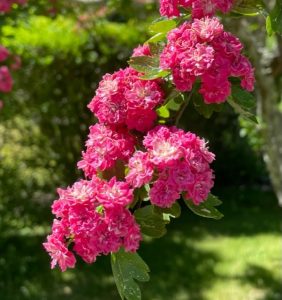
April 30
We have always heard tell of the “carnival atmosphere” of the Whitney Biennial, though we only experienced its sense of “art barkers” for the first time this year. The much-used phrase “mixed bag” also continues to apply. For us it was a matter of overstimulation without much opportunity for depth; the crowds we encountered even mid-week didn’t help. By enormous contrast, the experience at Dia: Chelsea which followed — only some blocks north — was extraordinarily profound. Camille Norment describes her work as “cultural psychoacoustics,” and the effects of her sound installations are truly soul-altering. We did not read the gallery’s description or explanation before we experienced the two cavernous rooms, and so our response was in some way “pure.” Yet there was no confusion as to the emotional meanings of the sound abstractions, particularly those of the second room, whose wood structures alternately evoked a medieval church, a Hanseatic-era port, the bowels of a slave ship. Speakers were hidden within the wooden pilings (on which one could sit), so that the sounds were not only heard but felt as vibrations. The recorded chorus seemed to be both the voices of humans and of the natural world — the wind, the ocean, the historically oppressed — all suffering the moans of Earth’s shared experience.
April 23
Despite the dark shadow of Omicron variants, Putin’s viciousness, and the welcome effort of elaborate health protocols. we cautiously attended this year’s Paris Review Spring Revel. It is an expensive lark, completely in keeping with the late bon vivant George Plimpton’s approach to literary life. But looking back on this year’s version, despite the best efforts to keep it going, perhaps that world has grown too serious and sad for such revelry. The self-mockery of the “New York School,” to which the Review remains attached, was the inside joke of a set of outsiders now become academic industry. And while we hardly take a lighthearted approach to sexual harassment and bigotry, the recent history of Review editors and prize-winners behaving badly hardly falls into the category of war crimes. But then, as the evening confirmed, our perspective belongs to that of another generation. Either we are just not that cutthroat, or we somehow feel it’s bad form to flash in public the sharp blades of our determination or the half-healed wounds of our disappointments. We really still think of colleagues as either aesthetic friends or enemies, not as a network of career strategies. But then, as is obvious, we are extremely fortunate to live most of our hours in a literary dreamworld of our own imaginings. And perhaps the ironic tone of a quip we once heard as a witticism, now repeated, has become a joke falling embarrassingly flat — or much worse.
April 16
One of the take-aways from Jed Perl’s magnificent two-volume Calder biography was the crucial importance of friendships between writers and visual artists. This is a dynamic that’s been around for quite a long while (millennia, we would estimate), though it requires someone of Perl’s expansive cultural reference to set out the significance of interactions in any given time and place. Such a biographical task requires accuracy and nuance, as well as the determination to follow such a demanding undertaking to its conclusion. Something of the same kind of inter-personal backdrop became evident to us at the (literally!) splendid Holbein exhibit at the Morgan Library. The political aspect of the Tudor Court has been well covered by historians and biographers, but we long for a Perl-like treatment of the relationships between the artist and acquaintances like Erasmus, Wyatt and More, as well as with lesser-known writers like Nicholas Bourbon or Thomas Elyot. Such a volume may well exist; we admit our ignorance. But we still have numerous questions brought on by the thought-provoking “Holbein: Capturing Character.” What is there to say about, we wanted to ask someone, the importance of Horace Walpole to Holbein’s afterlife in England?
April 9
During our visit to the Titian exhibit at Boston’s Gardner Museum, some months before the passing of Richard Howard, we were reminded of one of his funniest poems. As fantastic as the show’s exhibited works were, some of the commentary bordered on the ludicrous, an absurdity which took us back to Howard’s ekphrastic take on “The Rape of Europa.” It ended (and we paraphrase) with a punchline that ran something like, “’the museum does not condone the painting’s violence.” We haven’t been able to put our fingers on the poem, which must date back some twenty years, but in trying to we’ve gone through a tall stack of the poet’s book publications, the earliest of which dates back sixty years. Those first two volumes were published by Wesleyan University Press; the next seven were brought out by Atheneum (including 1969’s influential prose Alone With America) with one under the imprimatur of Knopf (1989); Turtle Point took over for another six; FSG then produced a sturdy pair of selected prose and selected poetry; most recently NYRB published another sort of selection with the awkward emoji title RH (heart) HJ and Other American Writers. Given Howard’s prolificacy, it’s unlikely that there won’t be a posthumous volume. We ourselves heard him read from a splendid poem not yet published. We will miss him dearly, as will what’s left of American letters.
April 2
We thought the cherry blossoms would be in bloom the week we visited the New York Botanical Garden in the Bronx, but almost the only flowerings outside were the very first of the daffodils. In a way this was all good in that it set up a dramatic contrast to the kaleidoscopic Orchid Show inside the Enid A. Haupt Conservatory. The size of NYBG’s glass building is so expansive that we wandered for a full hour through its heated climate, tropical biomes packed with otherworldly flora coming up from the ground and hanging down from overhead. As curated by the floral designer Jeff Leatham, the show is so luxurious it nearly surpasses mere decadence. But as the orchids so articulately testified, nature can be extravagantly decadent.

March 26
Just a few weeks ahead of Covid’s arrival we stayed at Goldeneye on Jamaica, a resort developed by Chris Blackwell on property once belonging to Ian Fleming. For a brief moment, we even sat at the corner desk of James Bond’s creator. Back in those halcyon days of presumed good health, there was a lot of excitement about the then-forthcoming movie which, we were told, would definitely contain scenes of the resort. It’s now said that the Jamaican episode was filmed “nearby,” though Bond’s retirement villa (where the film’s hero should have remained) certainly bears a striking architectural resemblance to some of Goldeneye’s fancier bungalows. In any case, a delay of two years ensued, and No Time to Die became the first and only movie we viewed in an actual theater during the pandemic. With these two experiences as our personal (so we hoped) bookends, back at home we recently watched the entire five-volume 4K/DVD set of Daniel Craig’s Bond films. There is a distinct narrative arc and various linking characters to the series with one wholly relevant thematic: Death. The boxed set’s apex is Sam Mendes’s direction of Skyfall, full of dark Scots psychic background, as well as the demise of M as played by Judi Dench. There’s also the real-life death of the very great Albert Finney, playing Bond’s family estate caretaker — a part written with Sean Connery in mind — just after his scenes’ shooting. The spectacularly apocalyptic destruction of the Skyfall mansion foreshadows (spoiler alert) 007’s own end. Craig’s Bond consistently managed to evade death (shooting at canisters of gas to get him out of various squeaks) but genetic weaponry is too much for him — as it will undoubtedly will be for the rest of humanity. In No Time to Die, the sense of dread and fear of the last two years finds its Bondian summation.
March 19
The Gilded Age is a very silly series which we have been enjoying as much for its sets and costumes as for its sheer stupidity. It gets so much wrong about a particular era (and a lingering New York social subculture) that it often makes us laugh out loud. But it also has made us newly conscious of how many buildings along Manhattan’s Upper Fifth Avenue, all open to the public, actually take us back to the halls and stairways of the previous century. There’s the old Frick, of course, but also the Jewish Museum, the Cooper Hewitt, the Neue Galerie. as well as the building housing Albertine, the French bookstore. And, of course, across the street, there’s the Beaux-Arts courtyards of the Metropolitan Museum. As far as authentic interiors, much farther down on Madison Avenue, the time-travel so luxuriously afforded by The Morgan Library continues to astonish. For that renewed architectural awareness and pleasure, we happily forgive the show all its nonsense.
March 12
We are finding that our actual visits to museums are less about the objects and artifacts on display and more about interesting new ways of exhibiting them. This has been aided by the ever-present cell phone, of course, which allows for immediate access to exhibition commentary and secondary sources. But even for the visual arts, the museum “experience” has expanded to encompass several other senses. Jennie C. Jones’s sound, space and image show at the Guggenheim, as one example, reworked, if not dissolved, any received definitions of “minimalism.” But perhaps the most effective rethinking might be found at the Jewish Museum’s “Jonas Mekas, The Camera Was Always Running.” For those already familiar with Mekas’s work, the multiple yet synchronous presentations were a welcome way to revisit the filmmakers oeuvre; as the show’s title confirms, there’s a lot of material in the archive. In the museum’s main floor exhibition space, different sections of the same diary film were shown on a dozen screens; this had the very poetic effect of collapsing, and transcending, time. As the museum text explains, the idea was “conceived around the license Mekas granted his audiences at the 1969 premier of Walden, in which he acknowledged that viewers might enter and exit his non-linear film at any point, intuiting a not-so-distant future when filmmakers presented their works in exhibition spaces rather than cinema screening.” Beautifully simple yet profound, the show is a brilliant example of the possibilities for innovative curatorship: “Through his work, the artist encourages viewers to find their own meaning and path through the stuff of his life.”
March 5
We attended this year’s PEN America Literary Awards Ceremony at New York’s Town Hall mostly out of members’ curiosity and a love of Elaine May — though those two reasons overlapped with a strong desire to do something that was not virtual. And we have to say, it was a great live show, nimbly hosted by the witty Seth Myers. In place of the in-person appearance of the great Ms. May, we had the self-deprecating and still-beautiful Candice Bergen, as well as hilarious videos from Nathan Lane and the Mike Nichols Award honoree herself. The house band, led by Ulysses Owens, Jr, was super, and Broadway star Bobby Conte’s version of “Something’s Coming” got the show off to a rousing start. Jenn Colella singing “Anyone Can Whistle” during the year’s in memoriam roll was shown struck an especially poignant note when Sondheim’s picture itself came onscreen. But it was Kyle Taylor Parker’s soulful closing “What I Did for Love” that made it almost impossible not to tear up — he truly brought the song across the pandemic expanse. This, with much sincere literary gratitude from the winners (as well as a small portion of baloney), combined with the honor of being present to honor Ngugi wa Thion’go, made for as good a Broadway ticket as we can recall.
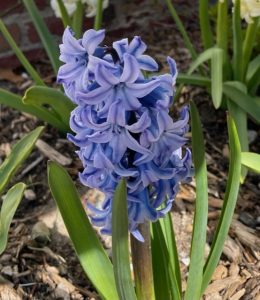
February 26
As interesting as we found his self-portraits at Lori Bookstein Projects, it’s the show of Paul Resika’s new work at the New York Studio School, “The Allegory Paintings : San Nicola di Bari” that incontrovertibly proves the artist to to be one in a long line of “Old Masters.” Inspired by an engraving after Fra Angelico, the series of increasingly abstracted interpretations exhibit the painterly skills of Titian or Tiepolo, as well as the great Venetians’ mastery of color. As Resika began the works when he was well over ninety years old, the feat is especially remarkable. The original Fra Angelico predella depicts a miracle of Saint Nicholas; a ship presumably caught in the doldrums is saved by the saint, divine sails billowing in a wind brought forth by the Almighty. In Resika’s similarly miraculous interpretations, sail-forms seem to take on a life of their own, paint skimming across the canvas surface, carried aloft by the technique and inspiration of a lifetime in art.
February 19
A really terrific show at the Michael Rosenfeld Gallery in Chelsea, “Manhatta: City of Ambition” (shown first at Art Basel, Miami Beach in 2021), has Walt Whitman’s “Mannahatta” as its inspirational source: “What there is in a name, a word, liquid, sane, unruly, musical, self-sufficient.” The 1920 Paul Strand/Charles Sheeler film Manhatta, shown onscreen in the gallery, interprets in moving images Whitman’s urban thesis, while paintings and sculpture riff on the show’s theme and dynamic. One great canvas included is Charles Alston’s “Harlem at Night.” It made us think of Claude McKay’s Harlem Shadows, a collection of poems by the Harlem Renasisance author recently brought out by Angelico Press. (Skip the book’s introduction, which presents the poetry as leading to McKay’s late conversion to Catholicism.) Though — unlike most of the works at Rosenfeld — the poems are anything but “avant-garde,” being very much written in the prosody of their time — “olden verse that smacks of love and wine” —they are wonderfully evocative of city stoops and same-sex sidewalk heartbreak. Sometimes pained and truth-telling, but ever gentlemanly, there is something wonderfully old-fashioned but beautifully gracious in McKay’s well-paced lines.
February 12
We visited the Lenfest Center for the Arts at Columbia University for the first time this year. The Miriam & Ira D. Wallach Art Gallery presented several excellent exhibitions, but it was “The Art of Listening: Under Water” for which we had made the trip. From the art galleries we took the elevator up to the new Renzo Piano building’s top floor, rising high above the Harlem and Manhattanville neighborhoods; in the near the distance could be seen Grant’s Tomb. Inside the south-facing window-wall of “The Lantern” lay a cavernous expanse, empty save for some speakers and a gathering of backless ottomans. We sat ourselves down a bit clumsily on the gathered mushroom-like seats and waited for the installation to begin. The sound composition was the the work of Norwegian artist Jana Winderen, created specifically for the space, made of hydrophone recordings collected by the artist and her crew. (The installation’s effectiveness, it should be noted, was in large part due to extraordinary technology overseen by sound artist Tony Myatt). We were surrounded by the “voices” of all manner of underwater creatures (fish, cetaceans, mammals and even crustaceans); it was fascinating and often quite beautiful. But when human-made sound presented itself, the thump of ocean liner engines moved us from the auditory realm to the vibrational, with the monstrous motors’ presence felt through the floor. It was truly horrific. We began to have some sense of the terror our human presence provokes in the oceans, some visceral understanding of the devastation human shipping lanes produce in intelligent and sound-sensitive creatures like dolphins or humpback whales. The curated experience was exhilarating, humbling, and deeply distressing.
February 5
Jed Perl’s new book, Authority and Freedom, is not getting a lot of attention. We hope this is because its argument has become in recent months pretty much self-evident. Though he doesn’t name names, the obvious shallowness of works created solely with identity politics in mind have communicated their audience-grabbing intentions with unintentional eloquence. Perl asserts that art doesn’t need an agenda; critical judgments and appreciations should be made independent of social, economic and political values. The true dynamic of art isn’t between the individuals and society; it comes out of an argument between what Perl, provocatively using terms usually applied to political discussions, refers to as “authority” and ‘freedom.” He also identifies these as “order” and “experiment.” On the metaphysical plane (independent of more immediate issues of skill or craft) order is convention; experiment is invention. As Perl points out, there is no correspondence between traditional approaches and conservative politics, or between radical art and progressive social policy. There are way too many historical examples that disprove this dubious association to allow that received idea to stand unchallenged. Which is not to say that art has no political effect, or that political figures have not often attempted to harness art’s ability to sway hearts and minds. But the ground of art is the imagination, an endlessly fertile homeland that thinkers such as Perl are right to defend as not to be invaded by dogma.
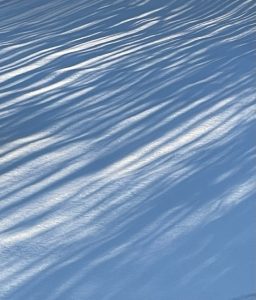
January 29
Summer of Soul, Ahmir “Questlove” Thompson’s documentary about the 1969 Harlem Cultural Festival, records events taking place the same year the footage of the Get Back was filmed. The festival is sometimes referred to as the “Black Woodstock,” as both took place in the summer of 1969. (That the Woodstock material was made into a popular movie while the Harlem tapes remained in storage is a matter of some justifiable anger.) The three films overlap but suggest notably different perspectives on American music and politics. Only Woodstock has no specific reference to the assassination of Dr. King, though it is audibly present in the powerful performances of some of the upstate festival’s Black performers. The Harlem event presents a sometimes dissonant variety of Afro-American music, as the performances shown were culled from an entire month of the festival. From The Fifth Dimension to Nina Simone, with Stevie Wonder, Mahalia Jackson, Max Roach and B.B.King in between, it is a kind of time capsule, with all the pop nostalgia and poignancy almost-forgotten cultural revisiting involves.
January 22
As we watched and listened to The Beatles: Get Back, we thought a lot about Peter Jackson’s previous documentary, They Shall Not Grow Old. That marvel of editing and colorization returned us to our grandfathers, the generation that fought and died in the Great War. Get Back returns us to the dawn of our own late childhood. It’s a curated version of events, as much fiction as documentary, due to what is chosen to be shown. (That both Yoko Ono and Ringo Starr served as producers had its effect.) The production quality and the three-day viewing made the experience quite a bit like Virtual Reality. The length of time spent with the band (nearly nine hours) made it as though you yourself were slogging through the rehearsals — feeling all that effort, technical frustration, legal ludicrousness, and emotional exhaustion. Most of all, it captured the tedium of creation. We were reminded how Paul McCartney is so much a descendent of British music traditions — one hears the folk song, the music hall, skiffle. His crumbling dynamic with John Lennon is heartbreaking. But then, all the Fab Four were working as siblings, with the incumbent rivalries and divisions that come with adulthood. Yes, Yoko and Linda did break them up and led to a going of separate ways. The result, for us, was a distinct sadness, as we are witness to an historical ending, a marker of our own time. “They mingle not with their laughing comrades again,” as the Laurence Binyon poem observes, “They shall grow not old, as we that are left grow old.”
January 15
With Omicron, we have found ourselves back to watching an awful lot of TV. One vein of binge-watching we’ve already happily mined is Danish drama. We loved Borgen The Bridge, and The Killing; and even the creepy The Rain was worth watching for a few episodes. But two more recent movies, with their combination of moral dread and offbeat hilarity, really hit the spot. Both star Mads Mikkelsen. In Another Round Mikkelsen plays a high-school teacher who experiments with binge drinking with his circle of buddies; drinking culture shows itself to be both joyous and destructive, a dual reality that is both terrible yet life-affirming. In short, it was an excellent choice for Dry January. In Riders of Justice Mikkelsen plays a widowed soldier returned from Afghanistan who gets roped into joining a group of incompetent odd fellows and their mistaken plot to avenge a train bombing. It all ends in terrible and unnecessary bloodshed, but it’s weirdly heartwarming and very, very funny — mostly due to physical shamelessness of the now-familiar Nicolas Bro.
January 8
Also streaming onto home screens were a trio of “theatrical release “ movies, all directed by women. The Power of the Dog got a lot of deserved attention, as did Passing and The Lost Daughter. At this point no one could really be surprised by Jane Campion’s abilities, but that Rebecca Hall and Maggie Gyllenhaal would both direct such remarkable films at their first opportunity was unexpected. All movies were visually breathtaking, with each distinctive visual style and cultural locale part of their narrative’s meaning. But the movies have in common a certain cryptic quality, a slight indecision about motive and chance, that we honestly found a bit irritating. Taking them together, and generalizing from what is admittedly an arbitrary set, we still can’t decide what these “women’s stories” are about. They all treat the subject of the (sometimes well-intended) controlling oversight of men, the very mixed blessing of motherhood, and the gap between female social selves and inner lives. It’s meant to be less of a complaint than an observation, but our take-away is that these films provide evidence but make no conclusions.
January 1
Having returned to virtual offerings, we’ve signed up for Marquee, hoping its taped features of theatrical productions would serve as a substitute for cancellations of the real thing. Our first forays were a pair of dance offerings, two quite different pieces choreographed and filmed for home viewing. Scottish Ballet’s Starstruck is an imaginative revival of Gene Kelly’s Pas de Dieux, a production he choreographed for Paris Opera Ballet many years ago. With a score by George Gershwin, Kelly’s ballet might be seen as a “cashing in” on his success with An American in Paris. But a more charming reckoning of movie chips it would be hard to imagine, especially with Christopher Hampson’s effective “prologue” that nicely blurs dancing life on- and off-stage. The Scottish Ballet female dancers delightfully evoke the movements of Kelly movie partners Cyd Charisse and Leslie Caron; the male lead Evan Loudon captures exactly Kelly’s distinctive combination of athleticism and Yankee insouciance. It’s all fun. Boston Ballet’s Barre Project provided a very different kind of filmed dance project, though it is certainly equally satisfying. In the great William Forsythe’s take, the standard rehearsal room “tool” takes the role of performing co-equal. All the dancers (Lex Ishimoto, Roman Mijia, Brooklyn Mack and Tiler Peck) are astonishing (especially given that the rehearsals were all done via Zoom!), but in the end it’s Peck who most astonishingly whips through the choreographer’s breakneck moves. At times her legs seem less of the limbs of a dancer than a pair of compass points, so sharp and exact are her touch-downs to the floor. An interlude providing insight into the rehearsal process was humbling; and James Blake’s music must have been as much of a joy to dance to as it was to hear. All in all, a truly great dance film.

2022
December 25
On a recent Author’s Guild “Words, Ideas and Thinkers Series” on Zoom, Jay McInerney joined sommelier André Heuston Mack to speak about wine. Despite the sponsoring organization, the two spoke little about writing and more about what to serve and drink. But epicurean essays are a great starting point for serious discussion of writing, for even setting aside the matter of knowing one’s way around a sentence, there is that delicate issue of sensibility, of judgment and “taste.” Most challenging in this particular essay form is the attempt to translate the whole “wine experience,” with wine sellers usually falling back on overused simile. But it’s not just literal tastes (fruits, mushrooms, flowers) that need to be expressed in words; something of a wine’s “personality” or temperament must be adressed. We really liked McInerney’s comparison of certain wines to female movie stars, as that mode of reference does indeed capture the distinct quality of what has been poured, both its immediate physical presence as well as a remembered sense of the associations a bottle produced. We thought this was all really pretty useful, using the smart yet resonant astringency of Katherine Hepburn to describe a Chablis, or suggesting the weight of experience in a great Bordeaux as something carried by Simone Signoret. But we would certainly extend this game to our favorite male actors — the divine Marcello Mastroianni as Barolo, the quicksilver Jean-Louis Barrault as vintage champagne.
December 18
In Boston for a few days, we explored that city’s contributions to contemporary art. AT MIT’s List Visual Arts Center, there were three exhibits on view, all highly conceptual and, unsurprisingly given the venue, mostly dependent upon technology. Leslie Thornton’s Begin Again, Again and the short films of Andrew Norman Wilson were essentially video installations. Wilson’s narrative fictions are interested in the commercial and industrial histories of film production (Kodak and Impersonator reference the careers of George Eastman and Walt Disney). Thornton explores the Cold-War origins of a generation’s shared history of nuclear warfare, using her own reels as well as historical footage. Both of these exhibits were overwhelming; there was just too much troubling information and intellectual stimulation on offer. We found Sreshta Rit Pemnath’s Grave/Grove much more effectively troubling. Word plays suggested a relation between death and a increasingly hard-to-experience nature, tuffs of living plants struggling to live within narrow the confines of metal panels, nurtured by IV drips of water. The white-hum experience of the room was something like visiting slumped figures in a the ward of an understaffed hospital, powerless souls waiting for the lone doctor on his rounds or the exhausted nurse with a cart of painkillers. We are all waiting for this pandemic to end.
December 11
Attention should be brought to “Bringing the Supply Chain Back Home,” written by Robert Kuttner in the November 18 New York Review of Books. Providing summation and historical background to a White House report on the subject, the author elegantly explains how Biden’s infrastructure proposals recall much of FDR’s successful New Deal policies. Central to the report is increased investment in domestic production of semiconductors, solar cells and batteries — as well as a charging infrastructure for electric vehicles. (Obviously, it’s carbon and multinational investment who don’t much like this kind of talk.) As the article shows, such proposals have historically been the backbone of the neo-Rooseveltian Democratic Party, and should remain central to political discussions. Kuttner is editor and publisher of the admirable American Prospect, as well as the author of numerous important New York Times editorials. Though a regular contributor, Kuttner is nevertheless unafraid to be critical of the newspaper of record. For example, referring to the presence of right-wing (Republican) voices in its page, in the Prospect Kuttner states the obvious when writes that “The Times is bungling it by publishing op-eds by writers who are disingenuous about who they are and what they are selling, as well as intellectually dishonest.” We ourselves were honored to meet Kuttner in Provincetown at a fundraiser for the non-profit wing of The Provincetown Independent, for which Kuttner is an eloquently vocal supporter. It can’t be said too loudly or too often: Independent journalism has become the most essential component of any attempt to save America’s democracy — as well steer its way back to a planned economy.
December 4
We have been Lost in Space, abandoning ourselves once again to the time-sucking dangers of streaming. Begun due of the presence of Toby Stephens (alumnus of Black Sails and offspring of Maggie Smith and Robert Stephens)), we soon realized it was a program intended for eight-year-olds. We’re not exactly sure why we kept going, though the occasional recognition of the excellent (though underused) lead actor’s parentage was part of the fascination. In the current season, the boy Will Robinson having has passed into pubescence, the intended audience has moved on to ‘tweens. In the interregnum of seasons, we ourselves had completely lost track of the narrative thread, and suspect the writers had as well. It all evoked some weird pandemic passage of time, our current world having nothing to do with the old TV show with June Lockhart as the steadily domestic mother. That old weird Dr. Smith has been replaced by Parker Posey; no one (neither audience nor the producers) can figure out what she’s doing there. In an evident attempt to bring the space society up-to-date, there’s been the introduction of Black characters and ominous “historical” references to Earth’s fate. For us, in the end, it’s all about the uber-capable mother thrown series after series of impossibilities, to which she always responds: “We’ll figure it out.” And of course she, and her family, do.

November 27
We were grateful to see the Wellfleet Harbor Actors Theater simulcast of Terence Blanchard’s Fire Shut Up in My Bones. We loved the opera, and it’s fun to see backstage goings-on and watch intermission interviews with participants. But the truth is that the sound system at WHAT is pretty bad — which, after all, is what music is about. So it was a particular pleasure to attend the actual opera house premiere of Matthew Aucoin’s Eurydice. There were a few aspects to the updated mythic narrative that lost us, but the music carried it along with alternately thrilling and saddening lyric power. That the orchestra joined the cast onstage for the curtain call was wholly deserved; this was not an easy score to learn and play. Days later we still feel the opera’s emotional reverberations. In particular the relation between Eurydice’s father and his loyal daughter (as dramatized in Sarah Ruhl’s dreamlike libretto) carried with it something of the reality of aging love and Alzheimer’s, paternal memory dissolving and flowing away as powder beneath falling rain.
November 20
Bit by bit we are finding ourselves returning to something like the current art scene in NYC. It was a lot of fun to visit The Art Show (the Art Dealers Association of America) at the Park Avenue Armory and its fabulous spaces. We especially enjoyed the Robert Moskowitz silhouette pieces at the Robert Markey booth. In following days we visited a few Lower East Side galleries (Larry Rivers at Tibor de Nagy; some gorgeous big Resnicks at the Milton Resnick and Pat Passlof Foundation), but it was in Chelsea (at Michael Rosenfeld Gallery) that we were most deeply moved. In Beauford Delaney’s luminous abstractions, his glowing yellow not only represents but actually transmits the artist’s great wisdom and love.
November 13
A power outage here on the Cape lasting several days unexpectedly took us to running water at a new boutique hotel in downtown Providence. It wasn’t a planned trip, but there was considerable cultural recompense for the sudden inconvenience. We enjoyed walking around both sides of the downtown’s river, crossing its bridge and over the city’s unlit “WaterFire” braziers. It is always a pleasure to visit the RISD Museum, and there were a few new discoveries such as the fantastic ceramics of Paul Scott (traditional transferware at a distance but radically revisionary upon close inspection) and the transporting animated manuscripts of Shahzia Sikander. On the drive back to the Cape, we stopped in New Bedford to see “A Wild Note of Longing,” the small but terrific Albert Pinkham Ryder show at the Whaling Museum. The explanatory QR code has even made its way to New Bedford, with a recoded talk by the curators and each work provided with a digital description accessed by phone.
November 6
Eagle-eyed readers of the LOOKOVER will have noticed we have switched to monthly postings, with each week given an individual entry. In this post-first-round-of-Covid period, here at LongNookBooks we have developed such a strange sense of the calendar. Time has changed its configuration, with a week seeming like a day, a month almost becoming the former week’s expanse of memory. With so many seasons “lost” to the pandemic, the years are flying by as something with the feel of a season. In a blink it will be the New Year.
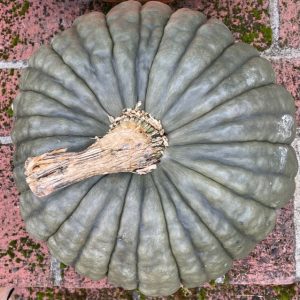
October 30
As part of a “Vanguard Residency,” five evenings titled “Kludge” at Joe’s Pub mid-month were curated by Laurie Anderson. The night we were in the audience, Anderson’s guests were poet Anne Carson and the Rubin Kodheli Trio with Trevor Dunn & Brian Chase. The residency award is given to “a singular artist who has contributed to American life and pop culture and is a part of the Joe’s Pub family of artists.” The program, as the name warned us, was indeed a “an ill-assorted collection of parts assembled to fulfill a particular purpose.” When Carson began with sections from Autobiography of Red, we began to wonder where the backward-looking evening might lead. But somehow Anderson’s deadpans and the fantastic improvisations of the musicians did seem to embody sonically the emotional narrative of Carson’s 1998 work. Especially stirring was Kodheli’s electric cello. And when Carson moved on the more recent writing (and the drink minimum kicked in), the evening picked up and, at least in the moment, felt like it had achieved something quite purposeful after all.
October 23
It was pure serendipity that we attended the opening of Edwin Schlossberg’s opening at Ethan Cohens Fine Art, the same day we’d gone to the Jasper Johns show at the Whitney. We had not realized that Johns had been a mentor to the artist when we spoke with him. In fact, the stenciled letters of Schlossberg’s pieces on paper or aluminum panel could easily be interpreted as homage. While we admire his both his art books and his most recent collection of alphabetic-kabalistic poems, Word: Nerve, it was the luminescent works on metal that seemed to us to express the country’s “collective state,” capturing well that quality of alarm that high beams on road signs may provoke. The Trump-Covid era has certainly propelled us into a modality of constant concern, a tired anxiety following real panic and fear. The words on Schlossberg’s panels, phrases like “Accepting Corruption is Corruption,” are the signage of our night-driving psyches.
October 16
The joy of the actual was made real by two performances of New York City Ballet, both evenings heavily weighted with the company’s older reparatory — mostly Balanchine and Robbins — the former’s La Valse, Serenade and Agon; the latter’s Glass Pieces and Other Dances. Suggesting NYCB’s resident choreographer might well serves as heir apparent to Robbins, Peck’s Pulcinella Variations makes us makes us very curious about Peck’s choreography for Steven Spielberg’s yet-to-be-released West Side Story.
October 9
We confess we still struggle at becoming “touchless” with Apple wallets, phone apps and QR scan codes. (Our excuse is that we only recently acquired broadband in the National Seashore, a reality that made it hard to keep up with an increasingly digital world.) But post-Covid New York is forcing us to catch up. More and more restaurants only offer digital menus, and most entertainment venues require digital proof of vaccination. As best as we can, we are happy to oblige these precautions. For whether at the Cézanne drawing show at MOMA or the Met’s Medici exhibit, we found ourselves profoundly grateful to look at actual art. It’s true that masks are oppressive, but we are more than willing to succumb to such a yoke under the circumstances. With iPhone in hand, very slowly we are adapting to the new normal.
October 2
After a long absence from the city, we recently paid a trip to New York’s midtown. There we visited three fantastic libraries, first spending a morning doing research at the NYPL’s Berg Collection. Along one of the 42nd Street Library’s upstairs marble halls and through a set of wood and glass doors, we were awed by the signed and annotated first editions of American literature stored behind locked cases. Downstairs we visited the thematically organized “Polonsky Exhibition of The New York Public Library’s Treasures,” free and open to the public. Later that day we heard Charles Bernstein read in J.P. Morgan’s Library, the Morgan’s considerably older volumes kept behind netted cabinets. This was the subject of much humor — the joke being that the elite keep their books locked up and away from plebeians. We acknowledge the issue of library accessibility (the NYPL’s new Stavros Niarchos Foundation Library — whose rooftop vista we also enjoyed — is especially working hard to welcome readers whose first language is not English) but we remain acutely aware of an equally consequential issue of security and protection of cultural goods. Public institutions and private foundations must continue to step up and oversee what was once the interest and obligation of a privileged class.

September 25
We were delighted to attend a Silk Road Project fundraiser at the beginning of the summer, a private event with new artistic director Rhiannon Giddens and several visiting performers holding a small group of invited enthusiasts in thrall. Giddens and her husband, Italian percussionist Francesco Turrisi, closed out our summer at Truro’s Payomet Performing Art Center. In the middle of the season, we were astounded by the equally amazing Don Flemons, Giddons’s former fellow-Carolina-Chocolate-Drops member. It’s hard to express how grateful we are to Payomet Director Kevin Rice for bringing such extraordinary performers to our backyard. Last year Flemons — a natural teacher and musical ambassador if there ever was one — taught at the Provincetown and Truro schools as part of Payomet’s Music Residency Program. LongNookBooks is more than happy to have been able to support such outreach initiatives at this fall’s Jazz Brunch-Garden Party fundraiser.
September 18
During the week we spent in one of the Cape Cod Modern Trust houses on one of the backroad ponds of Truro and Wellfleet, it was a bit too cold to swim, being as it was just ahead of the summer season. That cool week turned out to be a bit of luck, given that mosquitoes almost ruined our warmer months and would have made our lakeside sojourn a nightmare. Outdoor events in July and August that Covid had made essential became truly unpleasant. Breaches on the bay side of Wellfleet resulting in standing seawater were given as part of the explanation, but those rising waters are themselves evidently a byproduct of global warming. The saltmarsh-insect swarming was described as “biblical,” and we have to agree. And they’re still here, ruining entire overcast days, as well as that lovely time known as dusk.
September 11
The period of pandemic respite from THE LONGNOOK LOOKOVER was filled with both events and non-events, virtual experiences and actual ones. LongNookBooks was a sponsor and attendee at this year’s Mass Poetry Festival in the middle of May, with a “virtual booth” at its small press fair. As we described ourselves: We draw inspiration from the remarkable cultural history of the Outer Cape as well as its current art and literary scene. We continue to be motivated by the art community’s tradition of progressive politics, its active commitment to gender self-identification, and its ongoing concern with social and environmental justice. We thought of making our own promotional film, with poems from Mary Maxwell’s Cultural Tourism, Nine Over Sixes and Trail featured. Such volumes prove that Maxwell is not just a Massachusetts poet but truly a Cape Cod one, with decade-long explorations of the region’s nature and culture now forming the core of her collections. And though for twenty-five years she has been a year-round Cape Codder, Maxwell is not merely a “local” phenomenon. During the pandemic she was a participant on several national virtual stages, such as The Best American Poetry blog, Writers Against Trump / Writers for Democratic Action, as well as on her SoundCloud recordings of Trail.
September 4
Several highlights of this summer involved time on the water. We spent one week in a house belonging to the Cape Cod Modernist Trust, set on one of the area’s kettle ponds and accessible only by narrow dirt roads. Canoeing on nearby ponds, we were able to look at a Breuer-designed home from a wonderfully peaceful, floating perspective. Several months later we spent a memorable afternoon sailing in Provincetown Bay, that day enjoying (for us) an entirely fresh view from offshore. Provincetown is not exactly our hometown, but it’s certainly the “capital” of our cultural universe. On that score, The Provincetown Independent deserves a loud shout-out for representing the varied citizenry of the Outer Cape, from Eastham to Ptown. For people of privilege the pandemic has been a period of new perspectives — ones not limited to being on a rented boat. The subject of much summer conversation centered around the paper’s “Arts and Minds” section. We ourselves also found the coverage particularly stimulating and the younger point of view on social topics especially welcome.

2021
2020
December 26
Beginning in January we’ll be taking a hiatus from the The Longnook Lookover, focusing instead on a a number of new projects, the most ambitious of which will be a second volume of The Longnook Overlook. An online gallery of the works of Serena Rothstein (whose “Urban Lyrics” will form the Overlook’s center section) is also forthcoming.This coming year we’re also hoping to get out an expanded version of Mary Maxwell’s essay collection, Push and Pull. And besides various online events we’re planning to put together, as announced at the end of November, a digital chapbook of Maxwell’s poems with audio component will imminently be up at this website. Check our home page for the new links!
December 19
Here at LongNookBooks in this past year we’ve become even more aware of resurrected sound recordings. We are infinitely grateful to Dust to Digital (as well as the similarly remarkable Revenant label) for their extraordinary archival projects. The technology involved is something that’s easy to take for granted, as Dust to Digital’s first vinyl imprint, a “Parlortone” record, reminds us. This extraordinary black saucer returns to modern ears the earliest known recording of the human voice, a 20-second version of “Au Clair de la Lune” sung by the French creator of the “phonautograph,” Édouard-Léon Scott de Martinville in 1860. (That’s 17 years before Edison’s more famous tracing of sound waves.) Digital scans of Martinville’s recording surface (soot-covered paper marked by vibration-sensitive styli), adapted by “virtual-stylus” software as well as manual processes of audio restoration, have brought the French inventor’s ghost-like song back to the living. It’s eerie and miraculous.
December 12
Longnook Road continues to be unusually busy this winter with an influx of arrivals fleeing the pandemic, privileged citixens taking full advantage of their careers’ digital options. These members of the coastal elites (of whom we most admittedly number) tut-tut about Trump supporters’ unwillingness to wear masks at their local Walmart’s. But the huffing and puffing holiday cyclists, runners and hikers who pass us on the road or in the beach parking lot, more often than not, themselves refuse to wear masks. They manage to sport day-glo gear in order to avoid the also-increasingly-numerous maskless hunters, but just like those big-box shoppers, these pandemic exiles from New York, Vermont and Florida (as indicated from their license plates) don’t want their own fitness liberties impinged upon. Despite the definitive recommendations of the CDC and the laws of the Massachusetts Commonwealth, they think they know better what is safe for themselves as well as for all others.
December 5
Jed Perl’s two-volume Calder biography is such an extraordinary achievement, it’s taken us a good long while to read and acknowledge it. The first 600-page volume came out in 2017; the other equally heavy tome fell just this past year. The books’ ostensible subject is the life of the great and influential artist, but they may also be read as a slice of cultural history, that specific span of the twentieth century that linked pre-war America to European modernism. On this well-populated ocean liner (one voyage taking us up to WWII, one bringing us back home to our own lifetimes) may be found not only a familiar cast of visual artists, but also architects, poets, choreographers, dramatists and composers. Most all of our century’s important fools are on board Perl’s pair of ships. Calder is only the director of this circus, or put another way, he forms the main wire on which an engaging assortment of figures hang and move in the currents of history. For ourselves, we read Calder as an instruction manual for one way to become an American artist; play as approach to movement; the private life of family used as joyous template for public expressions.
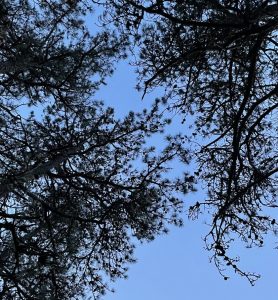
November 28
Those who follow LongNookBooks on our Facebook page will already know we have added a sound component to our website; it’s now possible to hear Mary Maxwell reading selected poems from her two most recent collections, Oral Lake and Nine Over Sixes. The recordings can be found on the two book’s title pages (via our bookstore tab above) or by searching LongNookBooks at Sound Cloud. These additions are just the beginning of a larger project to incorporate voice and music into our digital offerings. We’re very excited to announce that Trail, Maxwell’s magical new chapbook of poems (to be presented with audio accompaniment) will be posted here at the very beginning of 2021.

November 21
We are watching with great interest the new incarnation of Provincetown Arts Press. It is especially gratifying to see women at the top of the magazine’s masthead — as Editor-in-Chief, as Creative Director, and as President of the new Board of Directors. In addition, the recent online fundraiser featured a majority of women artists. All this makes for a worthy feminist project, though there remains the thorny issue of women raising monies. It’s a tough time for nonprofits all around, and those run by women have a particular challenge. Knowing something about the Press’s history as we do, we must note that the reason the Press managed on its shoestring budget was in large part due to Chris Busa’s hiring of underpaid women to do much of the labor (this in addition to men, such as himself or members of the previous board, willing to work pro bono). The new Press now has a dual mission: Looking forward, it needs to adapt its profile to an Outer Cape arts community much changed from previous decades; and looking back, it has an ongoing responsibility to make better available its historically significant content. Certainly all previous issues of Provincetown Arts magazine need to be consistently digitalized and made searchable. Such a reference collection, made accessible through the Press’s website, would form an important addition to the Town Hall’s ongoing archival projects. To be frank, as it stands now Provincetown Art Press’s online presence is something of a mess.
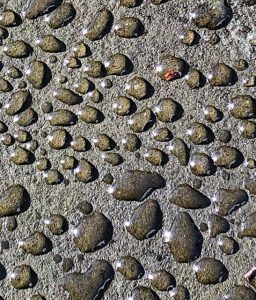
November 14
Joe Biden was robbed of his acceptance speech, and the whole world has been cheated out of a proper victory celebration. Not only did social distancing prevent most from dancing in the streets, but as a certain fearful magical thinking has taken hold (still traumatized by the morning-after-Election-Day shock of 2016), we ourselves keep putting off popping both the literal and figurative cork. It doesn’t help that we know most of the Inaugural festivities will have to be virtual, and that the traditional tableau of happy but freezing faces seated beyond that all-important hand on the Bible will likely be beamed via Zoom from somewhere indoors. Given the profound nature of the triumph, we feel more than a little childish about our disappointment. Still, it feels like petty schoolyard meanness on Trump’s part to delay the inevitable concession.
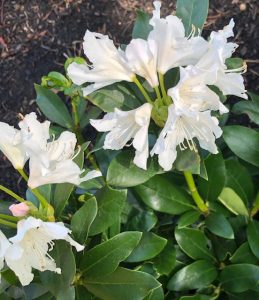
November 7
We are incredibly grateful to have The Provincetown Independent as our local newspaper on the Outer Cape. It tells us things we need to know. As Timothy Snyder points out in his brilliant and terrifying Our Malady, real journalism is “like medical testing … a way to produce facts.” He goes on: “What we always need in a democracy, and what we needed desperately in early 2020, was not invisible big data but visible small facts: local news, reported by local people for local people, for the betterment of all.” Yet it has been an enormous source of frustration for us that the Independent’s competitor, The Provincetown Banner, continues to be perceived by many as a local concern, when, in fact, it is produced by Gannet, the national news corporation that used to be known as Gatehouse Publications. Gannett is the publisher of, among hundreds of other papers, USA Today. And although the Banner publishes a few stories every week written by a handful of reporters, most other news is reprinted from Gannett’s Capewide daily, The Cape Cod Times. Indisputably one additional cause of the soon-to-be-over Trump nightmare was the replacement of actual journalism by social media; in relation to the pandemic, too many Americans who “consumed” information through Twitter or Facebook saw the confrontation between Trump’s fictions and coronavirus reality as merely the expression of differing political ideology. But here at LongNookBooks, whatever mud Trump and his supporters continue throw at “The Media” during the ongoing lockdown, we wholeheartedly agree with Snyder that “reporters are the heroes of our time; and like all heroes at all times they are too few.” Hats off to The Provincetown Independent and its determined, upstart and courageous staff.
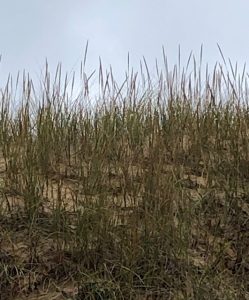
October 31
We were keenly aware of our extraordinary good fortune to be able to hear live music during “lockdown,” a cognizance made even more intense by the level of musicianship at last Sunday’s “Bach Before and Beyond” event at the Cotuit Center for the Arts. Seated in our own “pod,” socially distanced from only a few dozen other audience members, the experience felt something like being invited to a courtly concert during Europe’s Baroque age. The great cellist Phoebe Carrai was joined by violist Sarah Darling and violinist Katherine Winterstein to play trios by Purcell and Boccherini. Mozart and Bach filled out the concert’s cusp-of-the-Classical second half. It would have all been extraordinary under any circumstances, but to hear these three perform in such an intimate context, just ahead of the pandemic’s second wave, made for an undeniably privileged afternoon.
October 24
We have a few thoughts on the increased “presence” of poetry in American life. It seems to us that the profession has become something more like a “position” or a “role” than a vocation. In current practice the successful poetic career has increasingly become something for which quasi-political campaigns are mounted. It is no longer uncommon for poets to have agents, arranging for the placement of works as well as for their promotion through events like panel discussions and readings. Social media has to be posted; guest blogs have to be pitched; and the personal essay or opinion piece needs to find its way into nonliterary periodicals like Vanity Fair or Vogue. Poets now also apply for a variety of institutional positions, not simply teaching or running academic departments, but directing foundations, writing programs or research centers. Awards have become elements to a multipage CV, cumulative salary-building stepping-stones. While we admit our resistance to all this is not only old-fashioned but out-dated, our sense is that it’s nevertheless unbecoming. But then “respectable” lawyers didn’t used to advertise on billboards, and courtroom judges didn’t used to actively “run” for office. And so though we hesitate to make too much of our own prizes, we do draw attention here to Mary Maxwell’s “presence” at the Best American Poetry blog, not once but twice this month, with two poems from LongNookBook’s 2012 Cultural Tourism. Such national recognition is quite an accomplishment for a small press such as ourselves. We don’t have an in-house publicist to spread news of this event, but we are happy to be able to express here how grateful we are to Best American Poetry’s David Lehman.
October 17
As much as we admire Mimi Gross, we found The Arrival, 1620, her ambitious site-specific installation at the Provincetown Art Association and Museum, something of a let-down. Our sense is that it was completed in a hurry. The maquette for her commissioned project is terrific, though unfortunately its inclusion in the show undermines the life-size cut-outs filling PAAM’s big room. The miniature pen drawings are powerful and subtle, elegantly expressing gestures and facial expressions of the individuals involved; in this doll-size encounter, one is moved the pity and bemusement of the Wapanoag, as well as the uncertainly and terror of the Pilgrims. By contrast, the actual exhibit’s figures come off as big, clumsy cartoons. The Native Americans especially do not fare well in their enlargement; issues of political correctness are only the beginning of the problem. This is all quite disappointing, as Gross’s portrait painting in the past has so empathetically expressed a sense of imperfect humanity. It would be great to see Gross’s project returned to and continued so that it might be completed with something of the force of the PAAM proposal maquette. We ourselves might even go so far as to argue that the arrival of English non-natives (however disastrous the results were for the land’s inhabitants) could be acknowledged as a paradoxical foreshadowing of the the American immigrant experience; certainly with such a perspective, The Arrival, 1620 could be re-mounted at the Jewish Museum in New York City. In any case, although the show’s curator was obviously limited by pandemic parameters, a more considered presentation (in the form of a set of catalogue essays, for examples) would have better supported and contextualized this “celebration” of the 400th anniversary of the Pilgrims’ landing in Provincetown.
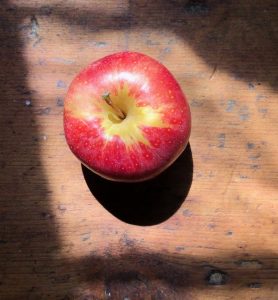
October 10
“I’m speaking now.” Those three words should strike fear in Republican’s hearts, as they rang as a powerful call to arms for women voters determined to make their voices heard. And although we understand that Kamala Harris had to stick to the Democratic playbook, we would have liked her to answer the last question of Wednesday’s Vice-Presidential debate with a bit more feminist improvisation. In response to an eighth-grade girl’s question about televised squabbling, we would have liked Harris to have made a few observations about women and American politics. First, it would have been good to recall the recent centenary of women’s suffrage and to make the point that the passing of the Nineteenth Amendment was hard won through both protest and congressional processes. Secondly, the person of Ruth Bader Ginzburg should not have been allowed to be presented by Pence as merely an example of personal amiability in her friendship with Antonin Scalia. What the appointment of Amy Coney Barrett would mean for American women should have been clearly articulated and contrasted with the Vice President’s Right-to-Life position. And finally, we would have really loved to have had Harris suggest to the questioner to pay attention when men and women find themselves in public debate: Has the young questioner noticed the tendency of men to walk over women’s words, play by their own rules, rewrite questions they don’t appreciate being asked?
October 3
That moderator Chris Wallace got what he deserved did not provide enough satisfaction to offset the grimness of this past Monday’s Presidential debacle. It was pure bread and circuses, with Fox News being mauled by its own monster. The President urged on his violent, militia-led White Supremacist base, and they loved it. Post-election strife (with a Biden-Harris victory just afterward all but certain but now disturbingly less so, given Trump’s positive COVID test and hospital stay) is not only possible but likely. And if Pence has to take over in the coming days, the process will become even more unstable. Trump, however, slipped during his debate rants. The Republican playbook has now been made public: The “radical left” will be blamed for inciting discord and division. The country’s military, especially the leadership who have observed the administration first-hand, will be on Biden’s side; they are as shocked as anyone by the sociopath presently at the country’s helm. But without minimizing in any way the long history of police brutality against Black citizens, the Democratic Party needs to make its peace with local law enforcement. This will need to be done by each of us — state by state, county by county, officer by officer — one citizen reaching out to another.
September 26
We’re not sure how we got pulled into Outlander. Like the British nurse who found herself passing through stone and back into 18th-century Scotland, it just sort of happened. And so through binge-watching’s form of buzzing Druidic trance, we, too, have been transported to the Jacobite Highlands, to Revolutionary Paris, to pirate-friendly Jamaica and to Colonial America. And we’ve also been back to Sixties Boston, where our postwar nurse has become an accomplished surgeon. The narrative may not sound sexy, but there’s a lot of skin, most appealingly in the very buff person of the show’s kilted hero, Jamie Fraser. Everyone, and we mean everyone, falls for this tall, red-haired Highlander. A lot of ludicrous karmic coincidence extends across the centuries, with Jamie’s lilting brogue, quick temper and heartfelt manner the plot’s reliable ballast. Does any of it really make sense? Are the characters behaving with anything like temperamental consistency? Did women really wear their hair like that in Enlightenment-era Edinburgh, let alone in Wilmington, North Carolina? As bonnie blue-eyed Jamie is regularly assuring someone in his Scots Gaelic, Dinna Fash, i.e. Don’t worry about it.

September 19
LongNookBooks is an active supporter of the political advocacy group, Writers Against Trump. It is nearly impossible to imagine a similar collection of the president’s pen-wielding supporters, as even past members of his own cabinet have come out in support of the Democratic nominee. That the election is nevertheless still far from a sure victory for Biden/Harris is profoundly troubling. As do the Writers Against Trump founders and organizers, we see the weeks just beyond November as a serious source of concern, with post-election civil strife as increasingly likely. It will be up to the victors to articulate terms of reconciliation, a task that will fall to the nation’s poets and writers.
September 12
One benefit of the social distancing now extended into fall has been renewed awareness of mushrooms. Beyond noting those popping up in our autumn front yard, we’ve never really had time to observe their mysteriously varied arrival within the surrounding forests and woodlands of the National Seashore. We are not bold enough to consider gathering them for actual consumption, but we are nevertheless entranced by their colors and forms. There are those who’ve declared that mushrooms will save the world, breaking down petrochemicals and absorbing dangerous radiation. Increased interest in this fascinating underground mycelium network, which has been described as Earth’s “sentient membrane,” is not limited to us. Modern medicine was changed by the discovery of penicillin; the efficacy of certain molds’ antibacterial and antiviral compounds, from which prescription antibiotics are derived or are being developed, continues to be subject to scientific research. Also intriguing is the fact that animals and fungi sprout from the same evolutionary branch (unlike plants, neither rely on photosynthesis). We have, of course, always been charmed by the presence of mushroom circles in folklore; our fairytale musings now join thoughts of fungi’s indisputably practical attributes in our autumn wanderings.

September 5
We can’t go so far as to recommend 2014’s Lil’ QuinQuin and its 2018 follow-up, CoinCoin and the Extra-Humans. World events of the past few years have rendered its bleak humor too depressing to chuckle at. The most upbeat thing we could say about the people it portrays (fictional characters played by non-actors) is that the northern coast of France would seem to contain its own population of “Trump voters”; there is sick comfort as well as additional distress to awareness of that political reality. The director Bruno Dumont presents a cast of individuals displaying varying degrees of cognitive shortcoming, extreme right-wing political believers evidently falling into the mental defective category. Both movies, at least at first, proceed down the familiar investigative route of the police procedural, everyone involved too stupid to see what by the end of the film becomes obvious to viewers— the murderer who stuffed body parts into the orifices of cows was one of their own. Instead blame and resentment is directed at non-white immigrants. CoinCoin and the Extra-Humans extends the genre into Invasion of the Body Snatchers territory, human aliens continuing to be held responsible for bizarre behaviors caused by identity-stealing extraterrestials. On paper this all sounds like a promising concept, but it makes for grim viewing. For us, it ending up being about as funny as Trump’s own impersonation of a disabled questioner.
August 29
These days there is talk on the Outer Cape of a “second summer,” a proposal to extend the tourist season well into October. The catch phrase identifies a phenomenon well underway, as anyone who has a place here isn’t in a hurry to go anywhere else; if someone can (or can afford to) work virtually, that’s self-evidently the sane preference. For us it means Longnook Road will be the busy thoroughfare it’s been the first official round of the season; more restaurants will remain as options for takeout; and driving Route 6 will continue provide its share of adrenaline-inducing madness as we make our occasional forays towards or past the Orleans roundabout. There is a lovely back way, as it happens. Before Google maps, that was a secret kept for year-rounders.
August 22
Eugène Green’s 2014 La Sapienza is visually beautiful, but there was something brittle about the film’s concept and direction that just didn’t settle right with us. The title refers to Baroque architect Borromini’s masterpiece in Rome, Sant’Ivo alla Sapienza, though the filmmaker also spoke in the DVD’s extras about the philosophical concept of “sapience” (not a common word in English) as ”knowledge that leads to wisdom.” In soft rebuttal we couldn’t help but think that Mary Maxwell’s “Sapientia,” the poet’s translation of Hildegarde of Bingen’s 12th-century Latin hymn, more exactly captures the word’s real sense. Maxwell’s version, which was included in in LNB’s 2012 An Imaginary Hellas, translates “sapientia” as “wisdom,” though as the poem makes clear, it is wisdom of a very particular sort. Besides being a poet, Hildegard was a composer; in fact, she is the first woman whose music remains extant. She was also nun, actually an abbess, who worked as a healer — as a spiritual advisor to the church as well as someone who treated physical ailments. As a capitalized feminine noun, Sapientia lends itself to personification. The original poem presents Wisdom as a wise and capable woman, someone presumably not unlike Hildegarde herself. The Latin word is derived from the verb sapere (to taste), which is cognate with the English savor. (As Linnaeus used the nomenclature homo sapiens to identify modern man, it might be argued that what makes us human is not language or tools but cuisine — but that’s a whole other discussion.) The French savoir is also derived from sapere. To know, therefore, is fundamentally related to discrimination (as with savoir-faire or savvy), as well as to the more down-to-earth idea of “know-how.” In the poem Sapientia’s “three wings” extend to practical knowledge, in the way that the medical arts are applied forms of understanding. Sapientia, according to the poem, may be manifest in products of the creative imagination or abstruse thought, but it is also found in the kind of person who knows how to make things better, remove a splinter or apply a compress, soothe the grieving with exactly the right words. In short, we’ve all known a wise (and too-often-undervalued) female Sapientia. By contrast the dialectical narrative of Green’s La Sapienza, as wonderful as it was to visit a virtual Italy, ended up being limited by the director’s stiffly inhuman perspective.
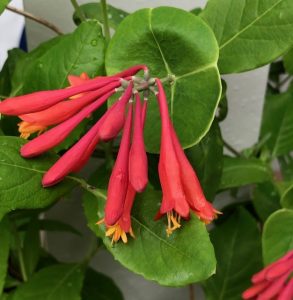
August 15
We were touched by Toby Olson’s remembrance of George Economou in the current Poetry Project Newsletter. We observed their friendship first-hand here on the Cape, the two of them attending each other’s readings at Castle Hill’s “backyard” series some summers ago. In our college days we had encountered George as the co-editor of Proensa, a 1978 anthology of troubador poetry (recently reprinted by NYR Books) with the great translations by Paul Blackburn. Soon after we moved to Truro we came across some of his lesser-known poetry titles at the bookstore that used to be next to the Wellfleet Library, first getting wind that he and his wife, Rochelle Owens, were “around.” A few years later, we got in actual touch with the two of them. George’s relatively mainstream scholarship on Medieval Literature unexpectedly intersected with a distinctly more experimental circle that included Robert Duncan, Robert Kelly and Jerome Rothenberg. We hadn’t realized any of this when we first met him, nor that one of his early collections had been published by Black Sparrow. In later years George returned to his Greek roots, translating Cavafy and creating the wholly fictional Ananios of Kleitor, a faux translation and academic parody that somehow integrated the diverse elements of his literary being.

August 8
Apophenia is the term is for the recognition of a pattern that isn’t actually there. The gambler’s fallacy (as well as the investor’s) is one of its manifestations, but it’s also an early indicator of schizophrenia. (Paranoia is a particular form of the phenomenon.) And so although we hesitate to make the following observation, a distinct pattern nevertheless did emerge as we worked through six months of fallen-behind periodical reading. Going through past issues of NYRB, TLS, LRB, etc., we noticed that when a contributor writes about a set of books (“Best Books About” in WSJ’s Review or The NYT Book Review ’s “Shortlist” are two examples), the reviewer’s latest book publication is, more often than not, warmly featured in a future issue of the same periodical. The NYT is especially proud of its policy that it doesn’t allow “payback” or “revenge” reviews, but to us this seems like a back-door version of something similar. It’s easy to see how this happens, and it’s not anything particularly nefarious; it’s just part and parcel of the publicity machine. The publisher wants the forthcoming author’s name out there, and so she/ he/ they write op-eds related to the forthcoming’s topic, make lists of books they’re reading on the subject, or pen reviews of books in similar categories. For authors and publishers not running on the inside track, it must be absolutely maddening. And, of course, from the reader’s point of view, literary-industry logrolling renders the ostensibly objective review almost meaningless.
August 1
In this pandemic summer, our hoarding tendencies have really paid off. As our readers know, we find book series and collections pretty much irresistible, but music sets also beckon to us with their siren songs. Some years ago the Revenant label (John Fahey’s company) brought out the jazz musician Albert Ayler’s Holy Ghost, housed in an African spirit box. This wooden vessel also contained a reproduction of a 1963 The Cricket magazine (“Black Music in Evolution!”); a photo of Ayler as a young boy playing his sax; a handwritten note by Ayler (“Don Cherry is now in Paris…”); poster from Slugs’ in the Far East (announcing “Sun Ra and His Astro-Infinity Music,” among other acts); and a dried dogwood flower. This collection of items strikes us as evocatively fascinating, yet also as somewhat baffling, as Ayler’s music itself, deeply haunted as it is by both the Black church and the cultural energy of the early Afro era. The set is comprised of nine CDs (unissued recordings and interviews), as well as a 200-page volume of liner notes. In his recollection of Ayler in Saint-Paul-de-Vence just months before the musician’s death, Daniel Caux writes of a melancholy, “probably due to the intensely poetic dimension of his inner universe.” The circumstances of Ayler’s drowning in the East River remain shrouded in mystery, but he left behind the legacy of a profound truth: In sound may be found the divine principle.
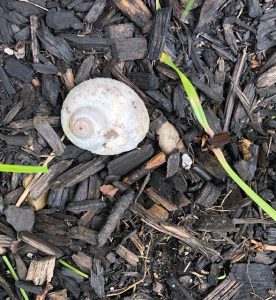
July 25
Like everyone else, here at LongNookBooks we’ve been visiting online galleries; we’ve watched YouTube poetry readings and music performances; with our new office’s high-speed internet, we’ve even been checking out various sites for “new media.” We know the art world is in a holding pattern, but our virtual experiences, as worthwhile as some of them have been, confirm our belief in actual presence — of painting and sculpture, of live performers, of ink and paper books. For us it’s not just a matter of nostalgia for social context (museums, concert halls, libraries); after all, we’re listening to non-digital recorded music (vinyl!) with renewed appreciation. But we return, yet again, to our argument about the things only tactile objects can provide. We’ve taken particular delight these days is in a series of almost-silly volumes, coffee-table books that treat anything but “heavy” subjects. Among these are John Cage’s two-volume Mycological Foray (with gorgeous separate-sheet lithographs of mushrooms by Lois Long); the very groovy Mr. Ken Fulk’s Magical World; and the endlessly fabulous The Best of Flair which, with its embossing, gatefolds and die-cut pages seems to have exhausted every possibility for magazine printing in the one year of its extraordinary existence. And then there’s editor Fleur Cowles’s curated 1950 content —art, travel, decor, fashion and literature of the highest caliber. Truly, this has to be a contender for the Desert Island / pandemic quarantine volume for all time.

July 18
We love Wellfleet. As far as the town of Truro goes, as Gertrude Stein would put it, there’s really no there there. But Wellfleet has a real downtown that continues to do all the things a Main Street should do, even in a pandemic. There are shops, restaurants and galleries, of course, as well as business offices. (Even LongNookBooks now has an outpost at Duck Creek Creative.) But there are also well-used public benches, a still-functioning library, and the ever-energetically-run Wellfleet Preservation Hall, whose backyard hosts the weekly farmer’s market. Then there are the set of stately New England churches and halls, whose contributions to the community were once year-round but soldier on in the virtual realm: soup kitchens, AA meetings, as well as religious services. And even though live theater and music are pretty much out of the mix, there is still the beautiful walk across Uncle Tim’s Bridge, a seat outdoors at Mac’s Shack or Mac’s at the Pier — all with a view of that oyster-filled blue harbor.

July 11
Poetry Magazine and Foundation have lost considerable credibility in recent weeks. Yet search as you may online, you’ll find few details about Don Share’s resignation as the magazine’s editor. Undoubtedly he himself has signed a NDA, but one would think it’s a story for literary journalists to investigate; some SEO expert has managed to keep that fiasco from spinning on media and social networks. But stepping back for the bigger picture, for some time now it has been troubling how the Poetry organization became so influential it could truly be described as all-powerful. Now that the magazine has lost its editorial authority, we do have to wonder how no one noticed (or at least spoke out about) Poetry’s lapses before. One small but telling example of the monolith’s failure remains on the its blog and website. On an unsigned article entitled “An Introduction to the New York School,” the entry not only neglects to mention two important first-generation members of the school but links to a slew of half-informed blog posts, many of which originally appeared only with the anonymous byline of “Harriet Staff.” We can certainly understand why no one would claim most of these, but the issue returns us to the matter of authority. Given that both Edwin Denby and Harry Mathews published in the magazine (Harriet’s staff obituary even stated, “Mathews has long been associated with the New York School of Poets”), the article provides credence to our sense of the whole enterprise’s unreliability. Poetry’s editorial default mode has been consistently sloppy. And after that $100 million gift to the Foundation from Ruth Lilly in 2003, it isn’t like its editors and contributors have been working on a shoestring.
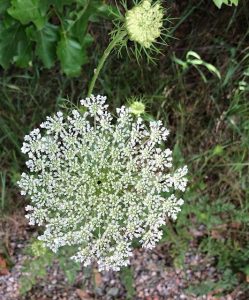
July 4
The LongNookBooks online journal goes back eight years. Our first posting (July 9, 2012) celebrated the annual Provincetown Arts magazine party at the Provincetown Art Association and Museum. In that season’s issue, Mary Maxwell’s Cultural Tourism was noted in the publication’s “Buzz” column. Though Maxwell’s collection of poems was not the very first volume LNB published, 2012 was nevertheless a watershed year. This summer also feels significant, and not only as a decades-long marker of our unwavering support for the Provincetown Arts non-profit (only a portion of which took the form of an ongoing LongNookBooks ad in the magazine). This year’s publication party will be a virtual gathering due to Covid. But it has with a mournful dual purpose, for it will be doubling as a memorial for its generous editor and publisher Chris Busa, who died last month. Chris and our own LNB projects worked in tandem; and so we feel the sudden loss of our comrade deeply. As Maxwell wrote of her situation on the Cape in one of Cultural Tourism’s poems: “Save for Chris Busa, the resident literary community exhibits towards / her a certain coolness.” Many join us in sensing that this year’s issue marks the end of an era.
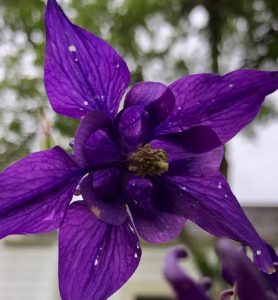
June 27
Though the reviews for we read for The Trip to Greece weren’t all that great (it’s the latest, and reportedly last, installment of the Steve Coogan/Rob Brydon BBC TV shows edited into feature films), we went ahead and watched the longer version on PAL DVD. After all, since we ourselves are not able to travel abroad these days, watching our generation’s Hope/Crosby duo play a pair of well-heeled bickering tourists seemed like a reasonable substitute. Amiably directed by Michael Winterbottom (as were all the previous Trip offerings), the experience was very much like a long-postponed meeting with old friends, the irritations of the encounter threatening to color the reunion more than its exotic pleasures. But wine-fuelled jokiness brought more than a few belly laughs — the Michael Caine / Sean Connery imitations in particular functioning as familiar comedic balm. It’s an odd premise: Coogan and Brydon play versions of themselves, with their real-life family and friends played by actors. Such a set-up would certainly fuel most performers’ neuroses, and it’s just this troubled underpinning that Winterbottom successfully uses to offset The Trips to Greece’s road pictures’ sweet silliness, the hint of bitter darkness giving depth to perfectly plated desserts.
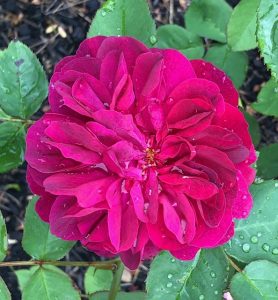
June 20
As this month’s issue of Vanity Fair attests, television has now overtaken the feature film in America’s cultural life. From our quarantine couches this past week we viewed the final season of The Deuce. The narrative seemed forced, and much of the acting was badly directed. But it was ultimately dispiriting in other ways, due to our own recalled experiences and associations from NYC of the eighties. Though the city’s representations came across as cartoonish, we nevertheless recognized the wolves of Wall Street, the post-disco club scene and, most tragically, the losses — personal and cultural — of the AIDS era. And as clumsy as The Deuce’s final sequence was, it eerily dramatized something of our most recent visit to the city’s present theater district (see our March 7 post below.) An aged James Franco visits the contemporary version of his old haunts, encounters flash-back memories of the departed, and finds himself thoroughly out of place in the now-Disneyfied Times Square.

June 13
On these early summer weekends especially, Longnook Road has become something of a bike path. We enjoy all the cyclists passing by but are particularly charmed by the helmeted children, chugging along just behind or ahead of their parents. They remind us of the quail families that used to cross our backyard. Perhaps this notable increase in bike traffic is due to the impending need for cars to display a Truro beach pass, or perhaps its energy is produced from recent release from the Commonwealth’s obligatory two-week self-quarantine. In any case, we think we detect a distinct sense of desperation accompanying this season’s sportier pleasures. Undertones for the coming season are ominous. But as for ourselves, these increasingly warmer weeks of isolation (like those bicycles) seem to be whizzing by.

June 6
The earliest settlers of Truro owned slaves. Even the colonial-era properties on Longnook Road numbered slaves among their households. This is not a fact that is often brought to local attention, as present-day residents tend to think that ownership of human beings was a scourge limited to the Confederate states. But there it is: Our lives of liberal privilege have deeply disturbing origins. We have been living in a protected delusion with, as only one element of a systemic problem, police officers having long been trained to prioritize the lives and property of white people. The video of a black man’s neck held down by the boot of an officer of the law has been a shock to many, resonating with our country’s long and mostly unrecorded history of lynchings. Publicly supporting, and standing alongside, Black Lives Matter is certainly a start; but a lot of soul-searching needs to go along with active political and social change. One relatively small first step is the acknowledgement of a historical reality not yet faced head-on by well-meaning citizens of the Outer Cape.
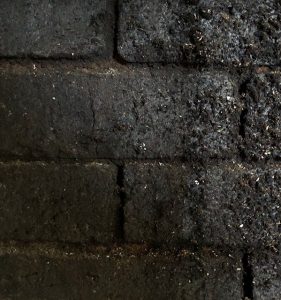
May 30
This spring on the Outer Cape has been as beautiful as anyone can remember. Following the snowdrops and crocuses came jonquils, johnny-jump-ups and grape hyacinths. The appearance of spring in Longnook hollow runs weeks later than elsewhere; other years we felt we were somehow “behind” with our last frost, but this year we appreciate the warmer seasons’ slow arrival. The fruit trees have bloomed; so have the planted garden’s late tulips; and now we have azaleas, rhododendrons and lilacs. Deep within the woods, like a bed of daytime stars, mayflowers have bloomed among the wild blueberries. For the past few months we enjoyed the lack of jet planes and the earth’s evident appreciation of fewer emissions. Is the air actually clearer, is the sky bluer than we remembered? Certainly wildlife is more active; we’ve been having daily interactions resulting in (mostly) bemusement on both sides. But we do want to remind the deer, turkeys and rabbits visiting (and tasting) our backyard that they themselves are technically edible. Times may get tough. In the meantime, during these magically quiet weeks, we’ve come to know better the hollow’s sparrows, catbirds and chickadees. But this bubble of enchantment won’t last. After Memorial Day’s tempo shift we detect the inevitability of summer — as well as heat’s potential for civil unrest. After dark we will soon hear not birds startled from their nested sleep but restless, open-windowed cars flying down to the beach.
May 23
Schitt’s Creek could be described as a comedic version of Ozark: Wealthy city folk are forced to move to the sticks and into considerably reduced circumstances with their two resentful children. In the funny version, the father is played by Eugene Levy; his wife is former Second-City colleague Catherine O’Hara. Ridiculous wigs and clothes play an important role in the proceedings, both the designer outfits of the imported family and the tasteless ensembles of the small-town natives. The show’s producer and writer is Levy’s son, Daniel Levy, whose own expressive eyebrows echo those of his father. Those four brows, each with a life of its own, almost play as a quartet of straightmen, gymnastically responding to increasingly absurd scenarios and characters. Daniel’s character, flamboyantly and unapologetically bi, turns out to be an appealingly tedious anti-hero, full of confused yet authentic feeling. Even the irritatingly silly sister ends up having a hippie-dippy soul brought forth by the challenges of her social step-down. The scripts have their share of groans, but when O’Hara lets out the Id of her ex-daytime-drama actress, the result is not merely screen-chewing so much as streamed chaos. Unfortunately most of the episodes’ directors have decided that a mother’s storms contradict TV’s feel-good intentions. But when she is allowed to throw one of her signature tantrums, the whirlwind of O’Hara’s face, voice and body re-enact what it must be like to picked up and spun around by a narcissistic volcano. This is supposed to be comedic, of course, but as with Ozark’s Laura Linney (see our April 25 post below), there’s real violence beneath thwarted female ambition’s forced smile.
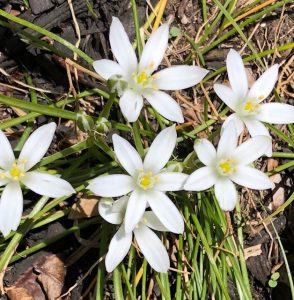
May 16
One of the best bits in Mary Maxwell’s “Biala in Provincetown” in the current PNReview is the little-known fact of Willem DeKooning’s visit to the Outer Cape in July,1949, a few years after his marriage to Elaine. (Janice Biala and her husband had hosted the couple’s makeshift wedding lunch.) It turns out that the painter got very drunk with an unnamed pal, ending up naked in Provincetown’s hurricane-imminent surf and then, arrested for indecent exposure, overnight in the town jail. Maxwell’s review of PAAM’s 2018 Biala show makes connections between Biala, Edwin Dickinson and De Kooning that take the exhibition’s local focus to international levels of interest. For one thing, it was Elaine and Willem who introduced Biala’s mentor Dickinson to a younger generation of artists (having him invited to the NY School’s “the Club,” getting him featured in Art News), an expanding network which led to Dickinson’s increased recognition and ensuing reputation as “an artist’s artist.” In addition, so Maxwell argues, it was De Kooning’s violently primordial Provincetown summer experience that contributed to the artist’s move away from architectonic urbanism towards the oceanic bravura of his works from 1950 onward. Those historical details alone, Maxwell concludes, should confirm Biala’s important presence in mid-century American art narratives.
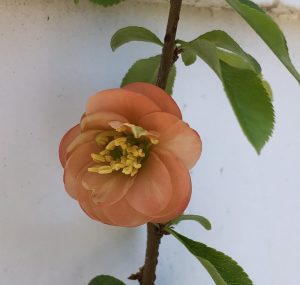
May 9
It’s not likely that anyone needs to be told that now would be a good time to read Proust, listen to Beethoven’s late quartets or revisit the films of Ozu. But one less familiar name easily belonging in that company is the French poet Yves Bonnefoy, whose collected prose is imminently forthcoming. We have been reading Carcanet’s facing-page translations of some selected poems (dating from 1953-2016) which came out the year after his death, and it’s hard for us to think of a poetry from any era either more pertinent or worthwhile. Here, some lines from “Le Puits” / “The Well” (translation by John Naughton) that capture the beauty and sadness of the present moment: Le voyage de l’homme, de la femme est long, plus long que la vie (Man’s voyage, and women’s, is long, longer than life) / C’est une étoile au bout du chemin, un ciel / Qu’on a cru voir briller entre deux arbres (It is a star at the end of the road, a sky /That was shining, we thought, between two trees). Quand le seau touche l’eau, qui le soulève, / C’est une joie puis la chaine l’accable. (When the bucket touches the water that lifts it up, / There is joy, then the chain overwhelms it.)

May 2
In this time of extraordinary social stress, as cultural critics we are divided between being upbeat and being honest. While what is presented on virtual platforms is clearly meant to inspire courage, what’s too often on display is the transparent neediness of its creators. Most days it appears to us that a very large percentage of the newly housebound have discovered their inner bard or rock star, and the rest of us are left to deal with it as diplomatically as possible. This may seem harsh and lacking compassion, but quoting the immortal words of Bob Dylan, Let us not talk falsely now. Nevertheless, at least in our take, the current era of sometimes clumsy sincerity is an enormous improvement over previous decades’ rampant “curation,” an era of galleried junk given import through highly dubious frameworks derived from critical theory. For whatever the end product, it’s feelings, not tactics, that ultimately matter. In any case, here at the LOOKOVER we’ll continue to recommend what we feel is really worth reading, viewing and listening to during this ongoing social quarantine. As the siren whine and tolling chugga-chugga of the great Jimi’s guitar won’t let us forget, The hour is getting late.

April 25
Ozark may not be great drama. Nevertheless we’ve found ourselves watching the three seasons assiduously, finding the Byrde family’s domestic situation unexpectedly comforting. For whatever domestic tensions have been exacerbated by the pandemic’s isolation, we’re still not at the mercy of Mexican drug lords, dirty union leaders and Missouri rednecks. The ever-surprising ability of the two parents (one an ambitious ex-political consultant and the other a crack accountant) to spill brains and outwit their nemeses for the good of their understandably dubious and ungrateful children does have an almost tragic quality. It’s black, black, black; in other words, all the characters’ behaviors seem to us consistent with human nature. Our favorite episodes are those in which each spouse secretly bribes their platitude-spouting marriage counselor, each using her proffered advice to manipulate the other’s emotions. It ends badly for the therapist. Deception, torture, murder, blackmail — given the shady characters the family is dealing with, these all seems like perfectly reasonable approaches. Stuck as we are on our couch, we get pleasure watching the violent ends that come to those able to take action. Unable to make plans of any sort to get out of our own predicament, we come away from the show pretty happy just to sit on our much-washed, blood-free hands.

April 18
The publication of Harry Mathews’s Collected Poems 1946-2016 by Sand Paper Press in the middle of February was apparently lost in the shuffle of the ensuing pandemic. Though its arrival was noted online by The Paris Review (with whom Harry had long association), this very important collection must seem a bit intimidating to younger poetry critics unfamiliar with Mathews. His career certainly requires a a certain amount of research and even revision of received narratives for him to be properly accommodated. The easy, but not fully explanatory, entrée into the poet’s work is to identify him as a first-generation member of the New York School, co-founding in 1960 the journal Locus Solus with John Ashbery, Kenneth Koch and James Schuyler. A more intimidating introduction could be made with the information that for many years Mathews was the only American member of Oulipo (the experimental ouvoir of Queneau, Perec, et al.….), using strict procedures as a mode of composition. Some of Mathews’s work is a bit challenging, but most of the Collected is not only intellectually pleasurable but immediately, and gasp-inducingly, delicious. Readers might be put off by our comparison to haute cuisine, but once past the off-putting maitre d’hotel of unfamiliarity and settled at an elegantly appointed table, the Mathews diner is in for some serious joy. Here, as just one fragrant drop drawn from seventy years of cellared poetry, we offer this sensuous little amuse-bouche, spoken through the voice of Elizabeth Barrett’s dog: My mistress never slights me / When taking outdoor tea. / She brings sweet cake / For her sweet sake, / Rough, luscious bones for me.
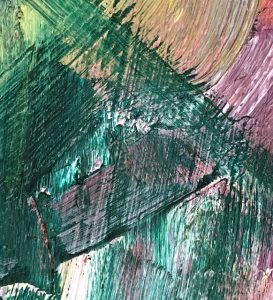
April 11
We have ambivalent feelings about the wave of recent arrivals to the Outer Cape. Mostly well-heeled individuals fleeing from the pandemic, they are inarguably also bringing it to our home ground. Most camping out in Truro and Wellfleet are tax-paying second-home owners, though quite a few, it turns out, are high-paying renters. Given the number of cars, bicycles and pedestrians on our street, it feels more like July than April. As year-rounders, we resent the increasing burden on local resources; most significantly we fear the hit our fairly bare-bones health-care system will be taking in future weeks. But having been mistaken for one of these urban escapees (our masks obscuring our local identity), we are not without compassion. We remember the influx of refugees from Europe to these shores during WWII and recall our moral obligation of sanctuary to those in need. Paradoxically, essential local business are booming. But it will be such locals who bear the brunt of this pandemic, their services to visitors putting them at the highest risk of infection. We bang our pans in honor of them all.
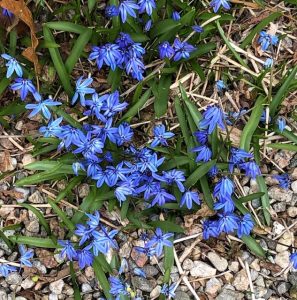
April 4
We gave up trying to understand the storyline of Westworld a long time ago, what with all the characters’ body-swapping and the scripts’ explanatory flashbacks. But watching the current season (week by week, and not on a binge) it occurred to us that the series’ shifting realities provided a useful analogue to our sense of the current poetry scene. For those unfamiliar with the show, Westworld began with a sort of adult theme park in which lifelike androids allowed guests to act out their Wild West fantasies. These simulated humans had been created by a management team of techies and businessman whose backstage dramas formed much of the material for early episodes; the creation and repair of the increasingly human “staff” carried viewers through following seasons. Even more troubling than the violent desires of the park’s client-visitors was the AI puppeteers’ cynical and market-driven manipulation of both androids and humans. We would struggle to explain exactly what’s currently going on, but one new twist is the possibility that any situation may turn out to be nothing more than a simulation perceived by a now-freed-from-the-park android. Reality may at any moment dissolve before our eyes. And that’s how most published poems feel to us: They read like android simulations. A product of writing programs and publishing industry hype, these manipulative formulations are generally very well crafted, or else they’re intentionally casual or even clumsy; in any case, the authors’ glycerine tears are meant to play as human. Most importantly, the system’s editors know their markets (identity politics) and how to work them. But for anyone who’s held on to their human ear, something vital has gone missing. And here’s where our comparison kicks in: If what’s out there is almost universally received as authentic, what chance do breathing, bleeding poems have up against the ageless faces of gun-toting robots?
March 28
Perhaps the commencement of a pandemic is not the best moment to make a pitch for classical texts. We certainly understand that at the end of the day what may seem most appealing is the literary equivalent of a CBD bubble bath. But in all sincerity the writer we find ourselves returning to is Thucydides. Himself the survivor of the plague which followed the Peloponnesian War, he observed first-hand the deeply disturbing social and political behaviors that appear in times of social stress. But perhaps even more prescient (as well as more accessible) than the classical Greek is the translation penned by Thomas Hobbes in 1629. Hobbes was doubly blessed. He lived in the age of Shakespeare, Bacon and the King James Bible, but he brought to his works a very particular stylistic genius. His Thucydides translation is a masterpiece of English prose. From such lessons of history, what have we learned about human nature? Men are driven by fear; by concerns about political reputation and power; and by the possibility of personal profit. Certainly these are the motivations of Senate Republicans in delaying a Federal response to Covid-19. As Hobbes observed in his preface: “[Thucydides] noteth the emulation and contention of the demagogues for reputation and glory of wit: with their crossing of each other’s counsels, to the damage of the public; the inconsistency of resolutions, caused by the diversity of ends and power of rhetoric in the orators; and the desperate actions undertaken upon the flattering advice of such as desired to attain, or to hold what they had attained, of authority and sway among the common people.” Disunity and factionalism, in the thinking of Thucydides, was the ultimate cause for the downfall of democratic Athens. It’s high time for our present-day Democrats (I’m talking to you, Bernie Bros) to acknowledge this unchanging truth and behave accordingly.
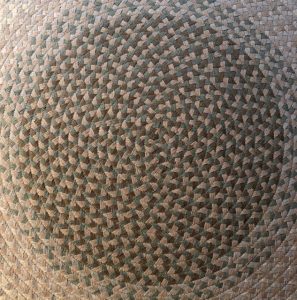
March 21
Certain writers thrive under restriction. When London theaters were closed down in 1593 in response to the plague, for example, Shakespeare penned his verse narrative, Venus and Adonis. By happy coincidence David Zwirner Books recently brought out an edition of the poem translated into Dutch, with illustrations by Marlene Dumas. We can’t judge the prosody of Hafid Bouazza, but we love Dumas’s erotic visualizations. A very loose interpretation of Ovid, Shakespeare’s take on the myth turns Venus into an immortal Cougar, a woman both articulate and assertive about her attraction to the handsome yet reluctant hunter Adonis. In Ovid’s version, Venus doesn’t even like the chase (it’s not good for the complexion, she says), while in Shakespeare she becomes a kind of huntress herself for “she cannot choose but love.” There’s a lot in the poem about the the perversities of desire, about the irresistible appeal of kisses denied and deferred. It’s really very contemporary, with the ultimate goring of Adonis by a boar distinctly suggesting the violent implications of the sexual act itself. Dumas channels all this into suggestively liquid near-abstraction. It’s easy to see why this early soft-porn work of Shakespeare was an immediate hit, especially when most of England was housebound. So, as Cole Porter would certainly agree, these days of social distancing are a perfect time to “brush up your Shakespeare.” The classic text, either first encountered or returned to, is a voluptuous escape into verbal pleasure: “ Even so she kiss’d his brow, his cheek, his chin, / And where she ends she doth anew begin.”
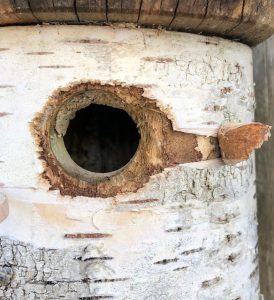
March 14
As readers of the LOOKOVER are well aware, we’ve long been dubious of the concept of “virtual literary community,” a term too often interchangeable with social network “backscratching” and “logrolling.” But in the the face of COVID-19 we are softening our stance. As many have observed, there is extraordinary paradox in the fact that social distancing has become an expression of community concern. Physical non-engagement is a form of compassion. For ourselves, in place of interaction with other people we are increasingly grateful for the presence of nature. The effect of sunlight on emerging hyacinths today is especially extraordinary. The moon and stars last night seemed to us more remarkable and magical than ever. The beach is source of physical beauty and infinitely unspooling music, whose calming effect has never been more welcome. And so we reach out to our virtual colleagues here, reminding them not only of the natural world’s solace but also of the ever-accessible fellowship made possible through art and literature.
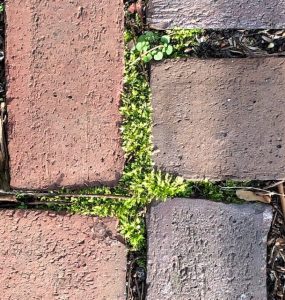
March 7
Just as the presence of the coronavirus was first being confirmed in Manhattan, we found ourselves holding once-in-demand tickets to see two Broadway shows. 1) Would it be worth facing down a pandemic to see see Patti Lupone perform “The Ladies Who Lunch” in Steven Sondheims’s Company? 2) Would the black humor of Martin McDonagh’s Hangmen hold up in the face of what feels like a contemporary Black Death? Though as we write we’re still within the CDC timeframe for appearance of first symptoms, our tentative answers are 1) yes, and 2) definitely yes. The company of Company (technically still in previews, though the Olivier-winning production had a run last year in London) was furnished with solid pros (Grammy-awarded Katrina Lenk, for example, as the gender-swapped lead). Almost all of its songs are now standards (one reprised by Adam Driver at the end of Marriage Story), so the show’s consistent excellence really came as no surprise. Hangmen seemed like less of a sure thing, though the awards of its cast would fill a barn. It was classic McDonagh (In Bruges, Seven Psychopaths, Three Billboards Outside Ebbing, etc.), with superb actors whose faces seemed vaguely familiar yet unplaceable without reference to the show’s Playbill (“Downton Abbey,” “Game of Thrones,” “The Americans,” etc.). One particular pleasure was the anti-ingenue played by Gaby French, a role in which French seemed to be heavily treading water until delivering her eleventh-hour whopper of a monologue. That’s the McDonagh actor’s specialty: First a long pause within which it’s just possible lines have been lost; and then, slow at first but soon at full speed, comes those signature strings of increasingly hilarious sentences, one after another landing like a series of deadly bat-whacks upside the head.
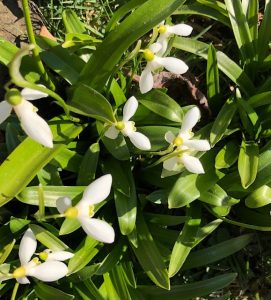
February 29
The ability to download a variety of televisions series has definitely been a mixed blessing. In some sense, familiarity with certain programs has become a kind of intellectual necessity; otherwise we’d be missing even more cultural references and becoming more “out of it “ than we currently are. And so out of some grim sense of social duty we’ve survived endless evenings of The Deuce, The Rain, You and follow-up seasons of The Handmaid’s Tale. In the middle of all this grimness, one source of slant amusement for us has been the show Barry, which has provided exactly the kind of citric humor we’ve needed to cut the muddy taste in our mouths. Basically it appropriates the tone and take of Elmore Leonard in its dramatization of hoods and Hollywood, somehow making military PTSD and acting school narcissism both hilarious and poignant. Highly recommended.
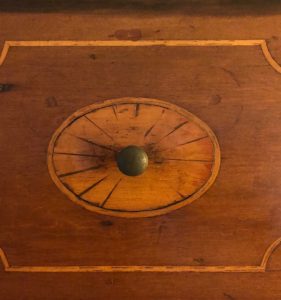
February 22
One of the charms of living in a small town on the Outer Cape is the opportunity to go oystering on a winter Sunday. A Truro shellfish license, obtained in person at the Town Hall, is available for a nominal fee for residents (free for seniors). Besides the obligatory Day-Glo lanyard, the resident is given a device for measuring (smaller oysters are to be left in their beds). Even setting aside the gratis bounty of the effort (as well as the friendly encounters with fellow off-season inhabitants) there is the beautiful, albeit cold, winter seaside of the outing. The word fortunate only begins to capture our situation.
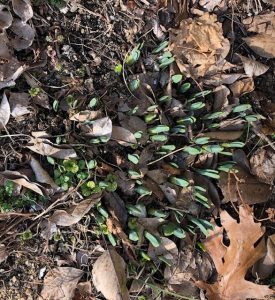
February 15
We had such bad seats (far off to one side) for the late-December premiere of the Met’s William Kentridge production of Wozzeck that we were deprived of a good proportion of the dramaturgy. We could have gone to the simulcast a few weeks later to see what we’d missed but were afraid that the actual yet imperfect theater experience would be effaced by the cinematic. Such was our anxiety — this even though within the production itself there were embedded “virtual” forms of filmed image, alternately shadowing and invading the three-dimensional stage and theater. Life itself has become like that with its alternation of realms, screens in hand or above keyboard throwing images on our days and nights. But that evening the brilliant director, alongside his extraordinary performers, was there in actual person for the curtain call. We found that moment alone, our hands smarting with applause, worth every penny of the evening’s not inconsiderable cost.
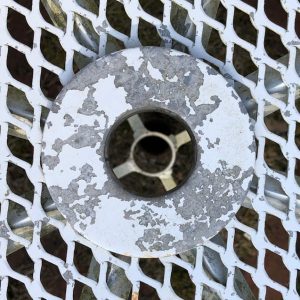
February 8
Our new local newspaper,The Provincetown Independent, has (literally!) delivered on its promise of community. Now that we no longer have a child in the local school system, here in Truro the most active locus of winter socialization is the post office (there is no USPS home delivery). But with the weekly arrival of the Independent, we are kept apprised of what’s going on here and in the Outer Cape’s other towns. We really like the physical reality of the newspaper. Although there is an abbreviated online version, we are finding that virtual networks increasingly bring us more disquietude than information. By contrast, the Independent in our post office box arrives as a form of affirmation.

February 1
For us on of the greatest joys of travel is the unanticipated encounter with new art. At the Pérez Art Museum in Miami we were wowed by Elemental, the nearly museum-wide exhibit of Teresita Fernández. The artist’s “subject” is landscape, but her landscapes are subject to an exquisite alchemy. In the case of “Fire,” this sense of chemical transformation feels quite literal, a ring of silk string flames flickering as the viewer circles the installation. “Charred Landscape (America)” evokes both a burning California and the burnt element which is is the artist’s drawing charcoal. Similarly, graphite and gold are sculptural media with complex ecological and historical meaning. But perhaps the most viscerally beautiful pieces to our eyes were those of the Viñales series, glazed ceramic malachite evoking the landscape of imagined caves. Ultimately, none of this can be properly described or even reproduced in photographs; our failed words here make us even more grateful for the accident of such a superficially gorgeous, yet deeply thought-provoking, art experience.
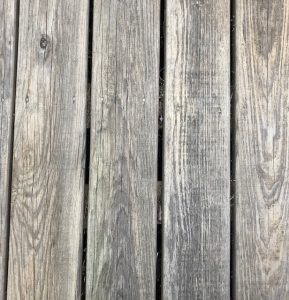
January 25
Given the weather that evening, we wondered whether having gotten tickets so far in advance to hear Terence Blanchard (featuring his E-Collective) at Berklee Performance Center in Boston had been such a great idea. And while the city streets and sidewalks did indeed become icy, Blanchard’s cool sublimity was worth every anxiety. There were times, in fact, when we became aware that we were listening to some of the most beautiful music we’ve ever heard. And while much of the performed work was powerfully allusive, gunfire and social fear expressed in sound, other improvisations transcended time and place. Maybe because Blanchard is a veteran of Art Blakey’s Jazz Messengers we couldn’t help thinking of him and his young colleagues as a band of soulful angels, hearkening rhythmic good news and melodies of hope. Certainly the spirit was with him and his diverse cohorts last Saturday night.
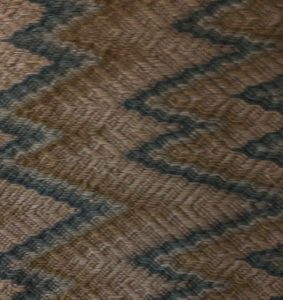
January 18
Why did no one tell us that The Ballad of Buster Scruggs is a cinematic masterpiece? Due to its limited theatrical release and sole availability on Netflix, we only just got around to watching the Coen brother’s latest. We have a particular affection for “omnibus” movies, a genre favored by the the great Max Ophuls and Alberto Cavalcanti, among others. And as a matter of fact, we saw a lot of Ophuls in Buster Scruggs — from the Western echoes of Lola Montez’s ending to the Maupassantian Le Plaisir quality of the Coen brothers’ screenplay. We also fully appreciated the humor of substituting La Ronde’s introductory narrator Anton Walbrook with the goofily brilliant Tim Blake Nelson. Heartbreaking Ophulisan irony suffused “The Gal Who Got Rattled,” its sweetly doomed heroine evoking Liebelei. And both the creepy “Meal Ticket” as well as the films’s final episode, “Mortal Remains,” are worthy heirs to Cavalcanti’s Dead of Night. Do our relatively low expectations explain our response to the movie? Maybe, but in any case we were astonished.

January 11
While we certainly enjoyed the main room of the Duane Michals exhibit, “Illusions of the Photographer,” at the Morgan Library, we must admit that we were most taken by one of his early short films being shown in the museum’s marble foyer. Undoubtedly we were affected by the endless and seemingly insurmountable crowds of midtown Manhattan during the holidays, but Michals’s 1965 Empty New York was for us neither haunted nor melancholy. Instead it just seemed simply wonderful to be able to wander the black-and-white city streets and look at buildings and objects in unjostled quiet. Though the images felt at times like meditations on mortality, we did not experience them with anxiety but instead felt something like sweet reassurance as we floated in the timeless dimension of the no-longer living.
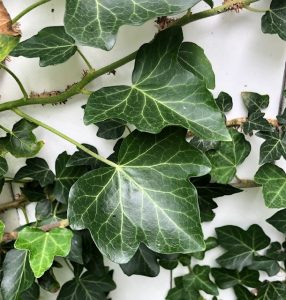
January 4
We have been watching four television series written and produced by women which, to put it mildly, do not reflect well on contemporary relations between men and women. In fact, Fleabag, Russian Doll, Big Little Lies, and Unbelievable share one distinct insight into contemporary life: Most women experience some form of patriarchal abuse and/or sexual assault, encounters which too often result in extreme coping mechanisms. Such events sometimes lead to sociopathic modes, though more often the trauma ends in varieties of self-destruction. We’d like to be able to say that these shows are merely works of the imagination and have no real correlation to actual lives. We would like to be able to assure ourselves that such tales are all just made up, but the shared stories of our female contemporaries only confirms the troubling picture this past year’s melodramatic television “fictions” present.

2019
December 28
Some years ago we greatly enjoyed Palio, a 2015 film documenting the oldest horse race in the world. Still taking place each summer in Siena, the fierce competition is one in which neither the best horse nor the most accomplished rider necessarily wins. Victory, instead, is determined by back-room payoffs and extensive cheating, as well as elaborate tricks intended to cause handicap to the more excellent. In other words, it’s a lot like contemporary PoBiz. In a recent Wall Street Journal (to provide one recent example of such dealmaking), a prominent journalist had the nerve to recommend as one his year’s “best reads” a far-below-par memoir by a fellow Outer Cape resident. He did so with no embarrassment at all, even though a quick google of the two unusual last names would reveal the memoirist’s part in getting the poetry of the journalist’s wife published. Besides seeing the wife’s not-that-great poems into print in the literary journal he edits, the memoirist-poetry editor additionally provided a blurb for her first (and so far, only) collection, praise which is still up at her publisher’s website. To top it all off (and to close the Palio-like circle), the poet-memoirist immediately posted the journalist’s WSJ shout-out on his own homepage. These are not trophies we would be proud to display. We can only think of Dante’s encounter with Brunetto Latini in the underworld (who, despite his eternal damnation, “seemed to be the winner, and not the loser”), calling to mind the poet’s sage advice (which we are here ignoring) about the types of individuals encountered in literary life: “To know of some is good; but for the rest, silence is to be praised.”
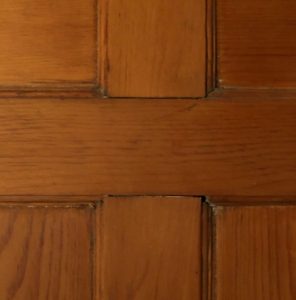
December 21
The Pilgrim Congregational Church in Harwich is the venue where the Cape Cod Chamber Orchestra performed its holiday program, A Mostly English Holiday, last Sunday afternoon. Sticklers might have corrected that to “A Mostly Welsh Holiday,” as Vaughn Williams and the little-performed composer Grace Williams both hailed from Wales. But in any case, it feels entirely appropriate that the ocean resurges as an ongoing theme in the orchestra’s programming. (We appreciated how Williams’s Sea Sketches neatly recalled Sam Wu’s commission—see our October 26 post.) Appropriate, too, how the window above the altar shows Christ, friend of fisherman, in front of the sea of Galilee, the central figure framed by stained-glass shells and sea creatures. Over the years the 1854 church steeple has functioned as a beacon for Nantucket Sound mariners. After the concert we took a stroll down the lane running alongside the building, a road leading to the Atlantic itself. There we arrived just in time for a spectacular winter sunset.

December 14
We recently spent a two days in Salem to see the terrific Hans Hofmann show at the Peabody Essex. The museum has done a spectacular job in presenting the pure joy of painted color. But Salem in itself is a very interesting place, with some good restaurants and nice places to stay, charming streets and elegant colonial architecture. We stayed in a room in which George Washington once slept! And then there are the witches — or more correctly, Wiccans. Shops sell herbs and candles for the casting of spells (for healing, for inciting passion, for getting rid of a neighbor). A bronze statue of Samantha from Bewitched has been erected just up the street from a lovely shop called Hauswitch, full of magical cleaning products said to promote, among other things, the fight against homophobia and the patriarchal oppression. Resistance takes many forms. Halloween is the primary holiday for the town, but Christmas must also feel sneakily victorious for those in tune to Paganism, given all the druidic trees, holly, and mistletoe decorating even the churches.
December 7
Leonardo: A Life in Drawing traveled throughout the UK this past year, ending up at the Queens Gallery at Holyroodhouse in Edinburgh where we were fortunate enough to see it. The beauty and technical skill of da Vinci came as no surprise though, seeing so many of his interests noted in once place, we were nevertheless taken aback, yet again, by the maestro’s endless curiosity. The movement of water. A map of the Pontine marshes. The muscles of the upper spine. Court costumes. The hands of Saint Anne. We couldn’t help but think that these days, five hundred years later, he would likely be criticized as “unfocused.” It was also touching to realize how, very much in the contemporary manner, so many of his ambitious projects remained unfinished (failure of funding, political shifts, bad publicity, etc.) Even the genius Leonardo didn’t have the smoothest time of it, born illegitimate to a pretty Tuscan peasant girl and haunted by visions of an apocalyptic deluge at the end of his days. While on the earth, nevertheless, it would appear he was something of a joyous bon vivant. One line, delivered deadpan, from the excellent catalogue made us laugh out loud: “Leonardo took delivery of a barrel of wine as part payment for this work, but the painting remained unfinished.”
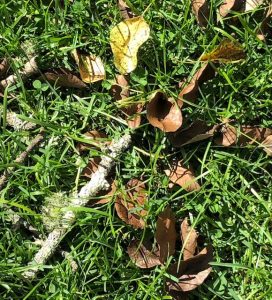
November 30
We recently returned from the UK (mostly Scotland, though with airport stops in Dublin and London) only to find ourselves watching that most British of products, the third season of The Crown. It is, as the Royals themselves might quip, as insupportably dull as the Queen herself. But it does have a certain fascination, being a prelude of sorts to our generation’s Lady Diana narrative. On the flight home we watched the Elton John biopic, Rocketman, and thought how much his music provided a musical score for the late princess’ life and times. The prequel television show is propaganda, of course, meant to make us feel for the ongoing emotional burden of the Windsors. But moving to the present day, on the other side of the pond we were made aware that certain older citizens of the Commonwealth believe that the “trashy” Meghan Markle spells the end of an golden era. But even with the best location shots and lighting, the story of the British monarchy has never been all that burnished.
November 23
We used to like Jim Jarmusch. And then we saw The Dead Don’t Die and wondered what had happened. For as much as we tried to enjoy its clumsy stupidity, the movie ended up being merely clumsy and stupid. But since we’d heard interesting things about American poetry and poets as presented in his 2016 Paterson. we thought we’d give it a try. We found that nearly as idiotic as his zombie film, full of mistaken ideas and some of the worst poetry we’ve ever encountered. We’d hoped to gain some sense of what it might mean to be a poet in contemporary America but instead was presented with a bus driver whose daily insipidity was narrated as ore to be mined and turned into poignant verse. The very worst moment came near the end when, having had his notebook of poems (mercifully) chewed up by a bulldog, the bus driver-poet encounters a Japanese tourist, there to visit the hometown of William Carlos Williams. They have an awkward exchange about Jean Dubuffet, who is described as a meteorologist (this from a Frank O’Hara line referring to what Dubuffet had done during military service), leaving viewers with the hilarious idea that Dubuffet worked as some kind of weatherman, all the while painting his art brut. Filmmaker, schoolgirl, bus driver, cupcake baker: We appreciate the idea that anyone can write poems, but the movie makes a pretty poor case for it.
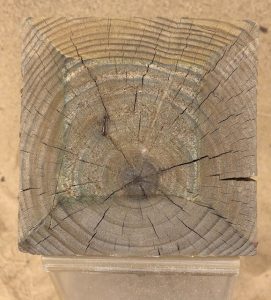
November 16
David Rothenberg’s Nightingales in Berlin: Searching for the Perfect Sound is a book close to our hearts. The music prophet Neil Young has warned of the long-term impact of inferior recordings, most notably the auditory dumbing-down brought on by digitalization. This, as well as the threat caused by Earth’s increasing noise pollution, is cause for serious concern, for the quality of the planet’s sounds has implications beyond musical ones. Alongside whales, dolphins and songbirds, humans learn through sound. And on both the literal and figurative level, then, the contemporary poet must admit identification with the plight of the nightingale, a creature that in the poetic tradition has long served as a model of skilled singing. According to Rothenberg, the nightingale’s song is “loud, long, intricate, structured and musical — an extreme example of what evolution can produce through sexual selection, as generations of female birds have preferred increasingly refined and nuanced songs.” Yet these masters of song are having to sing louder and louder to be heard over the noise of contemporary life. So, too, instead of composing increasingly complex poems, in order to be listened to we also are being forced not to sing but to Tweet.
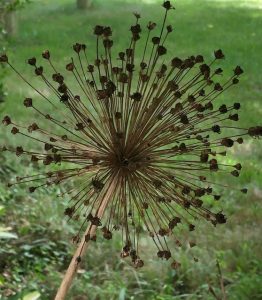
November 9
We are sorry to miss the special exhibition at the Art Students League of New York, Postwar Women. Serena Rothstein could have easily been included in the show (alongside Bourgeois, Frankenthaler and Biala), as she was among the numerous female artists who studied there in both the pre- and postwar period. In fact, Rothstein’s student work was included in the textbook of her teacher, Kimon Nicolaides, The Natural Way to Draw (1941). (One of Rothstein’s lovely line drawings graces the LongNookBooks ad now appearing in The Provincetown Independent.) Among the recent wave of “rediscovered” women abstract expressionists, such important work is forcing a serious adjustment to the received narrative of American painting. “KNOW YOUR FOREMOTHERS” as the show instructs its visitors and art students. Rothstein’s drawings and paintings may also be seen on the pages of this website; on the covers of several of our poetry collections; in our monograph, Serena Rothstein, Discourse in Paint; as well as, most relevantly, on the pages of Personages, the center section of The Longnook Overlook. These astonishing figure studies were themselves most likely completed at New York’s Art Students League.

November 2
We are thoroughly convinced of the therapeutic qualities of live music. Last week we heard the Boston Symphony Orchestra perform Debussy’s La Mer, wonderfully conducted by Susanna Malkki. It was a something of a curious coincidence to hear it live, as composer Sam Wu referenced the piece as a source for his Samuel Bellamy (see last week’s Lookover). The resonant concert hall, where it was first performed in America 1907 just two years after its French premiere, functioned like an enormous “sound bath” with a full stage of orchestral performers — a complete set of strings, two harps and the BSO’s astonishing wind and brass section. Also performed was the contemporary Dieter Ammann’s piano concerto, which to our ears was something of a bracing cross between Gershwin (American in Paris) and Varèse. More modest but spiritually invigorating were two short but exquisite pieces by Fauré (“Pavane”) and Messiaen (“Alleluia on the Trumpet, Alleluia on the Cymbal” from L’Ascension).
October 26
LongNook Books is delighted to join as a supporter of the recently formed Cape Cod Chamber Orchestra. This past Sunday’s concert “Haydn the Pirate,” energetically conducted by music director Matthew Scinto, was both entertaining and persuasive. We have to admit we were initially dubious, as “pirates” from the Cape’s Whydah Pirate Museum greeted us at the door; uh-oh, we thought as we braced ourselves for hokiness. But from the opening Sibelius, through Rameau, and ending up with Haydn, the collection of young musicians delivered a very high-level performance. (In fact, if we had any quibble, it would be the ultra-professional consistency of the group’s contemporary performance practice. ) The wide-ranging concert even included a piece by rising composer Sam Wu, titled Samuel Bellamy, A Portrait. Ostensibly a wordless musical narrative based on the life of Eastham’s “Black Sam” Bellamy, for us its true main character was the Atlantic itself, a subject full of power, pathos and tenderness. Wu’s evocative treatment, we would argue, cries out for expansion into a full opera. The concert’s pirate theme returned once again for the encore, with a movement from Les Indes Galantes reprieving as a nautical chantey, à la Pirates of the Caribbean. It was goofy, but we laughed and ended up very much appreciating the afternoon’s humor and high spirits.
October 19
We are great admirers of Lewis Hyde, especially his 1983 The Gift, which has just been republished by Vintage. And we are especially grateful to him for his online gift of The Oxherding Series, available for free download at his website. These are a set of of ten medieval Chinese poems, given in various forms of transcription and translation (alongside collaborative sumi ink images by the painter Max Gimlett) presenting a parable of Buddhist practice. The poems’ way to an apprehension of the true self are forms of paradoxically cultivated attention and indifference. Two essays by Hyde give background and explanation for the project. But although we’ve given his recent A Primer for Forgetting several readings, we remain unconvinced by that book’s thesis. Hyde’s proposes that the skill of forgetting is as important as the ability to remember. Perhaps the major stumbling block for us is his “scrapbook” form, an approach which suggests a thesis rather than actually proposing one. Hyde himself declares himself “weary of argument” and offers instead a set of free-associative examples. We could articulate some of our specific disagreements here (on the problematic matter of laws requiring official forgetting, for one thing); nevertheless we find ourselves recommending a book we ultimately disagree with. It must suffice to say that we recognize how Hyde might perceive memory as analogous to the self’s thought-grasping habits. Nevertheless (and blame it on our monkey minds if you must) we just can’t accept oblivion as a form of enlightenment.
October 12
LongNookBooks would like to congratulate Anne Carson for not winning the Noble Prize for Literature. And we mean that in all sincerity. Though Carson was the Ladbroke’s odds-on favorite, that most excellent (albeit most oft-incomprehensible) of poets has evaded, for this year at least, the mediocrity of the prize winner. A review of Nobel recipients — or a list of the Pulitzers, the National Book Awards, the Bollingen, etc. — confirms our sense that the conferring of such a laurel upon one’s head is the artistic kiss of death. There are exceptions, of course (Beckett being one figure to prove the rule). But what these prizes most likely indicate is that the winner has successfully navigated the literary and publishing world’s bureaucratic system, a publicity machine that latches onto whatever it thinks might sell. (Libraries! Classrooms!) This in itself is no mean accomplishment, we fully acknowledge. But we also extend our congratulations to Cees Nooteboom, to Ngugi wa Thiong’o, to Patti Smith, to Roberto Calasso, to Tom Stoppard, to Margaret Atwood, to Pascal Quignard, to Frederick Seidel, to Giorgio Agamben, to Péter Nádas… That happy list is endless.
October 5
Coming up next week is a reading at the Prince Street McNally Jackson bookstore with the title “Appalachian Renaissance,” a term once used to describe a late-seventies literary phenomenon associated with poets like Charles Wright, Fred Chappell and Maggie Anderson. Publicity for the event speaks of “a generation of writers in the Appalachian region who were college educated and thus aware of, and often students of, literature,” a described collective, we infer, to which the reading’s three featured West Virginians also belong. As has been said of “Appalachian Literature,” it’s not necessarily a matter of where someone was born, but more an issue of the region’s thematics — family, storytelling and distinctive landforms. If such a poetic “renaissance” is ongoing, we’d certainly include Maurice Manning and Kate Daniels in the movement. And if the pressing topic of the effects of the “extraction of natural resources” is included in the mix, we would certainly be making note of Mary Maxwell’s 2018 Oral Lake. Identified by editor Dave Smith as a “New Southern Poet” in an issue of The Southern Review back in 1995, she returned to her West Virginia origins occasionally in her first two collections. But solidly beneath the chantable lines of Oral Lake (an actual locale near her hometown) is the haunting and problematic West Virginia landscape’s “potent fossil fuels, mined and drilled so the rest of the world may proceed with dual-edged, post-industrial modernity.”

September 28
The television series The Man in the High Castle is basically a pseudo-historical soap opera, but it is one with an interesting narrative structure. An imagined tale of what life in America would be like had the Nazis won the war, one of its subplots involves a nose-holding alliance with subservient Japanese bureaucrats on the Pacific coast. Within that fiction, characters smuggle cans of film images showing another possible version of events, that version (the Allied victory) calling on actual, familiar historic footage. As viewers of the series, we live in the future America of those contained films, the show’s alternate reality. Yet it’s the wholly imagined American-Nazi fascism that comes scarily close to our current daily experiences, in awful ways no one could have anticipated at the real war’s end. Women’s lives continue to be limited by male-directed political policy; Neo-Nazis and white supremacists express themselves without official censure; anti-Asian bigotry passes as harmless joking; police brutality is justified as necessary for public safety. In short, we see hyper-dramatized, extreme versions of ourselves, individuals having to negotiate present political situations. In both cases, personal ethics and human experience determine each character’s level of resistance or collaboration.
September 21
We were among the packed audience that heard and saw “Koyaanisqatsi Live! “ yesterday at Boston’s Orpheum Theater. Performing the musical score to Godfrey Reggio’s 1982 film were the 82-year-old Philip Glass himself and his Philip Glass Ensemble. Uncomfortably perched in our balcony seats for two hours, the event made us intensely aware of the passing decades of our own adulthood. Life on Earth is even more “out of balance” (the meaning of the piece’s Hopi title) than it was when we first saw the film. The security at the door of the theater was comparable to that of international air travel; most of the waiting audience seemed to be on their cellphones up until the last moment, with quite a few texting all the way through the performance; the shores of Cape Cod to which we drove the next day have receded in the intervening years not by feet but by multiple yards. The evening was beautiful in its way but profoundly sad; we felt we’d attended our own communal funeral.
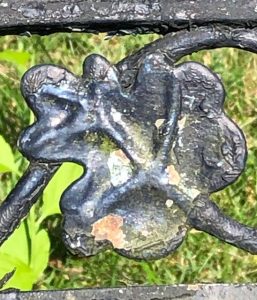
September 14
In accord with the bicentennial of Melville’s birth on August 1, the Library of America has brought out a volume of his Complete Poems. For years we relied on Robert Penn Warren’s excellent 1970 Selected Poems, meaningfully dedicated to John and Anne Hollander. For many seasons we held Warren’s eloquent introductory encomium next to our hearts: “Only after man has passed the hour of total rejection may his soul be ‘born from the world-husk’ and learn to ‘stand independent.’ ” The centerpiece of the Library of America edition is a complete version of his monumental epic poem (a triumphal failure), the eighteen-thousand-line pre-modern Clarel. As Warren put it, “the thousands of vivid images and rhythms” in Moby Dick ’s poetry-in-prose indicate “nothing of the direction Melville would follow in the the development of his poetry-in-verse.” In light of all this, we must make known our disgust about the publication of Herman Melville’s Moby Dick Hidden Treasures: Found Poetry, published in 2016 by Provincetown Arts Press. Prose sections from the great novel have been by “transitioned” into poetry by “discoverer” Stephen Durkee. No mention is made of Melville’s actual poems, save in a creakily close-reading “Proem” that quotes not Melville’s own lyrics but lines from Warren’s Selected introduction. At best, the volume presents an interesting exercise in failed line-breaking. It illustrates beautifully how complete lack of prosody is actively encouraged by the current workshop process; its students literally don’t know the difference between poetry and prose.
September 7
To follow up on our August 17 post, we report on the arrival of Eric Ormsby’s translation of Goethe’s West-Eastern Divan, brought out by Gingko Press. As the publisher of its nearly six hundred bilingual pages explains, “The wit, intelligence and humour of the technically superb poetry created for [Goethe’s] Divan tends in rhymed English verse to lose it energy and edge, and so Eric Ormsby has made a clear modern prose translation.” The word divan (meaning “collected works”) is of Persian origin, and originally meant a register or record. As Ormsby notes in his introduction, “The word has passed into European languages to designate border and customs controls, e.g., douane in French or dogana in Italian.” For us, this early meaning provides a nice analogy for passing from one language into another — from the Persian landscape of Hafiz’s songs to the German of von Hammer (who provided the the trot used by the great poet) and on to Goethe’s ultra-European collection of lyrics. If we describe Ormsby’s contemporary Englishing as a guidebook, we don’t mean to diminish the scale of his accomplishment. Nevertheless, we so appreciate the translator’s formal modesty, how he allows his careful “unpoetical” prose to cede to Goethe’s sound-shapes. This is a major event in world poetry, so far as we can tell, yet unacknowledged. And so we are proud to to be among the first Americans to laud this extraordinarily significant (and significantly international) volume: Whoever wants to understand writing poetry must go to the land of poetry.

August 31
We attended the first of Stephen Fry’s Mythos, a three-set theatrical event happening at the Edinburgh International Festival. As he himself joked, he’d now graduated from the Fringe to the International, from young man to old, from the raw/innovative to the slick and/or stodgy. And the show was a bit stodgy, with Fry mostly sitting in a leather chair telling us about classical mythology. A storyteller, he presented himself, with all of us gathering around an imaginary fire to hear the old tales. It really wasn’t theatre. It was, however, completely consistent with a certain British tradition of the enthused amateur, like certain of those old BBC television series exported to PBS. For those old enough to remember, Fry came across as a kind of Kenneth Clark, Jacob Bronowski, Jonathan Miller, or even Wendy Beckett, teaching us all kinds of things we really ought to know. And though, like the donnish uncle, he did go on a bit too long (the thing lasted two and a half hours) and awkwardly tried to make it “user-friendly” with a certain amount of audience participation, as a evening of “Classics Lite,” it was nevertheless entertaining enough.

August 24
The Bridget Riley exhibition at Scotland’s National Galleries is an eyeful. When we say it was at times painful to look at, we mean it literally; certain rooms recalled the sensations following an eye exam’s dilation. This physiologically raw reaction made it hard for us to consider the more intellectual implications of Riley’s work, which have to do with visual perception. The room of small-scale studies were particularly revealing of Riley’s thinking and method. We find many of her mind-bending canvases truly beautiful, especially those that take a hanging canvas and create the impression of spatial relation, of entry into another dimension. Her actual three-dimensional Continuum, as she herself felt, is a bit of a fun house and “too literal.” We can see why a lot of people like her work immediately. Frankly, her color walls feel a lot like large-scale fashion design — Missoni, say, or Marimekko. For us, it’s very hard to separate Op-Art from a certain time and place, and therefore discount it as faddish. In the case of Riley, we know this is unfair, as she is undoubtedly a very serious and intelligent artist. And so we very much look forward to reading more carefully her Learning from Seurat, which we brought home from Edinburgh in our expandable luggage, fully weighted with our purchased books.
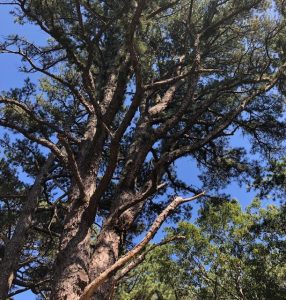
August 17
One lesson we learned at the Edinburgh Book Festival is that the Scottish people buy books, lots of books. And their reading choices are international. We attended two of the festival’s panels, one on “Home,” with the poet Robin Robertson, as well as a second, also with a brooding Robertson, on Goethe’s 1819 Divan. Speakers on both noted the impending political; there’s the matter of immigration, of course, but other forms of alienation expressed themselves. Literature affords a dialogue across the expanse of “foreignness” via the translation of a poetic text, Goethe’s engagement (in translation) with the ghazals of fourteenth-century Persian poet Hafiz being the immediate case in point. While a new translation of Goethe’s 200-year-old German text has yet to arrive to us, Gingko Press’s handsome collection of poetic and essayistic responses, A New Divan: A lyrical dialogue between East & West, meaningfully engages with linguistic and cultural “others.” Contemporary Moroccan, Iranian, Syrian, Arab, Iraqi, Turkish and Palestinian lyrics pair up with those of European colleagues, all translated by an impressive list of American and British poet-translators. It all makes for a wonderful volume.

August 10
One highlight of our summer was the reading given at the Wellfleet Public Library by Kate Daniels and Karl Kirchwey. There’s a lot of poetry being written just now; mediocre verse invades our mailboxes and inboxes. There are also a terrifying plethora of reading opportunities. In the face of this sometimes monstrous self-expressive and self-promoting reality, Daniels and Kirchwey distinguish themselves not only by their impressive accomplishments but by their current projects. Daniels’s recent work addresses how the opioid epidemic is tearing away at not just our communities but our shared humanity. Kirchwey’s continued ability to make the past newly relevant suggests that hope is not only to be found in the future. Both poets (as Daniels puts it) write from “deep / in the center where language peters out / and words merge new territories.” When so much contemporary poetry does nothing for us, it was galvanizing to re-visit what sometimes feels like a distant homeland, the country of art’s possibility.

August 3
Provincetown in the summer is a carnival — and we mean that literally. The season’s extraordinary variety of readings, club shows, and art openings is truly remarkable; no one can do everything; every weekend posits a social conflict. Among the events of this July of which we make particular note are the annual appearance of Provincetown Arts (this year our LNB ad graces the inside back cover; the Fine Arts Work Center’s annual fete (held up at the breathtaking Pilgrim Monument); and the solid Jim Dine show at GAA gallery’s Wellfleet outpost. Which brings us to the boho liveliness of downtown Wellfleet and its own distinctive vibe… What amazing good fortune to live between these two towns! In both, terrific restaurants open onto the streets, as, after a day at beach or pond, smiling residents and visitors promenade from one engaging event to another.
July 27
The Magic Flute performed by Komische Oper Berlin at Lincoln Center’s Mostly Mozart festival was wonderfully unexpected. The music, expertly conducted by Louis Langrée, was charmingly played and sung. But it was the concept of co-directors Barrie Kosky and Suzanne Andrade that made the evening so memorable.The production was created by the British theatrical troupe, “1927,” a team that included animators (Paul Barritt) as well as stage and costume designers. Invoking Berlin of the 1920s (silent film, cabaret, photography and design) the production was truly “magical.” Through clever storybook-inspired animation, the audience experienced physical sensations of flight and descent, of dizziness and alarm, as Mozart’s characters survived flame and flood in ways never known before (at least by us) in live opera. It was something quite close to the shared dream of cinema, but made fully three-dimensional with live musicians and singers. We are very much looking forward to the folkloric storytelling Roots (scenography also by “1927”) and the concert Forget Me Not (Yiddish Operetta Songs, with Barry Kosky at the piano) next month the Edinburgh International Festival.
July 20
We had high hopes for Bianca del Rio’s show at Provincetown’s Town Hall. And we did chuckle a bit at her outrageous parody of femininity. But when the drag comedienne kept returning, as a recurring joke of course, to the disgustingness of women’s bodies, we began to lose our sense of humor. Comedy is one place that should be exempt from anything like political correctness. In fact we have to admit that we’ve wondered (haughtily invoking tenets of free speech) whether certain groups, when they’re the focus of pointed comedic jest, don’t perhaps lack the ability to laugh at themselves. When the ribbing is self-evidently affectionate and not intended to wound, the ow of the accurate social dart can be appreciated. Even when it smarts, even when it’s unfair, something can still be funny. Certainly the lesbians picked out from the audience and directly subject to Bianca’s mockery took it all in fun. But about halfway through the show, the jokes began to creep toward hatefulness. The too-hearty laughter of men around us began to feel not merely unpleasant but threatening. Such discomfort was eye-opening; Del Rio’s “critique of gender norms” had indisputably morphed into a form of misogyny.

July 13
The new normal here on the Outer Cape is the reality of Great White sharks on both the ocean and bayside. Last summer there was a horrific but non-fatal attack on Longnook Beach, made all the more troubling due to the lack of a good cell signal and quick access to emergency services. An enormous warning sign (with cinematic image of a toothy predator) welcomes beachgoers this year at the top of the dune, along with an emergency call box and first-aid kit. The sharks are here due to the presence of their favorite meal, which is not humans, of course. Even on cooler evenings when the beach is nearly empty, the seals raise their shiny black heads and look us over. Back in the days when we swam pretty far out, we might find ourselves suddenly alongside one of them, both creatures equally spooked a near-physical encounter. But there are other presences we now fear, and so we keep ourselves in those shallowest stretches of water when the tide is coming in or out and we can clearly see the beach’s sandy bottom. “Only up to your shoulders,” we used to say to children. Now we ourselves only go in up to our ankles, or when surrounded by surfers or other daredevils, up to somewhere between our knees and hips.
July 6
The last couple of weeks have been magical. Wild roses have followed the earlier white-pink bushes and beach plum flowers that line Longnook Road in late spring; just as the sun is setting, those fairy-like buds seem to anticipate the coming lunar glow. Almost to the edge of the water, hot-pink “Cape Cod Ramblers” now encircle the sand-swept macadam. It seems to us that the tourists this summer are heading to the beach earlier and earlier in the morning. Is this in order to avoid the 9 am check-in and required beach sticker? In any case, the sounds of summer have officially begun — the whir of cars arriving in waves, the overheard conversations of step-counting urbanites, the excited voices of children on rented bikes. Sometimes music booms from the stereo systems of open-windowed vehicles, more often than not beneath roofs with surfboards attached. Jogging strangers say hello or wave to each other, cognizant of and content with their shared self-satisfaction. Around four o’ clock, the Lewis Brothers ice cream truck heads down to the parking lot. And then after five or so another set of motorists speed toward the water, facing and passing the hungry families languorously heading back towards Route 6. After a late dinnertime, darkness falls slowly, and lightning bugs join star-watchers and partygoers as they all wait for the rising moon.
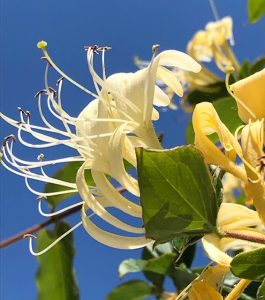
June 29
One recurring element of this month’s trip to London and Paris was flowers, a thematic initiated by an unplanned trip to the RHS Chelsea Flower Show. The fountain-filled show gardens and the vast pavilion of exhibits were admittedly memorable, even for amateur gardeners such as us. We were completely, and delightedly, out of our league. Florals followed us to France, where our Saint-Germain neighborhood was the locus of a walking tour of shops and art galleries, an “ephemeral vernissage” presented under the rubric “la fleur d’art.” In the studio garden of the district’s Musée Delacroix we encountered the hybrid rose “Othoniel,” only to find a marvelous installation of the artist Jean-Michel Othoniel’s rose-inspired works in the Louvre’s Cour Puget. We have yet to visit his Les belles danses at Versailles, but were enchanted nevertheless by Othoniel’s enigmatic solo show, Oracles, at Gallerie Perrotin in the Marais. His indoor 2019 Blue River, in particular, evoked some of the light-reflecting revelations of a garden’s water elements.
June 22
Though for several decades now Félix Féneon has been among LNB’s artistic heroes, awareness his self-effacing presence in French cultural history has only become evident to the American literary community in recent years. (We point out Mary Maxwell’s poem about the mysterious gentleman, “The Reading,” which first appeared in Agni Review in 1996.) Féneon is beginning to get even more of his due in France, where the exposition Félix Féneon: Les arts lointains has opened at Paris’s Musée du Quai Branly. Like the similarly mutifarious Lincoln Kirstein, Féneon is hard to place or explain. (It is therefore appropriate, we’d note, that a second part of the show will be mounted at MOMA in 2020.) There are Féneon’s writings: art reviews and and prose (his Nouvelles en trois lignes being century-old predecessors to current flash- and micro- fiction); there’s his editing of La Revue Blanche; there are his friends and colleagues (Modigliani, Rimbaud, Laforgue and Van Gogh …) whose work he promoted and sometimes underwrote. And then there are his collections of “primitive art,” some of which is on display at the Branly. Oh, yes, and then there’s the fact that he was an anarchist. Some elements of the show (20th-century “Negro Art”) intersect with another fantastic Paris exhibit, Black Models: From Géricault to Matisse at the Musée d’Orsay. One of the best-curated exhibits we’ve ever seen (kudos to the American Denise Murrel), the d’Orsay contains the same film clip of Josephine Baker as at the Branly, but presented with a different perspective. Beginning with 19th-century and colonial-era French painting, the show bumps up against the literary with a mixed-race Alexandre Dumas (for us adding considerable poignance to our childhood reading of The Count of Monte Cristo) and Baudelaire’s mistress, Jeanne Duval. All this moves towards 20th century Paris and Afro-American NYC, ending up with Matisse’s Jazz, the dancer Katherine Dunham and the sublime Romare Bearden.
June 15
Sometimes travel produces wonderful coincidences, related images and topoi that are too profound to be planned. At the Beauborg we came across Coffret Number 7, a one-room exhibit put together by Raphaël Denis about the heroic art dealer Paul Rosenberg. As he represented artists such as Ingres, Delacroix, Courbet, as well as Picasso, Braque and Matisse, by the 1920s Rosenberg was acknowledged to run the most important art gallery in the world. The somewhat conceptual exhibit preserves in size and number (“faux” pieces wrapped as though for shipping) the dealer’s art holdings and accompanying archives held in a Libourne bank vault circa 1941, when the Nazis confiscated the works and removed them to the Jeu de Paume; there they were identified as “ownerless cultural goods” and earmarked for Göring’s personal collection. Much of Rosenberg’s art had been to removed to London and America in the late 1930s, and Rosenberg and his family, despite extensive French collaboration, were able to escape to New York where he established a new gallery. And though the installation means to question the whole concept of an art “collection,” to us its more significant accomplishment is to record an amazing story of plunder and restoration; the recovery of the looted artworks remains ongoing. But we were moved to encounter a 1918 portrait of Rosenberg’s wife and daughter (renamed “Mother and Child” by Göring) at the nearby Musée Picasso, the painting donated by the gallerist’s family in 2007. Picasso’s emotionally warm (atypically so, we might add) representation of Rosenberg’s family makes evident the close relation between the painter and gallerist. As added resonance, the painting hangs in the same gallery as a perfect small Corot the painter purchased (or traded for his own work?) from Rosenberg early on in his career.
June 8
In Paris at the Musée Picasso we toured the richly endowed Calder-Picasso exhibit. Though the two artists met several times, and their works do occasionally overlap formally and chronologically, ultimately they are the products of distinct and oppositional sensibilities. Separate from the featured show, for example, on the museum’s top floor there was displayed a series of Picasso prints inspired by Maupassant’s Maison Teillier, these shown alongside a set of predecessors made by Degas and purchased by Picasso. Such brothel scenes tell a lot about their creators. For Degas, the women are working bodies, as professional as his danseuses. But Maupassant’s affectionate and moving portrait of working girls is reduced to brutal erotica by Picasso. It’s hard to imagine the playful Calder presenting sex as a thing to be paid for. Some might say he was too childish; we’d describe him as never having lost his innocent and practical genius. And so we have to admit that the thing we perhaps enjoyed best in the Calder-Picasso show was Calder’s journal reminiscence of the fourth encounter between the two artists in 1953. Picasso showed the American an embarrassingly commercial ceramic platter he’d recently made, with a bull-fight in the center and a raised ridge around the edge. Said Calder in somewhat faulty French, “That’s so the meat doesn’t slide.” According to an onlooker, Picasso’s face became bright red; the two never met again.

June 1
In the basement of the London Review Bookshop we were surprised by how many “door-stop” Carcanet Collecteds we came across whose authors we’d never heard of — names such as Iain Crichton Smith, Elizabeth Jennings, and Lorna Goodson. We like to think we keep up with current poetry, but the experience was humbling. We’re not talking about slim volumes of the long-dead but massive tomes of the near-contemporary. The 2013 book we ended up purchasing was not one these newish monsters, but we recommend it highly: Towards Re-Enchantment: Place and Its Meanings. Among its contributors are Kathleen Jamie, Robin Robertson, Lavinia Greenlaw and (the recently elected Oxford Professor of Poetry) Alice Oswald. Within its pages our attention was brought to another volume we’d not known about: Home Ground: Language for an American Landscape. It may sound oversimplified, but the matter of remembering what things in nature are called and how they got their names is a fundamental task of the poet. Such a glossary is slipping away yet, as Robert Macfarlane writes, “Certain kinds of language can restore a measure of wonder to our relations with nature.” Such recollecting “does not so much define as evoke, or it defines through evocation.” We are much looking forward to Macfarlane’s newest (and much-reviewed) volume, Underland.
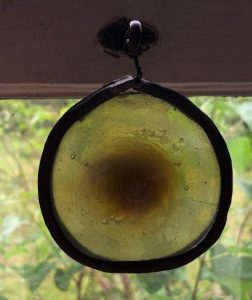
May 25
In London recently we were made particularly aware of the current campaign for Oxford Professor of Poetry. It has always seemed to us an odd tradition to choose a poetic representative by actual ballot, but perhaps we’ve been hopelessly naive. Slowly we’ve come to realize that the publishing industry, and now social networks, have transformed contemporary poets into perpetual candidates. We’ve begun to notice (in fact, can’t avoid observing) what are clearly group efforts to promote a person or book through what passes on electronic venues as popular acclaim. Whether actual publicists have been hired, or whether various promotional tactics have been acquired through online publishing advisors (itself a burgeoning career offsprung from the writing programs), patterns of self-branding and hash-tagging provide search-engine-accessible evidence for colleague-puffing efforts. It doesn’t make the work good, of course, but it does indeed create a shifty illusion of readableness through sheer buzz. Oxford’s occasionally rough-and-tumble election system, by contrast, seems quaintly and transparently brutal.
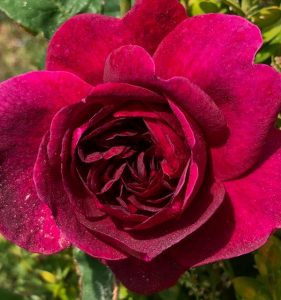
May 18
Just so our readers don’t think we’re incapable of enjoying middle-brow pleasures, in honor of her recent passing we found ourselves watching a three-DVD set of Doris Day’s “Romance Collection,” a trio of Universal Studio’s collaborations with longtime co-star Rock Hudson. We began with Pillow Talk (1959), then moved on to Lover Come Back (1961) and closed our three-night wallow with Send Me No Flowers (1964). There were a number of elements that never gave us pre-teen pause but which we are now unable to ignore. First: When we were young it seemed perfectly reasonable that a female interior decorator or advertising exec would have a full wardrobe of diamond jewelry (as well as rubies, emeralds and sapphires) that she could wear to professional functions. Second: We’re amazed that we never found the shapes of hats worn by Doris genuinely bizarre. We detect some subtext about independent women’s shopping habits but we can’t quite put our finger on the joke. But third: It’s jaw-dropping to realize that it was once perfectly okay to make jokes about “Mama’s boys” (even by Hudson himself!). Anxiety about the leading man’s orientation is everywhere: In the effeminate male characters surrounding the hetero pair (played by poor Marcel Dalio, Paul Lynde or the ever-present Tony Randall); in Hudson’s gelded sweetness; and in Day’s hysterical screech and sputter when faced with sexually aggressive men. And yet, the movies are really funny and and perversely current. Really.

May 11
Though it’s not common knowledge, Malden W.V’s most famous resident is Booker T. Washington. His step-father Washington Ferguson worked in the salt mines as a leased slave and arranged for Booker to move from eastern Virginia at the age of nine; Booker walked the 225 miles from Roanoke in 1865. He was baptized in Malden’s African Zion Baptist Church by the legendary Reverend Lewis Rice, who also provided the boy’s early education. The owner of the church’s land was Lewis Ruffner, advocate of emancipation and delegate to the convention that led to WV becoming a separate state from slaveholding Virginia. As a boy Booker worked in the Ruffner household where he had access to the family library. After graduation from Hampton Institute (where he worked as a janitor to pay his fees), he lived and taught in Malden until his departure for Tuskegee in 1881.
May 4
When we were first told about the 400 million-year-old Iapetus Ocean deep below the mountains surrounding Charleston, W.V., we were dubious. We suspected this was merely a sales pitch for the J.Q. Dickinson Salt Works in Malden, as part of an argument for the uniquely pristine quality of their excellent products. But it turns out that not only was the area America’s “salt-making capital” in the early nineteenth century, the fascinating tale of the ancient Appalachian sea is also true. That body of water extended all the way to the present western coast of Scotland, from whence, in some odd twist of historical fate, many of Appalachia’s first white settlers also came.
April 27
As we had such high hopes for “Lincoln Kirstein’s Modern” at MOMA, we were primed for a let-down. Despite some of the wonderful particulars displayed, our museum-going experience felt pretty colorless. Certainly it would be hard to argue that the arrangements do justice to Kirstein’s lauded “eye.” Even the hanging films of dances were hard to get a real grip on, as they seemed to float float, literally and figuratively, contextless. In writing up these notes, we thought perhaps we were just tired and peckish that afternoon. But the installation images on the website are nearly as dull as our fatigued recollection of the originals. Of course, Kirstein is more than somewhat mysterious as a person, and damn difficult to categorize. The term “impresario,” which pops up a lot, suggests he herded artists rather than being one himself. The show presents numerous portraits, strong jaw jutted to the viewer, eyes looking downward or off into the distance, pondering and planning. Jed Perl, who does an effective job in his review in The New York Review of Books, goes easy on the show’s shortcomings. But even he softly proposes that Kirstein’s vision and that of the new MOMA may be at considerable odds. We ourselves could imagine Lincoln shaking his impressive head about quite a few curatorial missteps. But perhaps the greatest omission was any real indication of just how good a poet Kirstein was. There’s an article by Elizabeth Welch at the MOMA website on Kirstein as editor and writer, with a link to Poetry magazine. But so far the poetry community continues to overlook Kirstein’s important wartime poems, as well as his interactions with the likes of Crane and O’Hara. MOMA could have made a real contribution to the Kirstein legacy if only they’d arranged a reading from The Poems of Lincoln Kirstein.

April 20
The David Zwirner Gallery has created a terrific webpage “viewing room” for the complete Paris Review Prints (iconic images include works of Frankenthaler, Katz, Rivers, et al.). Coming across this perfect collaboration felt to us very much like that happy moment when you introduce two friends, only to find out they’ve known each other for decades. We also much appreciated the Zwirner website’s acknowledgement of editor Maxine Groffsky’s eye for the look of the Review’s iconic 1960s covers.
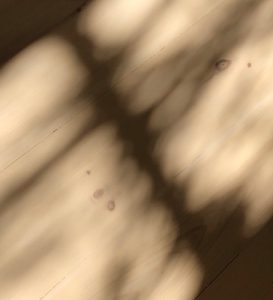
April 13
Those familiar with our Longnook Overlook know of our enthusiasm for Alberto Calvacanti. (A nearly comprehensive 28-page catalogue raisonné of the film director may found within its pages.) At long last we have been able to view his 1959 Les noces vénitiennes (Venetian Honeymoon), newly available on Gaumont DVD. A farce full of madcap crooks and identity confusions, it stars Martine Carol and Vittorio de Sica (playing the barman at the so-called “Harold’s Bar.”) The cast also includes a very young Claudia Cardinale. We have a slight suspicion that the project was originally meant for Max Ophuls (with the handsome French forger to be played by Gerard Phillipe?) It’s not a great movie, and much of its interest comes from colorful visuals, that is, time-traveling interior and exterior views of Venice. Besides the Ophuls suspicion, our other intuitive takeaway is that this production (which must have been a crazy shoot) may have formed a personal reference for de Sica’s 1966 After the Fox. Might we also propose the film as a precursor to a decade of British-inspired silliness such as Casino Royale, The Party and What’s New Pussycat?
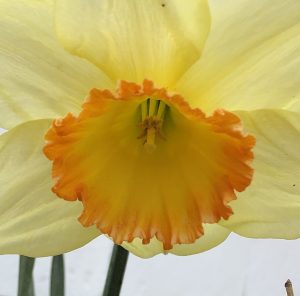
April 6
Given that her book’s subject overlaps with those of some of our own titles, it’s not surprising that we were drawn to Akiko Busch’s Notes on Invisibility in a Time of Transparency: “It is time to reevaluate the merits of the inconspicuous life … and to reconsider the value of going unseen undetected, or overlooked in this new world.” (Though nothing is more labored than an explained joke, we’d nevertheless observe here that not everyone caught the serious pun embedded in The Longnook Overlook’s title.) As with Busch’s prose meditations, Mary Maxwell’s concerns in Nine Over Sixes, such as “contemporary issues of near-universal surveillance,” find agreement with Busch; “True solitude, in all its painful yet pungent delicacy, is in terrible peril.”

March 30
One of the volumes we brought home from Scotland this past fall is the enchanting A Scots Dictionary of Nature, compiled by Amanda Thomson. The book is divided into six categories: Land, Wood, Weather, Birds, Water, and Walking. Among our discoveries are splorroch, the Scots word for the sound made by walking in wet mud; huam, the moan of an owl in the warm days of summer; linky, the adjective for flat and grassy; skelp, to move quickly on foot; and blibbans, strips of soft, slimy matter such as seaweed or cooked cabbage. LongNookBooks will be attending the Edinburgh Book Festival this August.

March 23
What a pleasure it is to find a favorite book back in print! Salka Viertel’s The Kindness of Strangers, with introduction by Lawrence Wechsler, has been brought out by NYRB books. A postscript by Donna Rifkind promises her to be the subject of a forthcoming biography. Salka’s Santa Monica salon is of special interest to us; we know there’s more to the story than Salka has told (she’s especially discreet about her affairs with Greta Garbo and Gottfried Reinhardt, as two examples), but what’s here is nevertheless quite wonderful. Though she’s been referred to (somewhat dismissively) as (merely) a “salonnière,” as with so many women writers, she was, in fact, the crucial cultural lynchpin for a time and place that forms an essential reference for much of American contemporary cultural life — and we’re not just talking about the movies.

March 16
“The Bauhaus and Harvard,” at the Harvard Art Museums celebrates the centenary of the Bauhaus’s founding in Weimar Germany. The Outer Cape (often via Harvard, not coincidentally) has its own Bauhaus connections; Gropius, obviously, had his presence here, but also the weavings of Anni Albers reminded us of various Wellfleet connections. In short, we felt perfectly “at home” viewing some of the remarkable holdings of the former Busch-Reisinger. One installation in particular made an impression that has remained: We were immediately taken by the Hans Arp “mural” created for one of Harvard’s Graduate School dining halls. Canopies of thought bubbles derived from trees, a series of wooden shapes floated along the gallery wall like clouds of intentionality, as though cognitions or feelings had been given intuitively biomorphic shape.
March 9
The first titles we purchased from David Zwirner Books’ ekphrasis series were already known to us (Ruskin’s Giotto and His Works in Padua; Rilke’s Letters to a Young Painter and Proust’s Chardin and Rembrandt). Not only were we grateful for these “overlooked” books’ new availability and translation, we immediately loved their size and simplicity of design. We are equally enthusiastic about our more recent purchases: Vernon Lee’s The Psychology of an Art Writer; César Aira’s On Contemporary Art; Gauguin’s Ramblings of a Wannabe Painter; Alice Michel’s Degas and His Model; Alexander Nemerov’s Summoning Pearl Harbor; and Jean-Claude Lebensztejn’s Pissing Figures: 1280-2014. Most of these works, of course, we only knew by reputation, but what a pleasure to have them in our hands. And we particularly admire the choice of quotes (not blurbs!) on the series’ back covers. Here’s Paul Gauguin: “People tell me I’m not Rembrandt, Michelangelo, Puvis de Chavannes — but I already know that! Why tell me?” Or César Aira: “The painted picture at the end is merely the visible testament to the mad solitary machine that moves around inside artistic activity.”
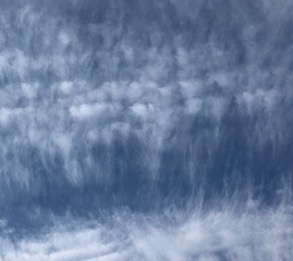
March 2
We recently happened to find ourselves in Providence one Thursday, staying overnight at the gracious Hope Club. The date was one whose cultural benefits we hadn’t taken into account, as we discovered only after wandering down the hill to late-opening galleries at RISD. There, the museum’s THIRDTHURSDAYS was a delightful surprise, with special interactive installations, musical offerings, artist talks, workshops and various other modes of performance staged and staggered throughout the evening. (There was even a cash bar and DJ set at the Café Pearl.) The event was worth planning to attend, but for us there was added a special delight of serendipitous encounter; it made that particular (otherwise rather dreary) winter evening warmly memorable.
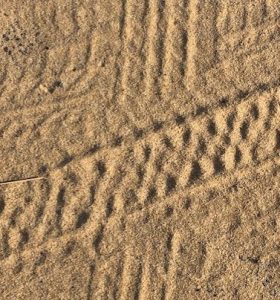
February 23
Sometimes wonderful writing appears where it’s least expected. For example, the “Purveyors” guide provided to diners at Thomas Keller’s Per Se restaurant is full of excellent sentences. No author is given, though the entire booklet’s style is consistent with the introduction penned by Chef Keller, who describes the offering as a series of “stories.” Each entry describes the individuals who provide the restauranteur with his ingredients, the various “fishermen, farmers, gardeners and foragers”, as well as certain individual animals, who supply the raw materials for Keller and his staff’s culinary creations. The narrative matter is good to begin with (these are not merely producers but evangelists for their offerings), but the way the individual narratives are presented is equally compelling. The poetry comes forth naturally through both description and honest syntax: “To farm, live and work in accordance with nature is to open oneself to a multitude of challenges and setbacks.” We are reminded of the prose of E.B. White: “The truffle makes its magical appearance in the ground, and after discovery passes into the care of many hands as it travels halfway around the world to grace American tables. The product is fresh, the sums exchanged for it are vast, and the opportunities for the less knowledgeable to be deceived are great.”
February 16
Last week we attended Robert Wilson’s performance “Forward Moving Memory,” at the Isabella Stewart Gardener Museum’s Calderwood Hall. We didn’t really know what we were getting into, but it turned out to be a white-faced solo performance of John Cage’s 1950 “Lecture on Nothing.” The experience was alternately tedious and revelatory. The hour or so in our seats was quite a bit like meditation, headache-inducing patience leading to a reward of earned insights. It was also often quite funny. The comedy derived from Cage’s exposition of the paradox of structure and the ludicrousness of any attempt to organize nothingness (as, for example, in a timed piece of silence). The conceptual “jokes” were both thought-provoking and meaningless, profundity and nonsense superimposed.
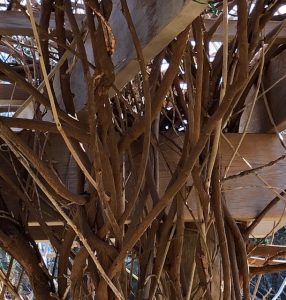
February 9
Do songs and poems function in the same way? Are they equivalent art forms? This is a question on which the American literary critical community is divided, though popular opinion certainly leans toward the affirmative. Our own feeling is that the two are artistic cousins of commensurate value. Yet how songs achieve their effects is distinct from published poems, as seems to us self-evident. The musical interlude that opens and closes the Danish television series The Bridge provides an excellent example of song’s immediate power. The emotional effectiveness of the haunting “Hollow Talk,” performed by the band The Choir of Unbelievers, bears little relation to its illogical lyrics. In fact, as many enthusiastic viewers have noted, even though the words are English (“echoes start as a cross in you”), sung as they are with a strong Scandinavian accent (“spatial movements are butterflies”), they’re virtually unintelligible to either American or northern European listeners. (For the first two seasons, we really believed the lyrics were in Danish! ) Frankly, the titled introduction and closing does work best when only a few words can be made out; their apparent “meaninglessness” beautifully suggests the oddly displaced intelligence of the autistic lead character. Not the verbal lines, but how they’re sung to the composed music, is what expresses the drama’s psychic context. We’ve been reading several recent volumes of great song lyrics, and as much as we admire them, as with “Hollow Talk,” even though we know by heart the tunes to which they belonged, on the page most of them now strike us as, well, a bit stupid. In fact, it’s somewhat embarassing how profound so many of these songs seemed when we worshipfully listened to them (Neil Young, we’re talking about you) over and over again on LP forty or more years ago.

February 2
Since we’ve been unable to keep up with the more recent translations of Cees Nooteboom’s books, let alone write about them with the analysis and praise they deserve, we are simply going to list here the impressive stack set upon our bookshelf — some read, some still unread — in no particular order: The Knight Has Died; Rituals; A Song of Truth and Semblance; In the Dutch Mountains; The Following Story; Philip and the Others; All Souls Day; Unbuilt Netherland; Nomad’s Hotel; Lost Paradise; Roads to Berlin; The Foxes Come at Night; 25 Buildings You Should Have Seen (Amsterdam); Monk’s Eye; Mokusei!; Letters to Poseidon; A Dark Premonition: Journeys to Hieronymus Bosch; Zurbarán; Light Everywhere; Self-Portrait of an Other. How could such an oeuvre continue to go virtually unnoticed here in America? No longer might it be argued that his extraordinary range (travel, art, fiction, poetry) remains to be brought over into English; now the challenge is simply to catch up with the great Dutch writer. Shame, shame, shame on us.
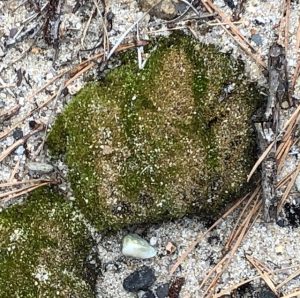
January 26
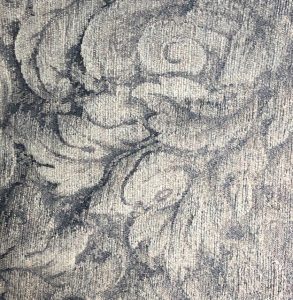
January 19
Harry Mathews’s The Solitary Twin was published posthumously by New Directions at the end of last year. In some sense, the book is an energetic nod to traditional storytelling, with a series of stories told Canterbury Tales-like by characters within the novel’s narrative. But is it possible for a work to be so conventional as to come full circle and become experimental? Mathews’s Twin makes such a case. The line between true tale and a conceived fiction (nearly as razor-thinly drawn as in his My Life in CIA) becomes at times hilariously undetectable (“real-life” appearances are made by the likes of Bloomberg and Malraux) with the result that that created characters are so convincingly described as to demand a Googling. Was there ever a Utopian-Capitalist community begun in New England by Samuel Butler? Did Raymond Norwood Bell of North Carolina shoot and kill Anton Webern? Did there ever exist a Lehman Brothers philanthropist-gambler named Alistair Ross? Like the imaginary books the Twin’s publisher-character has seen into print, factuality seems irrelevant in the face of delightful possibility. Or put another way, as the author himself makes note: “Nothing can approximate the truly colossal stink that expert writing is capable of.”
January 12
The Bechtler Museum of Modern Art in Charlotte, NC, came as a happy surprise. We were literally hailed to the collection (like a taxi) by a sparkling Niki de Saint Phalle just outside the main entrance. The core of the collection is formed by works acquired by a family from Zurich and so, by no surprise, postwar Swiss artists figure largely in what is displayed in the splendid building designed by Mario Botta. The series of stacked rooms contain some wonderful Giacomettis, Arps and Miros, but we found ourselves particularly smitten by a scale model of Jean Tinguely’s idiosyncratic Cascade in the windowed lobby. A few days later, we made our way to the 40-foot original in the Carillon office tower, just four blocks north of the museum. Entranced by the whirring mobile floating above a reflecting fountain, we became two small children in the presence of a kindly robotic giant.
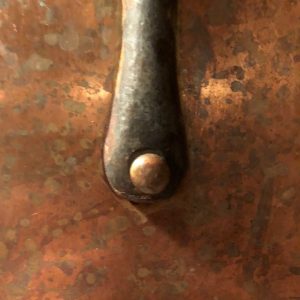
January 5
Specific reasons for the impossibility of literary translation are outlined so regularly in critical discourse (issues of shape on the page, rhythmic idiosyncrasies, specialized dictions, etc., etc.) the lost list of excuses for noble failures hardly needs restating here But for us more fundamental to any translation’s success is something we can only lamely identify as “personality,” something falling within received categories of temperament but much more unique and specific. Take the translation challenge accepted by Richard Siebuth in A Certain Plume, his superb American take on the marvelous Henri Michaux, polymath and proto-Beat “character,” who refused to be shown in photographic portrait. Michaux’s lyric persona, a sort of alter-ego figure named “Pen” (or, alternately, “Feather” or “Quill”), could only be pinned down in paint (like an errant demon) by Jean Dubuffet. The Belgian ventriloquist has also found himself inadequately, albeit evocatively, described by the words of Lawrence Durrell: His is “a stone-age voice full of veridic information about the state of mind in which poetry declares itself as an absolute value.” Add to this a complex and self-contradictory sensibility, a Surrealist Chaplin playing/being the DadaTramp, and the reader begins to approach some idea of the shape-shifting “Plume.” And yet Sieburth nails this character’s pratfalls; the facing-page original French texts only confirm his hilariously daemonic capture of the ultimate submissive with whom, we suspect, all honest souls would confess to identify. For ourselves, we’d never have believed that the distinctive superciliousness of French authority, before whom the bruised self collapses, could make its way so unforgettably into a dreamworld-asylum English — a language through which, it turns out, the humiliated also walk on ceilings.

2018
December 29
Looking ahead to the New Year, the editors at LNB have a couple of exciting projects in the works. Perhaps most ambitious is a second volume of The Longnook Overlook which, at least for working purposes, we are referring to as Overlook 2. While the content will be compiled over the course of 2019, the actual publication date is likely to be early 2020. Like the first Overlook, our latest “review of the arts” will not be for retail sale but will be available (upon request) with the purchase of any other LNB volume. For curious readers who aren’t poetry enthusiasts, may we suggest our art monograph on Serena Rothstein, Discourse in Paint, whose splendid four-color “Personages” also grace Overlook 1’s elegantly elongated centerfold?
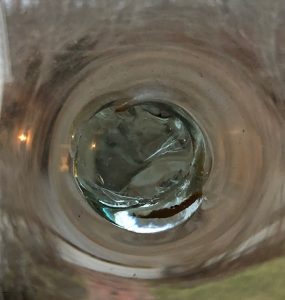
December 22
We admit we haven’t really followed the plot lines of the last season of Westworld. To our thickish non-millennial minds the flashbacks and flash-forwards won’t add up to anything like a chronological narrative, but we don’t really mind. From our binged confusion we’ve taken something away more interesting than a reasonable story. Instead we are deeply disturbed to recognize the imaginary reflection of our selves — whether as gunslingers, saloon madams, or the farmer’s daughter turned avenger — as largely the product of someone else’s marketing concept. It’s just an entertainment, right? What is real is what cannot be replaced. For as the end-date of actual human death is pushed further and further away through various technologies, mortality itself does become increasingly conceptual. Yet we will always find ourselves limited by what we know, parameters we must question and against which we must battle, forging, episode by episode, the terms of our individual liberations. How do you want to die? You only live as long as the last person who remembers you.
December 15
Several non-academic books this year have treated the matter of women in Homer. First came Emily Wilson’s poetry-free translation of the Odyssey; then Madeline Miller’s witch-friendly Circe; now with Pat Barker’s The Silence of the Girls we have The Iliad from the point of view of the enslaved Briseis. All three books have been so heavily marketed and commented upon, it is as though a whole new genre of contemporary fiction has come into being: Chick-lit Achaea. We know we should be supportive of this, but to be frank, it all seems to us a bit silly, treating Homer as though his narrative were not an act of the imagination but a work of cultural history. It’s true that feminist academics have had to turn to literary texts in response to the rarity of actual women’s voices in the classical world. But for us, as we read these leaden productions, instead of hearing something refreshingly resonant and newly meaningful, we are made even more aware of an echoing absence.
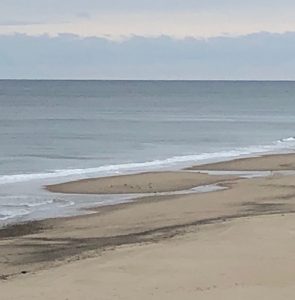
December 8
Hope Never Dies by Andrew Shaffer (“An Obama-Biden Mystery”) may provide the best airport reading ever. It’s an almost completely mindless book, yet we found it thoroughly entertaining. It’s a Hardy Boys for Democrats, whose pair of post-middle-aged heroes are credibly determined, brave, and true. The author’s perfectly tuned and impeccably timed delivery nicely alternates with mild mockery and genuine action-hero admiration. As with the aw-shucks sensibility of Biden, everything in the book is G-rated — G also standing for the ex-vice-President’s fundamental Goodness, despite his nagging envy of his cigarette-smoking, ex-President hipster pal. The more glamorous half-Black Obama makes appearances as needed with his own surprising moves, yet it’s black-Irish Biden who provides the narrative ballast of this amusingly imaginary investigative team. If there were a follow-up volume — or maybe even a series — available in paperback, we’d surely keep a look-out at the newspaper kiosk.
December 1
We found the last seasons of Downton Abbey pretty tedious, but they were nothing compared to the second season of The Crown. As with Downton, the show’s production values are great — British bachelor pads and palaces, location shots, period costumes and makeup. We especially enjoyed the African sequences and the ocean scenes of Philip’s cruise “down under” (all the while hypnotized by the uniformed Phillip’s white knee-highs). And even though the revelation that the Duke of Edinburgh was quite a bounder came to us as a surprise, the dramatic truth is that the royal narrative is inarguably dull beyond description. And yet we watched, obsessively, like someone under the influence of a narcotic that renders the couch-bound patient unable to move yet still be aware of every little thing (the hair-sprayed shape of Queen Anne’s head, a reception hall’s fringed window treatment, the width of a label) appearing upon the tastefully framed screen.

November 24
In Nashville we became newly enamored of the late, great Johnny Cash. We highly recommend his posthumous collection of poems, Forever Words, published in 2016. We’ve opined before about our objections to the awarding of the Nobel for Literature to Bob Dylan (in sum: he didn’t need either the attention or the money), but we’d never argue against Dylan’s stature as a musical and verbal artist. And though, as Paul Muldoon points out in the collection’s introduction, both Dylan and Cash are folk descendants of a Scotch-Irish ballad tradition, we prefer (will all due respect to Christopher Ricks) Johnny Cash’s words as they land on the page. His “California Poem” strikes us as nearly Brechtian in its terse beauty: “The lights are on past midnite / The curtains closed all day.” The human soul summarized in a couplet — that’s pure Cash. Maybe our enthusiasm is a matter of timing, as certain of the poem’s other lines feel especially resonant in the wake of recent fires: “There’s trouble on the mountain / And the valley’s full of smoke / There’s crying on the mountain /And again the same heart broke.” In any case, we know all too well that his kind of spare lyric only looks easy to write.
November 17
Certain Facebook groups we belong to have been not only extremely useful; they continue to be much appreciated as a resource for shared enthusiasms. But we note a tendency of such groups to descend into passive bullying. We have one particular closed poetry group in mind. Though it purports to be a venue for the open expression of its varied members, its posted content is tightly controlled by the administrator’s aesthetic preferences, particularly his own definition of what defines a good poem or successful poetic performance. He is especially self-righteous in his ideas as to what constitutes right behavior in the “poetic community.” On occasion he has even bragged about his removal or refusal of dissenting voices, acts which are inevitably supported by a claque of posted thumbs-ups and smiley faces. But for us most problematic is this administrator’s tendency to delete the expression of political opinions that differ from his own. In the matter of politics, we wish to remind him, lots of “well-meaning” poets have found themselves on the wrong side of history. That our politics and his basically overlap is besides the point. A despot is a despot, enlightened or not. And while it’s quite true that, shifting to matters of aesthetics, we loathe many of the mediocre poems and events he posts — well, to each his taste. For if it were truly a matter of “each,” that is, if the postings were those on his own personal page, we’d not have a problem with it. Individual hosts have every right to serve whatever they like to their friends— and even to throw a troublesome guest out of the house. But the group purports to be a public space and to provide a public service; the administrator’s job is to moderate not to log roll. Instead, as with so many bureaucratic positions, control of page content has evidently become for him a source of professional power. And so we post these observations as a general caution, noting one specific example of an increasingly widespread form of autocracy found among social networks.
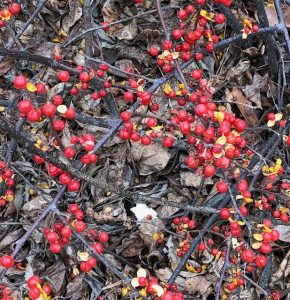
November 10
We attended the late-night Saturday show at Nashville’s Grand Ole Opry at the Ryman the weekend just before Tuesday’s blue-wave election. We’d not realized that this would be broadcast live on the radio, and so were much bemused by the live commercials announced by the evening’s bass-voiced emcee. It was a fascinatingly retro experience, with a wide range of entertainers of various styles and generations. But most striking to us was the evident disconnect between “country” audience and artists; by some of their patter, the performers were making a discreet pitch for a more inclusive politics than it appeared the ticket-buying public might be leaning towards. This slight lean left (an observation of the international makeup of several of the sidemen; the self-parodic nature of a Native American’s politically incorrect comedy routine; unapologetic jokes about taking advantage of marijuana legalization) all felt vaguely hopeful and possibly prophetic. Even the Hee-Haw gang is getting worn out by our president and his relentless viciousness.
November 3
Unexpected treasure is one of travel’s greatest pleasure, and we came across a giant jewel box of one this past week in Nashville, Tennessee. The building of The Frist Center for the Visual Arts is a “repurposed” art deco post office dating from the Hoover Administration. An architectural gem in and of itself, its gorgeous main hallway glistens with black, silver and gold grillwork, light fixtures and marble floors. The main foyer, lit by original skylight, and flanked on either side by a pair of grand staircases, is literally breathtaking. The high-ceilinged sorting rooms have now become exhibition spaces, perfectly suited for the spectacular, Paris 1900: City of Entertainment, now “on tour” from its original 2014 venue at Paris’s Petit Palais. It’s astonishing that we came across this show quite by chance. There’s some wonderful “high” art in the show (Rodin, Monet, Toulouse-Lautrec, et al.), but it’s what falls in the category of artifact that makes the time spent in the Ingram Gallery as fun as a carnival ride.There’s the Paris of the International Exposition (caught by the brothers Lumière on early film); there’s the city’s late-night cabaret scene with “bohemian aristocrats in search of forbidden pleasures”; there’s the proto-feminist theater of Sarah Bernhardt; there’s art nouveau design and couture of Paquin. The exhibit is truly an “immersive” experience, offering to imaginative visitors a form of time travel back to the City of Light at the delightful height of its Belle Époque.
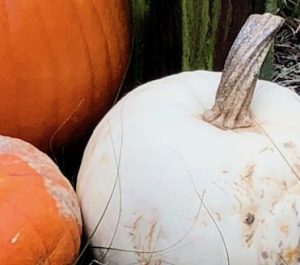
October 27
We have a tendency to dismiss postcard-ready painting that’s too “perfect” to be real. But we had to admit that the hills surrounding Edinburgh really do look like the framed versions hung in the Scottish National Gallery. So, too, even the imagined capriccios in “Canaletto and the Art of Venice” in the Queen’s Gallery at Holyroodhouse have an intensity truly matched by the actual intensity of light-reflecting waters along the Grand Canal. Leaving the exhibit to tour the palace itself, after paying a visit to the various Royal chambers we wandered among sunlit gardens arrived at through the abandoned abbey. Looking up to Arthur’s Seat from a bench we’re sure Her Majesty herself must often enjoy, the landscape’s golds and greens defied recording by cellphone camera. We could hardly believe that we’d not found ourselves inside an artwork.
October 20
While we were in Edinburgh this past week, we were made aware that the Scottish poet Robin Robertson’s The Long Take had been shortlisted for the Man Booker Prize. Even though it didn’t win, the book’s achievement seemed to us a very big deal. That a long narrative poem had been determined strong enough to compete with prose novels is something worth talking about. Though his book won’t be available via a US publisher until well into November, it’s surprising Robertson hasn’t come up in stateside poetry-world discussions. especially as the story’s setting in a very noir, mid-century California is so redolent of native masters such as Chandler and Hammett. Our impression of Robertson’s achievement (confirmed by the prize nomination) is that it’s a volume aimed at those readers who don’t usually pick up a volume of poetry (i.e. straight men). To our ears and eyes, Robertson’s poem owes much to Christopher Logue’s War Music, both in its cinematic/typographic approaches and its impatient prosodies. But with a map of downtown LA and period photos, it also makes a meaningful visual nod to the un-categorizable Sebald. Robert Louis Stevenson was another Scot who spent time in California; some say if he’d lived another twenty years, he would have likely ended up in the burgeoning film industry. Instead, a hundred years later, we have Robertson’s distinctly unromantic view of Hollywood in its postwar noir heyday, the underside of McCarthy-era America seen from the perspective of a traumatized soldier.
October 13
So many of the rain-soaked vendors at the Boston Book Festival are underwritten by the city’s universities, either as an extension of academic publishing (Harvard University Press, MIT books, etc.) or of the various writing programs (almost all the literary journals have institutional associations). There are a few noteworthy exceptions, (Other Books and Wakefield Press, to name but two), somewhat eccentric enterprises run by strong-minded individuals. Similarly, one of our favorite places in town, the Isabella Stewart Gardner Museum, is an institution that doesn’t feel like an institution, largely as a result of its origins as the ambitious whim of a particularly determined personality. The current director appears to be cut of the same cloth. Among the adventurous offerings to be seen and heard in “Common Threads: Weaving Stories Across Time” was the compelling“in-ear opera,” True Pearl, created to accompany the Tapestry Room’s wall hangings (part of the Gardner’s permanent collection) depicting the narrative of Cyrus the Great. Here was an offer of free acoustiguide we were happy to accept, finding ourselves fascinated by David Lang and Sibyl Kempson’s groundbreaking translation of “textile art” into sound.
October 6
With our recent travels we’ve finally come to accept the “new normal” of contemporary life, those electronic mundanities attending us when we’re away from home. We pre-register online; when confused by signage, we google for explanation or directions; when we arrive, we empty our pockets in order to pass through metal detectors; and more often than not, we find ourselves proceeding on moving walkways or narrow passageways, scannable ticket in hand, as disembodied voices (and sometimes recorded images) are directed at us. We’re not just speaking of airports — essentially the same protocols now greet us at most music events and art museums. And, of course, almost all encounters present the option of preliminary mediation through smart phone app, so that in advance we receive buzzing invitations to pre-digested forms of whatever “experience” is to come. By the time we’ve arrived at the thing itself — the flight, the performance, the art exhibition — we’ve already experienced diminution of any “actuality” (save for, of course, the inevitable physical discomfort of waiting on line). We know about human “sound pollution,” which has made attending nature increasingly difficult. (Even within the National Seashore, the Dolby surround-sound of birds and wind remains only available deep in the quiet of the diminishing off-seasons.) But as we’ve wandered off-Cape in recent weeks, we find that even the human environment has grown increasingly polluted by the virtual.
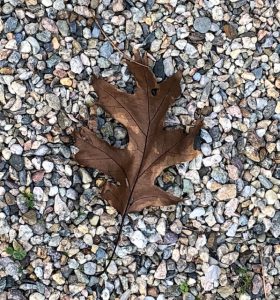
September 29
Trump’s tariffs on paper are both actual and symbolic, as the president’s most powerful enemies continue to rely upon the weaponry of newspapers and books. At LNB we have been longtime advocates of paper and ink; while our choice was initially aesthetic, we now view our use of the medium as form of resistance to digital tyrannies. Despite our LOOKOVER postings, we remain deeply suspicious of online expression and its quicksilver ability to be manipulated or appropriated. We agree to press our fingertips on the touch-screen as directed at US customs, but we know perfectly well how such efficient machines are the doorway to irreversible invasions of privacy. We are strong advocates of paper ballots. And we continue to believe that an individual’s deepest thoughts, what will remain ours alone, still finds its most exact expression in poetry encountered on the tree-derived page.
September 22
We’ve lately found ourselves traversing mid-Atlantic Trump country. And while it is painful to get outside the three-fold bubble of New England> Massachusetts> the Outer Cape, in principle a reality check is a good thing. We liked to think that first-hand observation and interaction might make the President’s supporters more understandable or even explicable. Trump is right to call them “good people,” but they’ve been snookered and made dangerous. Not to sound overly dramatic, but listening to the Kavanaugh hearings on the radio while driving through Pennsylvania and West Virginia produced certain physiological effects of an actual assault. On the drive back North for the dreadful upshot of a new Supreme Court Justice, a woman experienced real anxiety and traumatic symptoms when she found herself alone among a group of young white men whose worst instincts had recently been validated. We return to safety and security, but what lingers is the unshakable sense of what the political abstractions cannot express.

September 15
Indian summer this year brought some glorious days to the Cape. One recently saw the Provincetown Book Festival’s “Authors al Fresco” event set up on the lawn of the town’s wonderful library. LongNookBooks was delighted to participate, our table facing the historic building. Originally a Protestant church, for a time in the late fifties it housed the Chrysler Museum of Art. Until 2000, it served as Provincetown’s Heritage Museum; during that period a half-scale mode of the Rose Dorothea Schooner was recreated, with the result that entering the structure’s upstairs feels a bit like entering one of those “ship in a bottle” craft projects. In 2002 renovations began to convert the building into the present library. We remember vividly when the steeple was removed for restoration. It’s back now, along with custom-built bookcases that reuse mahogany armrests from the original church’s pews, a detail that evokes both sacred spaces and nautical impulses. This seems exactly right to us. Libraries are sanctuaries for quiet thought and interaction with writers’ words — sturdy vessels for intellectual and cultural adventure.

September 8
In our 6/12/17 posting (availabe for reading in the LNB Archives via the “Journal” dropdown above), we drew attention to Robert Mueller’s hiring of Michael Debreen. Now that the noose around a certain Tang-colored neck is tightening, the President, as well as the country, will become increasingly familiar with the brilliant Debreen. Having argued over 100 cases before the Supreme Court, not for nothing is he being seen by experts as Mueller’s “closer.” Even with all the evidence and cooperating witnesees, prosecution and/or impeachment of the high-criminal in the Oval Office could still slip away — that is, should certain tactical mistakes or legal errors be made by DOJ team. But with Debreen advising, that’s not going to happen: There’s no one on the planet with more knowledge about federal criminal law than Michael Debreen. In fact, it was Debreen who successfully argued in federal court back in April that Manafort’s criminal case shouldn’t be dismissed and that certain seized evidence should be made admissible in his trial. Especially on political matters, it’s awfully satisfying to be able to say, “We told you so.”

September 1
As Maurice Ravel’s Quartet in F Major is one of our absolute favorite pieces of music, we should have been unreservedly looking forward to hearing it performed in Wellfleet as part of the closing program of the Cape Cod Chamber Music Festival. But lately, whether live or on the radio, we hear too much of one kind of classical music. We’re tired of exact but heartless conservatory musicianship; ancient coughing audiences; tepidly accessible programming. After a couple of musical evenings this past winter, we found ourselves thinking, “Enough already! We’re too young to be made to feel so old!” But last night’s performance of the Ravel took us back to our first enthusiasms, back to when music could be as thrilling as a schuss down the side of the Matterhorn. Not just technical aptitude but real verve and emotional engagement, that’s what we’re still looking for — and it was just that kind of concert experience which the youthful Parker Quartet (Daniel Chong, Ken Hamao, Jessica Bodner and Kee-Hyun Kim) so sublimely delivered.
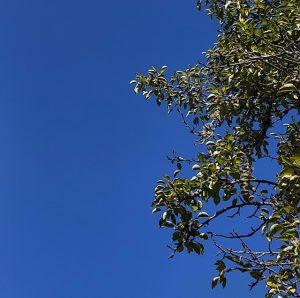
August 25
Our first “LongNookBooks Presents” program, the cellist Guy Fishman at the Truro Meeting House, was an enormous success last Sunday. The “house” was literally packed and Fishman rightly received a standing ovation for his impressive performance of the first three of Bach’s Suites for Unaccompanied Cello. Given the summer heat in the unairconditioned 1827 church, it was an act of physical endurance as well as one of technique and memory. At the recital’s interval, Fishman spoke of the work’s interesting history, a narrative of the solo music being overlooked for a century or more until “rediscovered” by Pablo Casals. But Fishman’s own cello “genealogy,” as was pointed out when he was introduced to the rapt audience, has its own relevance and significance; one of his teachers was the Guarneri Quartet’s David Soyer, who himself was a student of Casals. The admirable YoYo Ma recently released a third recording of his “take” on the Cello Suites, interpreting the music on a modern standard cello in what will undoubtedly be a worthy version of the familiar music. Yet we ourselves do feel hearing the Suites on Baroque cello, as Fishman played it, not only takes us closer to how the composer himself would have heard it, the distinctly animal-like qualities of gut strings better captures the profoundly human and vocal-chord-like quality of Bach’s singing, and thinking, to himself.
August 18
Long Nook became internationally famous this week. As emergency vehicles zipped down the road in quick succession, we knew something was up, and among the immediate possibilities was the inevitable encounter between man and ocean beast. Given the proliferation of seals at “our” beach, a shark attack was not a matter of if but of when. And so our sunny days were filled with the sound of low-flying helicopters and the appearance of satellite-topped vans. As anyone who’s found themselves in a similar position, it is both ludicrous and rather exciting to see one’s neighborhood as backdrop to the news. But now that the media has moved onto other topics, we observe that none of the coverage seems to have reduced the number of Long Nook’s beachgoers. On the contrary, we have the distinct impression that some visitors are actually hoping to be present for the next attack.
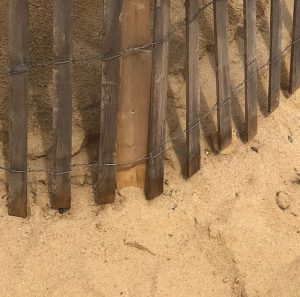
August 11
One of the best things we’ve read lately was David Thomson’s “On the Sofa,” in the August 2 London Review of Books. A “review” of sorts of the German series Babylon Berlin, we were both amused and troubled how Thomson and his wife’s binge viewing paralleled our own. (“Face it,” he writes, “marriage is a kind of binge.”) We’ve not yet gotten to Babylon Berlin, as these past weeks we’ve instead been going through both seasons of the Norwegian series, Occupied. But the nightly alternation between MSNBC and too-close-to-current-events fictional dramas rang exactly true to our own experience: “As [Rachel] Maddow preached an hour a night, brimming with verve and need, she slipped from glee to bravery and even to tears.” In the face of such oh-too-true tales, the feverish serial binge, especially the concomitant impossibility of following all narrative details and secondary characters, comes as a perversely welcome relief. Thomson nails the irony of the historical moment: “The nature of bingeing is to commit to the frenzy without any hope of rational control or order. That is why Donald Trump is the exact leader for our time: he is so blind to order and meaning because he is inextricably caught up in the binge of himself.”

August 4
We were a bit concerned that attending the Boston concert of David Byrne’s “American Utopia” tour was going to make us feel old. After all, our first Talking Heads concert dates back to the spring of Freshman year in college, with Byrne himself then a recent graduate of RISD. So here we all are, hovering on either side of sixty, still wondering “How did i get here?” It was a transcendent evening, some of the evening’s pleasure a kind of recalled nostalgia but another part coming very close to newly revealed truth. We’d not realized before how much we love the dance element of Byrne’s performances, his distinctive jerkiness now become mainstream. How we delighted in his Twyla-Tharpe-like body being blown across the stage in imagined winds of cultural fate, his mysteriously coded gestures suggesting something between an airport worker on the tarmac (waving an invisible plane to the gate) and a speaker of ASL. Of course, what was once “experimental” (the incorporation of “world music” into pop forms), approaches that have radically enriched our ways of listening, have now been thoroughly assimilated. Byrne’s distinctive sensibility has remained a sharp-eyed but affectionate take on things American, the easy sweetness of his bouncy dance rhythms made intellectually acerbic by dystopic lyrics. All in all, it was a great show, an impressively choreographed and designed “production” with an amazing cast of musicians and dancers. The artists’ call to movement was completely irresistible to the entire summer evening audience, with dance and song offering itself as a form of political resistance. After several encores, it became clear that although the tenor (current politics) may be terrible, the proposed vehicle is a powerful mode of activist hope.
July 28
Many of the Outer Cape’s cultural community turned out to honor artist and activist Ai Weiwei at this year’s Fine Arts Work Center Gala and to view the show “Rebar and Case” at FAWC’s Hudson Walker Gallery. The tension between the installation’s style and content created a real one-two punch of cognition and emotion. The shapes of twisted rebar (formally alluding both to a tragic building collapse in Sichuan as well to the disaster’s effects on the spines of its victims) were rendered in the museum-quality permanence of marble. So, too, his polished wood display cases evoked both high-end furniture and coffins. Here at LNB, we don’t take Ai’s physical presence for granted. For even as we speak our minds on digital media, we are highly conscious of the paradox of free expression and constant surveillance. And while contemporary life, not only for artists, has become a constant matter of negotiation between ideals and realities, the priority of any artist is as advocate for the imaginary. And yet, to focus on the actual, it was an amazing moment to shake Ai Weiwei’s hand and exchange sentences with him. The solidity of the physical person (a body that’s endured both prison and beatings) as residence for his still-resisting spirit was, to use an overused word, inspirational. Ai Weiwei remains determined to remain on his course of creative dissidence, a role, it seems to us, he was born to inhabit as the son of the poet Ai Qing. We strongly believe artistic awards should not be determined due to any artist’s well-meaning political or rhetorical activity, but in this case we urge the Swedish Academy to take into account the immediate effect of Ai Weiwei’s creative contributions. His films as well as his installations continue to influence real individuals’ freedom of expression, immigration situations or other forms of lack of due process, all international circumstances very much still calling for attention — and still pending resolution.
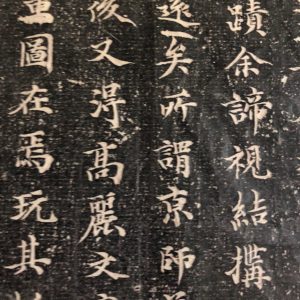
July 21
We were happy to see the republication of Muriel Rukeyser’s The Book of the Dead receiving notice on Ron Slate’s online magazine, “On the Seawall.” Slate points out that the poem not only predates The Maximus Poems and Paterson but also “anticipates techniques that are now familiar in politically charged poetry and cross-genre writing.” But neither Slate nor the book’s editor, Cathereine Venable Moore, notice that Rukeyser’s work strongly overlaps with that of James Agee in ways that couldn’t possibly be coincidental. Agee’s first book of poems won the Yale Younger Poets Prize and was published in 1934. Only two years later, Rukeyser’s Theory of Flight was selected. And it was in June 1936 that Agee, on assignment from Fortune, set off with photographer Walker Evans to compile the materials that would eventually become Let Us Now Praise Famous Men. That very spring Rukeyser and her photographer friend Nancy Naumberg drove down to Gauley Bridge, West Virginia to investigate the 1930 Hawk’s Nest Tunnel industrial disaster, a classic example of business malfeasance on the part of Union Carbide which resulted in death by silicosis of 764 (mostly African-American) workers. The text-image collaboration (as well as a proposed film) never came to be, but the poem remains as one of the most remarkable examples of poetic political witness. For us, the book as published by West Virginia University Press contains too much of the editor’s presence (her introduction forms half of the small volume), so that historical content far overshadows the poetry. For the true subject of the poem is not the information it presents, but as in Agee, an exploration of the moral obligations of a recording sensibility — in both cases, the privileged “outsider” poet who serves as stand-in for the reader. Once again, descriptions becomes judgment, a simple image expressing the hydroelectric power for which so many tragically died: The old plantation-house (burned to the mud) / is a hill-acre of ground. The Negro woman throws / gay arches of water out the front door. / It runs down, wild as grass, falls and flows.
July 14
We’ve now had two opportunities to see “Abstract Climates,” PAAM’s summer show of Helen Frankenthaler paintings. Our first look was at the exhibition’s opening; and then we viewed these astonishing canvases again among meandering crowds at this year’s Provincetown Arts launch party. The magazine’s issue contains a number of articles about Frankenthaler and her time in Provincetown, but the perspective we found ourselves acutely missing was that of longtime Provincetown Arts contributor Eleanor Munro. Munro’s piece on Frankenthaler (originally appearing in 1979, but reprised twenty years later in her revised Originals: American Women Artists),presents this astonishing (and relevant to the PAAM installation) quote about the size of such works: “You need that many feet of flat surface for the illusion, for the light.” Munro’s Frankenthaler profile is part of a section on American women artists who emerged from the world of 50’s Abstract Expressionism, many of them students of Hans Hofmann. Munro’s understanding of who such women were (Hartigan, Frelicher, Lansner, among others) places them in a specific cultural context, a generation largely “bred on the principles of the prewar progressive-education movement.” Viewers (and critics, too) project themselves onto what they see, of course; and we admit that in these enormous paintings, brought back “home” to the Machado-Silvetti spaces, we ourselves recognize a version of the small Provence-inspired watercolors and gouaches of Serena Rothstein, also a Hofmann student — both sets of work being the expression of a New Yorker’s sensibility when she finds herself near the sun-reflecting ocean. Unfortunately, nothing in the current discussion of Frankenthaler’s show approaches the sublime summary achieved by these forty-year-old clauses of Munro: The feeling-tone her paintings have projected has been the serene and beautiful, achieved by insightful control over the elements of form: floating areas of color; occasional fountains, spurts, jets of color thrown against bare canvas; hard-edge panels or curtains of bright flat non-naturalistic color; and … fields of warm earth color pulsating on a languid cycle like red stars or stains of strange phosphorescent hue hovering like mirages at the edge of a world.

July 7
We’ll try to rein in our rage and frustration at the lack of critical reception received by Carcanet’s 2017 collection of Yves Bonnefoy poems, trying instead for something of the late French poet’s equilibrium, “all softness and irony assembled.” But first, sardonic bitterness: When a proposed subject is the work of the recent dead, a book review offers few opportunities for earthly logrolling. And yet the simply titled I: Poems is an important book, gesturing as it does toward the forthcoming II: Prose (both in anticipation of a complete Pleiade edition). It’s as though a granite mountain were so prominent, its actual presence remains ignored by valley inhabitants, “mysterious meaning in what is merely simple” all but ignored. Of course, given that recent online discussions tend toward a growing consensus that in this day and age there can be no more “major” poets, it’s not surprising that the French poet — who soundly contradicts such a thesis — might, for the sake of convenience, be set aside. Perhaps the second (prose) shoe has to fall. For as Anthony Rudolf observes in his preface to Bonnefoy’s verse, few poets (at least not since Baudelaire and Leopardi) “have had a ‘second’ oeuvre in prose so intertwined with their poetry, so rich in signs and wonders, so complex and yet so trustful of readers.” Despite the presence of the French, here at LNB we still have difficulty thinking of the great Bonnefoy as a “foreign” writer. Whether this is a result of the decades he spent here living and teaching, particularly in New England, or it’s because of his extraordinarily living translations of Shakespeare, we ourselves sometimes think of him as one of the most remarkable Anglo poets writing in French. Though we would hardly argue that nothing is lost in the transition, it seems to us — especially in his later lyrics — that his work slides easily into a contemporary yet somehow timeless English. Even though the excellent facing-page translations have been made by multiple, mostly British, hands (Rudolf, John Naughton, Stephen Romer, among others), the lines remain eternally Bonnefoy.
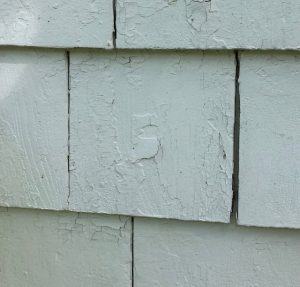
June 30
We were honored to be present a few weeks ago at the awarding of the Radcliffe Medal to Hillary Rodham Clinton. The handing-over of the medal was preceded by a panel on America’s current position in international affairs, and discussions of the Obama-Clinton era felt like the semi-mythical recollections of an age of Bronze. In truth, the world back then was anything but Golden, yet only five years ago there was, as testified by the distinguished academics, journalists and diplomats engaged in the discussion, still a belief in the effects of intelligent and humane public policy. As Madeleine Albright delivered her personal testimonial for her friend and colleague at the State Department, we were all taken back to a time of possibilities. The afternoon was not merely poignant; it was heartbreaking. In her interview with Maura Healey, Secretary Clinton showed once again personal and political qualities of persistence and perseverance. We ourselves felt momentarily released from despair. Like bearberry or the summer’s beach roses after a brutal winter, certain low-growing, thorny things do come back.

June 23
This month we found ourselves returning home to West Virginia just as the summer had begun. LongNookBook’s Oral Lake, expresses the child’s view of fifty years ago, an era when “freedom was associated with walking / on fresh-cut grass in bare feet.” and bravery was a matter of crossing the “softened tar” of country roads without the assistance of an adult. Comprised of poetic recollections of her mountaineer upbringing, of “listening for the coal truck’s rumble,” Mary Maxwell’s redolent lines make their way towards the adult poet’s consideration what such sounds might prophesy — a warning not just for the nation but for the planet. Both culturally and politically, the state is a more complex place than our New England friends seem to realize. The state is hardly the stronghold of white supremacists; most of the Confederate flags we saw on our drives from and back to the Cape were, in fact, in neighboring Maryland. On the contrary, West Virginia has exhibited an independent streak dating from 1861 when it separated from Confederate Virginia. Considering the fact that it was adopted on June 20, 1863, the state motto (Montani Semper Liberi) could hardly have been exempt from association with other forms of human emancipation being enacted at the time: Mountain people will always be free.

June 16
The third Saturday in June brings with it the official beginning of summer on Longnook. First come the signs warning of sharks and collapsing dunes; then come the trash cans and flip-flops lined up at the parking lot’s edge; last appear the bike racks and the port-o-sans. But all this is prelude to the required beach sticker and the arrival of someone at the stop sign and check-in to the town-owned parking lot. New this year is a small shack for the young employees to find shade, a charming and useful addition, we think. The surfboard-topped cars have begun to arrive in their own unending waves, whoosh-whoosh-whoosh picking up tempo as weekends approach. The voices of paired walkers float up to our bedroom now soon after dawn. The last of beachgoers head toward Route 6 just before dark. We have mixed feelings about all this. It’s wonderful to live in a place so worth visiting, but a sense of intrusion is surely natural. When the beach’s parking lot fills up and the turned-away tear past our driveway at breakneck speed, we can’t help but feel a certain satisfaction at their evident fury and frustration.

June 9
We stopped off in New York City on one of our drives southward for a fix of urban culture, and more specifically, cafe culture. One evening we finally heard Theo Bleckmann perform in person at the Neue Galerie’s Cafe Sabarsky. (See our 1/23/17 entry in the LNB Archives to understand better our longstanding enthusiasm.) The astonishing musician and composer Uri Caine made a surprise appearance as piano accompanist. It was a truly Weimar experience, with Bleckmann singing merry-bitter songs by Brecht and Eisler, all being presented with schnitzel and strudel to what were evidently among the very wealthiest, and most jaded, of New Yorkers. History was echoing, with sickening effect. Urbanity, and cultural repetitions, were also bleakly evident at the Broadway revival of Tom Stoppard’s Travesties. The play’s absurdist dialogues and DaDa defenses also seemed astonishingly contemporary, what with current ideas about “found texts” running amok once again. We were troubled that in the play the rousing defense of great poetry was being made by a third-rate sensibility like Henry Carr (played by the expert Tom Hollander), but we understood that’s rather Stoppard’s point: Art makes strange bedfellows.

June 2
Winter erosion along the shores of the Outer Cape can be quite dramatic. One of the familiar camel-hump dunes above the parking lot at Longnook Beach, for example, has completely disappeared. When our website got “lost” in the course of our host’s migration in January, we were similarly dumbfounded. One day we were online; the next we were gone. In the interim months, a new LongNookBooks site has been created. So, too, new paths have been made down to ever-cresting waves, despite the ongoing falling of scrub pine and old tarmac. The descent of that old road, as well as the cottage foundations still being uncovered, remind us that change is inevitable, whether we’re ready for it or not. And so we present here our newly created online journal, “The Longnook Lookover” (along with pull-down access to our archived newsletter), which we think of as a figurative perch above the various activities in our view. Soon enough the shoreline will be filled with living figures, individuals who bring with them the quickened pace of human culture, an aspect of Outer Cape life we embrace with as much enthusiasm as we revel in the dynamic magnificence of the National Seashore.
